
Derbyshire News 2019
Update No 41
10th October 2019
Ken Orpe

Despite our fair share of rain during the first 10 days of October 2019. the good news is that during the sunny periods between showers recorders managed to get out and about in the County and have been able to report sightings of 13 butterfly species here in Derbyshire plus Humming Bird Hawk moths, some of which, during recent years, have managed to over-winter here. Recent sightings have come from Wirksworth (Nigel Pratley), Over Haddon (Janet Wheeldon) and on the 6th of October in the Allestree garden of Chris Perry.

Butterfly numbers seen so far this month have been impressive with Roy Frost seeing the maximum count in the County of 115 butterflies in 8 species on flowering ivy in Pleasley Vale – I bet not many sites in the UK can match that total for a site on the 2nd of October 2019.
For the record, butterfly species seen during the last 10 days include:-
Brimstone :- Just 1 individual seen on the 2nd of October 2019 at Weston Upon Trent (Roger Martin)
Large White :- Still flying up to and including the 9th of October 2019 with 12 individuals noted at 8 sites so far this month.
Small White :- Again still flying up to and including the 9th of October 2019 with 30 individuals noted at 15 sites across the County.
Green Veined White :- just 1 confirmed sighting when Roy Frost saw an individual at Pleasley Vale on the 2nd of October 2019.
Small Copper :- just 2 individuals noted so far this month both on the 2nd of October 2019 at Kedleston Park (Steve Orridge) and in Allestree Park (Bill Grange & Steve Plant)
Holly Blue :- Surprisingly a late third brood butterfly was seen on the 5th of October 2019 in the Palterton garden of Christine Parsons.
Red Admiral :- A good number seen this month (178 individuals at 35 sites in Derbyshire) up to and including the 9th of October 2019 with 44 noted on flowering ivy on the 2nd of October 2019 at Pleasley Vale (Roy Frost) and 50 seen at Creswell Crags on ivy on the 8th of October 2019 (Marion Bryce).
Painted Lady :- Not all of this species have decided to journey south to North Africa just yet with fresh ‘home grown’ individuals being noted at 12 sites across the County up to and including the 9th of October 2019 when individuals were noted in gardens at Grassmoor (Brian Cuttell) and also at Thurvaston (John Abrehart) whilst another was seen by Pat & Ken Orpe on sedum in flower in the garden at Kedleston Hall.
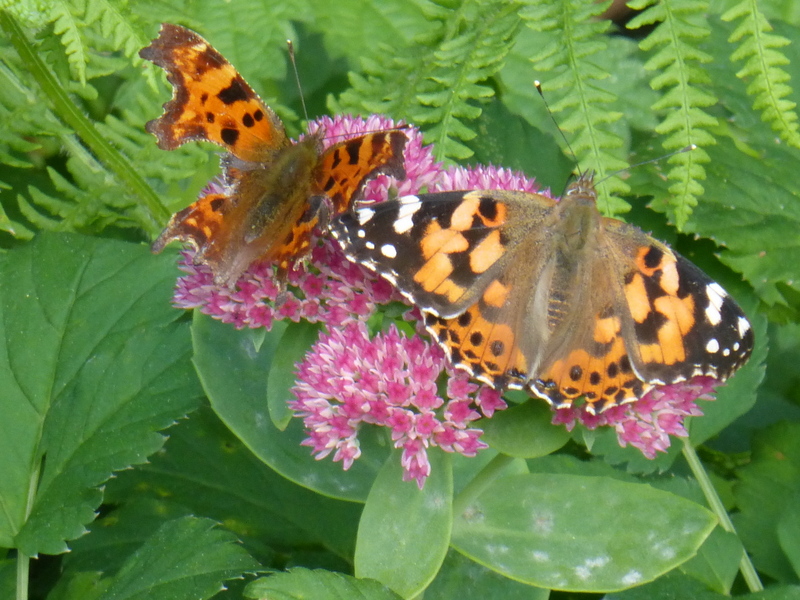
Small Tortoiseshell :-Still fairly decent numbers (63) seen in the County at 22 sites up to the 9th of October 2019 with the highest count of 10 noted on the 3rd of October 2019 on late flowering buddleia in Parwich (Ray Badger Walker). Interestingly this species has been quite scarce in most parts of the UK this autumn so it is great to know that they have had a successful flight/breeding period in this part of England as it bodes well for their appearance here next Spring.
Peacock :- Just 1 sighting of this species so far this month – at the Forge site in Ironville on the 2nd of October 2019 (Mark Searle)
Comma ;- Still flying on the 9th of October 2019 with a total of 131 individuals noted from 25 sites in Derbyshire so far this month including a massive 35 seen on flowering ivy on the 2nd of October 2019 at Pleasley Vale (Roy Frost)
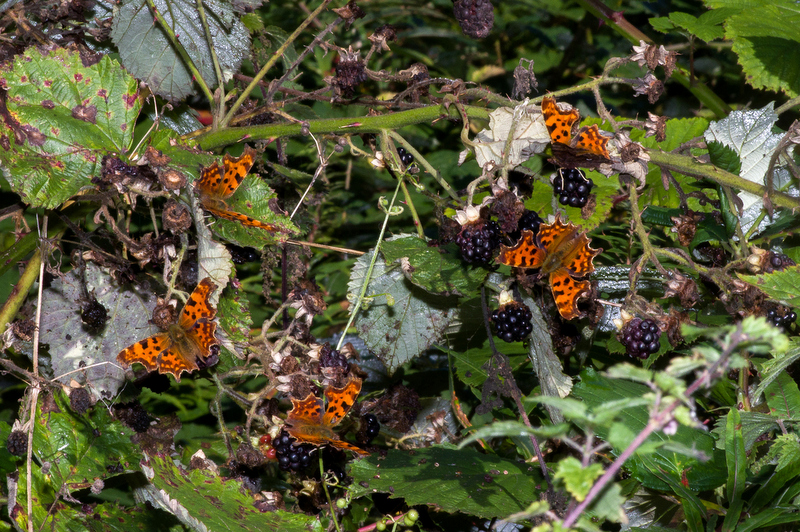
Speckled Wood :- Numbers have declined recently with only 26 butterflies seen at 11 sites across Derbyshire although individuals were noted on the 8th of October 2019 at Ironville (Pete Clark), Shipley Country Park (Jim Steele) and in Findern (Brian & Jean Hallam). The highest count of 10 came on the 2nd of October 2019 on the flowering ivy at Pleasley Vale (Roy Frost).
Wall Brown ;- Unfortunately a male of this species was seen on the 6th of October 2019 in the Two Dales garden of Peter Faulkner which is believed to be a third brood specimen although its condition was bright rather than superb mint – it could have been caught out in a shower earlier in the month of course. Be interested to know whether other individuals of the third brood ‘suicidal’ brood appear in the County during this month (latest County record is the 31st of October (1997) – one of the few remaining latest records for Derbyshire from the last Century!)
Small Heath :- Didn’t quite make October 2019 as the last sighting was on the 30th of September 2019 at Lightwood, above Buxton (Steve Orridge).
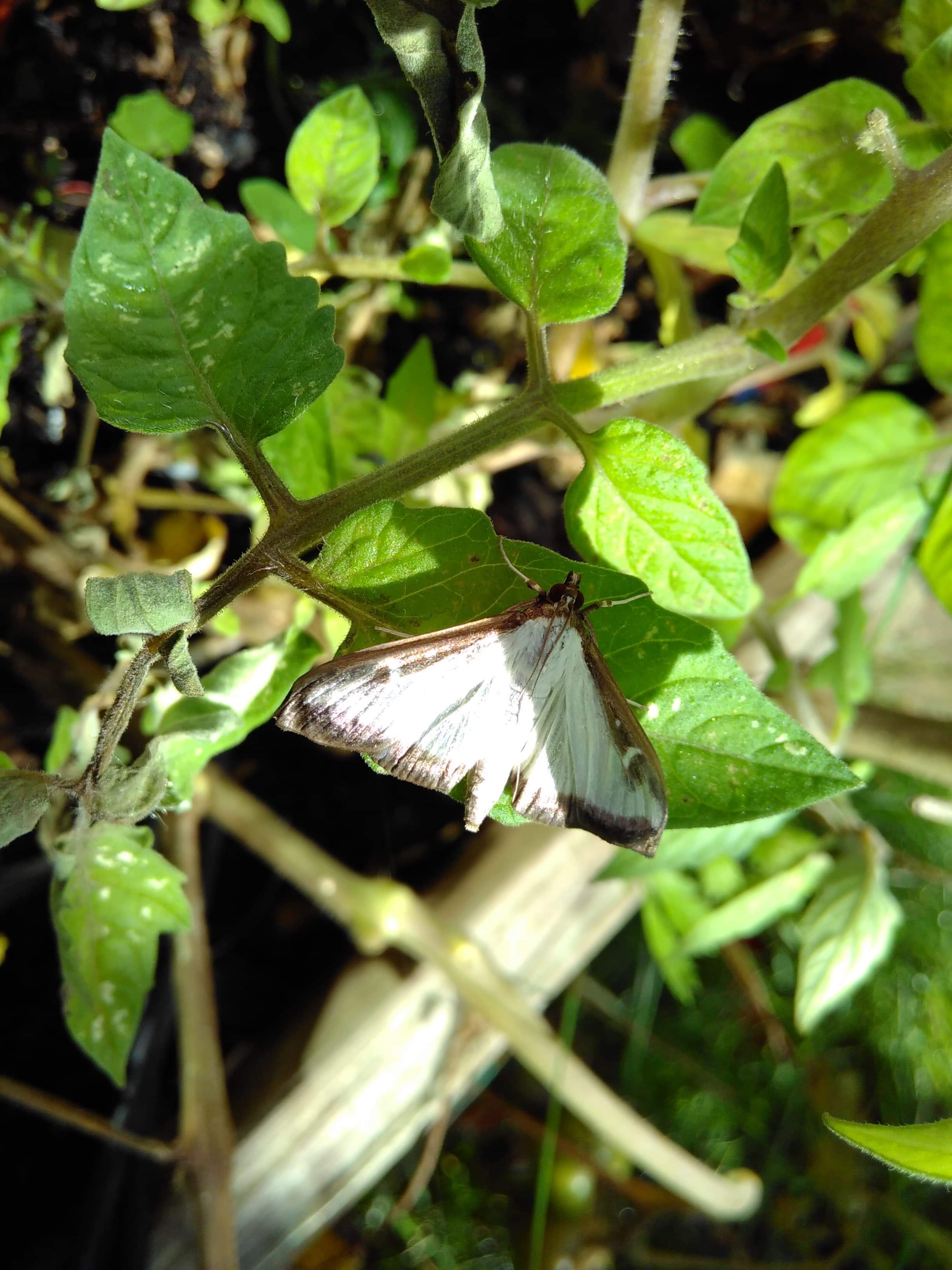
However the bad news is that the Box-tree moth has arrived in Derbyshire having been recorded in Leicestershire during 2017. An individual was seen and photographed by Sue Wood in Willington on the 8th of October 2019 (see the attached photo) – however another individual was caught in a moth trap in Findern on the 9th of July 2019 by Brian Hallam who was unable to get a photo at the time. Mick Ball tells me that the larvae feed solely on Box (buxus) and was imported into England from South-East Asia in 2007 and has started to spread northwards. It is a serious pest! Apparently this species over winters as a larva and they can survive down to -30C, so no problem in the UK. They become active from late March onwards and produce 3 - 4 cycles per year. The adults can be seen between May and October. The plant can survive if the bark of the main stem is not attacked. The larvae normally feed in webbing. There are no natural predators because of the toxins they contain!! You have been warned!
Finally many thanks to all the recorders who send me their excellent photos taken of butterflies and moths seen locally (see some more attached) – many recipients of these Updates comment on the quality of the material – so as to keep the interest alive during the dark and cold days of winter, it would be good to get some photos of Lepidoptera from other parts of the world where holidays are still a pleasant memory – I know for instance that one couple from Derbyshire are currently on holiday in Laos!
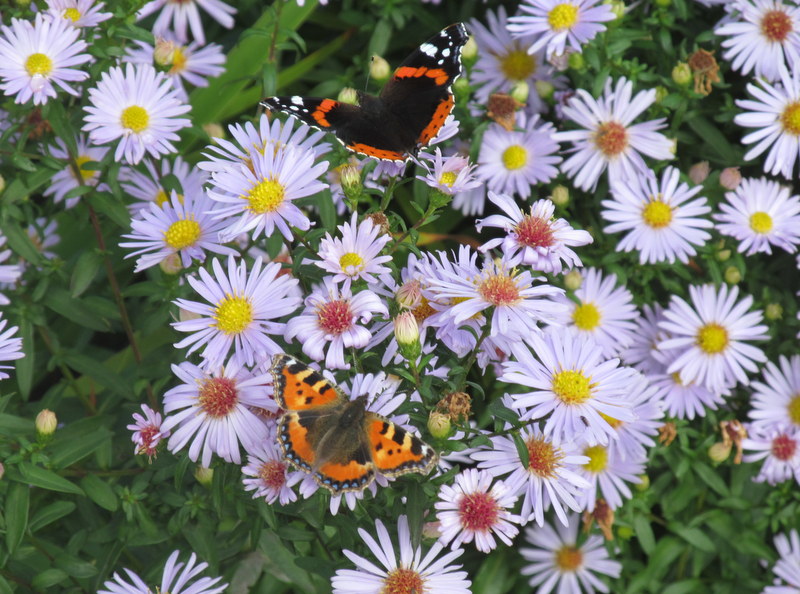
Update No 40
1st October 2019
Ken Orpe
News from Previous Years
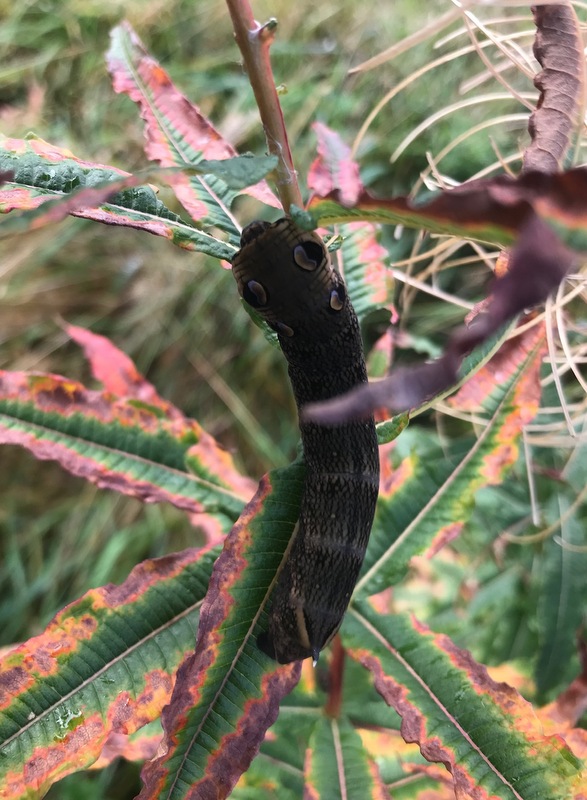
With a week of almost continuous rain, it takes a special determined group of volunteers to get out and about in the countryside in order to carry out Week 26, which was the final week of the butterfly transect season. Well that’s what happened at more than half of the 115 sites that were monitored here in Derbyshire during 2019, so a special thanks to all the 350 volunteers who took part again this year. Another great effort – if you have some record sheets that have not been sent to me yet could you please email them to me as soon as possible – many thanks in anticipation.
It hasn’t been a complete disaster on the butterfly scene since Update no 38 with a total of 17 species noted in the County recently with a summary of the species seen during the last 10 days as follows:-
Brimstone : -Just 4 recent sightings in the County with one at Kedleston Park on the 22nd of September 2019 (Nick Brown & Kath Patrick), one at both Brook Park, Shirebrook and at Markham Pit South (both David Shaw) on the 23rd of September 2019 and another on the same day at Pleasley Pit NR (Anita Aked).
Large White :- Still flying in the County up to and including the 30th of September 2019 (latest County record is the 1st of November (2015))
Small White :- Again still noted in the County as at the 30th of September 2019 (latest County record is the 10th of November (2015))
Green Veined White :- Last sighting received for this species so far this autumn was on the 28th of September 2019 at Poolsbrook C P (Abby Bruce) (latest County record is the 24th of October (2009))
Small Copper :- This species has not yet reached the high numbers of last year with only 21 sightings at 9 sites in Derbyshire recently – the highest count of 5 coming from Dene Quarry, Cromford Hill on the 23rd of September 2019 (Gary Atkins) whilst the last sighting was at Toyota Meadows on the 28th of September 2019 (Brian & Jean Hallam)
Brown Argus Migrating :- Just 1 recent sighting of this species on the 23rd of September 2019 along the Blackwell Trail (Mark Searle)
Brown Argus Peak District Race :- Just 1well worn individual noted recently on the 23rd of September 2019 in Chee Dale (Ian & Joy White).
Common Blue :-A general winding down of numbers with just 14 individuals noted at 8 sites recently with the highest count of 4 coming on the 23rd of September 2019 along the Blackwell Trail (Mark Searle) and the last sighting on the 28th of September 2019 at the Forge site in Ironville (Sally Fisher)
Holly Blue :- No further third brood sightings of this species recently.
Red Admiral :- Still being seen mainly on fallen fruit and the flowers of the ivy with 102 individuals being noted at 44 sites across the County with the highest counts coming from Cresswell Crags (16 on the 26th of September 2019 – Dianne Hibbert) and at the Evergreen Club, Allestree Park (12 on the 30th of September 2019 - Ken & Pat Orpe).
Painted Lady :- Still 5 individuals hanging on in the County with sightings from Pleasley Pit NR (Anita Aked), Hoe Grange Quarry (Alan Walker), Woodside NR (Jim Steele), and a couple seen on the 30th of September 2019 at both Markham Pit Seymour (Sid Morris) and in the Grassmoor garden of Brian Cuttell.
Small Tortoiseshell :- A total of 77 individuals were noted at 21 sites across the County recently with the highest count of 30 seen on creeping thistles in a field alongside a public footpath at Youlgrave on the 23rd of September 2019 (Fiona Keeling) and 8 seen on michaelmas daisies in the Two Dales garden of Stuart Slack on the 30th of September 2019.
Peacock :- Only 9 individuals noted in the County recently from 8 sites up to the 30th of September 2019 with the highest count of 2 coming from Carr Vale NR on the 25th of September 2019 (Anita Moore). Presumably the remainder of this species are safely tucked away in hibernation!
Comma :- Still quite widespread in the County with ripe fruit and the flowers of ivy attracting them before they too will enter hibernation. A total of 120 individuals were noted at 41 sites in Derbyshire recently with the highest count of 14 coming from Drakelow NR on the 25th of September 2019 (Tom Cockburn).
Speckled Wood :- Another species which is still widespread across the County with recent sightings of 207 individuals from 56 sites up to and including the 30th of September 2019 with the highest counts of 18 coming from Pleasley Pit NR (Anita Aked) and 17 at Whitwell Wood (Dot Alderton), both on the 23rd of September 2019.
Wall Brown :- Pleasingly no sightings of this species in the County during the last week of September 2019 as we don’t really want males of the third ‘suicidal’ brood to emerge now instead of next May as their chances of reproducing would be minimal if not nonexistent!
Gatekeeper :- This grassland species used to disappear by the end of August each year in the 1980’s but since then there have been sightings in the County almost every September with the latest Derbyshire record being the 27th of September (2016)).Indeed a singleton was noted this year on the 19th of September 2019 at the Peter Fidler NR in Carr Vale (per Mark Beevers) A response to this situation was received by me from Roger L H Dennis who tells me that the species is still univoltine in Southern Europe and he suspects that this sighting is simply part of the year’s single brood. Development can be delayed by the butterfly emerging from a particularly cool microhabitat (e.g.,, hollows on north slopes); the butterfly will also have a maximum lifespan as an adult of some 30 days too. A response to climate change may lead to an apparent extension of the flight period: populations may be much larger in warmer conditions and it is known that in such conditions, not only do butterflies emerge earlier but seem to be on the wing longer; the implications are of greater genetic variability with the increase in population numbers, one element of which may be longer life spans. With larger populations and warmer conditions, more individuals are likely to be placed in cooler micro-habitats, thereby delaying development, especially if development is interrupted at key points.
Meadow Brown :- A late sighting of this grassland species was noted on the 23rd of September 2019 at Hartshorne Wood (Brian & Jean Hallam). The reason for the late appearances of this species in Derbyshire (latest County record is the 10th of October (2017)) was explained in Update no 34 dated the 14th of August 2019.
Small Heath :- A late sighting of this grassland species, which prefers a short sward and is thus mainly confined to the Peak District and Brownfield sites in Lowland Derbyshire, was made on the 25th of September 2019 at Drakelow NR (Tom Cockburn) – the latest County record is the 14th of October (2003))
Moving on to migrant moths, here have been 5 recent sightings of the Humming Bird Hawk moth in the County with records from Higham (Louis Heath), Hognaston (Carline Wheeler), Duffield (Keith Hall), Parwich (Saskia Tallis), and finally on the 25th of September 2019 in Grassmoor (Brian Cuttell), Interestingly the sightings at both Hognaston and Parwich on the 24th of September 2019 were of individuals hovering over flowers in heavy rain – they are certainly more hardy than what we think they are. (Some photos attached of recently seen rare moths and caterpillars).
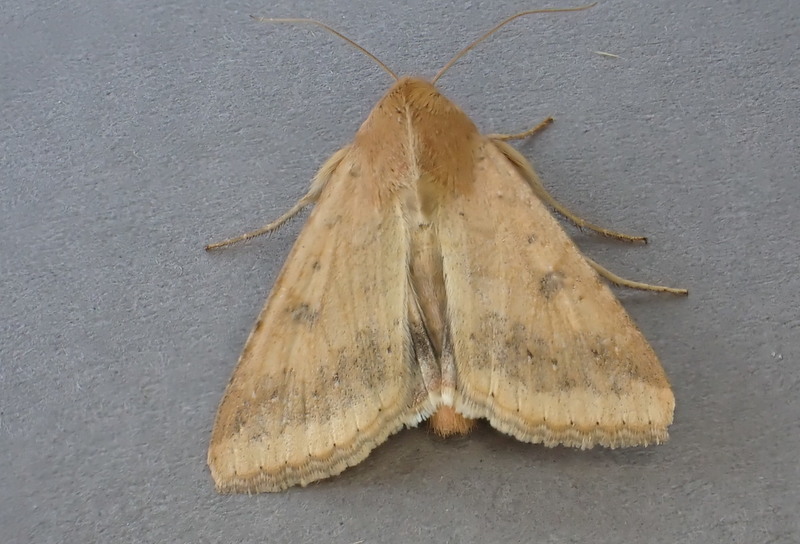
Although the moth watch in Hoe Grange Quarry last Saturday night (28th of September 2019), which was part of National Moth Night, didn’t produce any sightings of the Clifden Nonpareil, it did produce a sighting of the rare immigrant moth, the Scarce Bordered Straw. (see attached photo).Mick Ball tells me that ‘It is a rare immigrant that occurs during September and October and there was a massive influx during 2006. There have been very few, if any, records since then. This is a very significant record for the County and a great record for Hoe Grange Quarry which has turned up some brilliant finds’. Another moth seen on the night was the striking Merveille Du Jour moth of which 5 were seen of this predominately oak woodland moth.
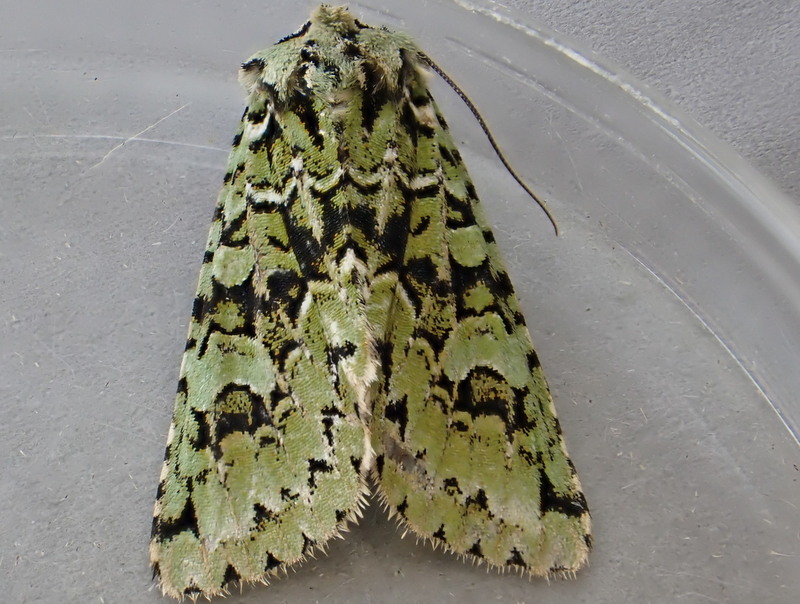
Well worth doing a moth trapping session last Saturday night and many thanks to Steve Orridge and Ray Badger Walker, together with others who turned up in far from ideal weather conditions – you never know what might turn up on the night!

Update No 38
23rd September 2019
Ken Orpe
News from Previous Years
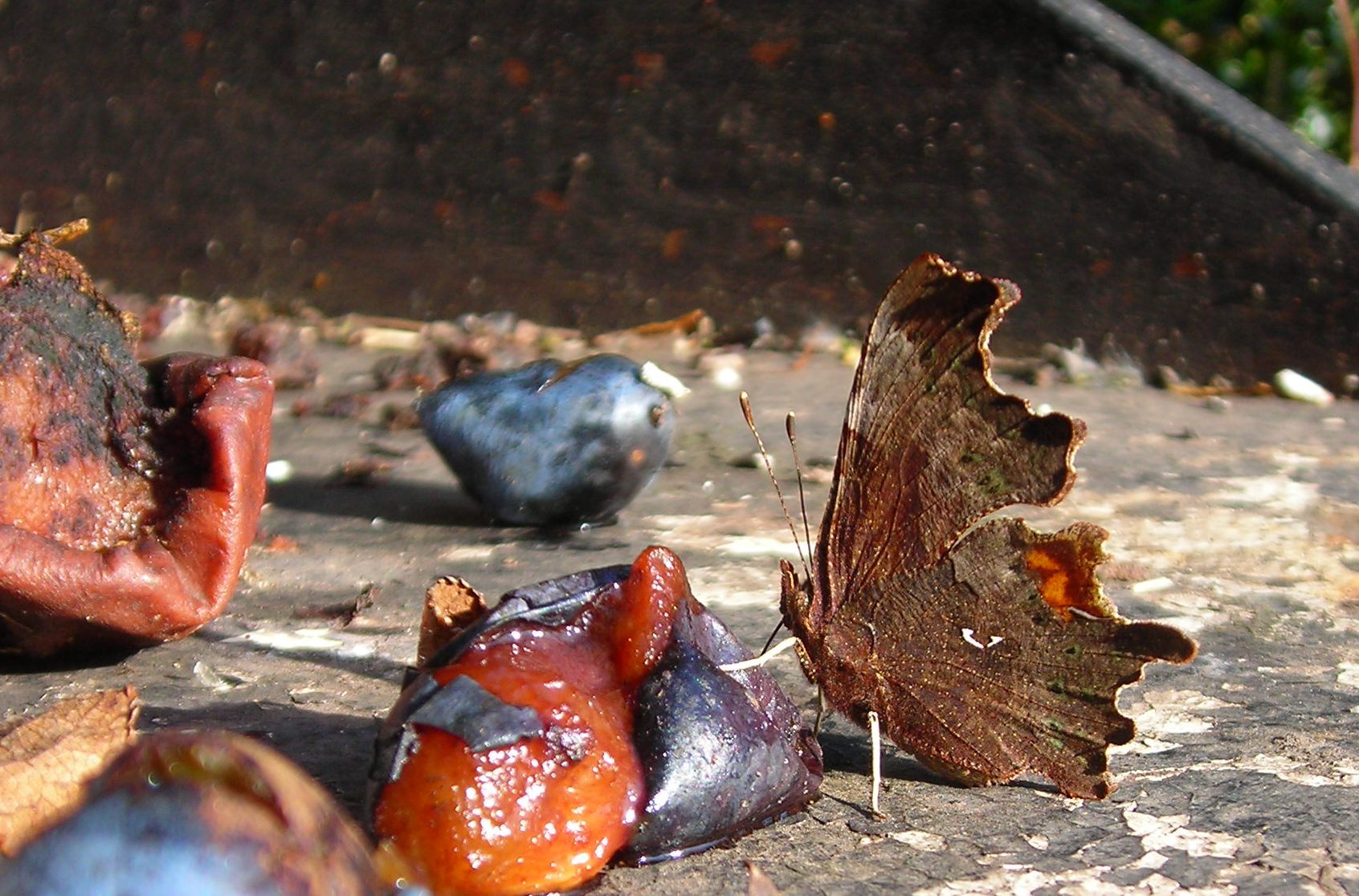
After a couple of decent weeks for the middle of September, it looks like the Autumn Equinox has changed the weather pattern and the strength of the Jet Stream so that the ‘normal weather’ service will be resumed although the reservoir levels in Derbyshire are currently high with Carsington Water at 95% full and the Derwent Dams averaging 82% full. So it is no wonder that our County was third in the league table of areas of high rainfall this summer behind both Northumberland and Cheshire.(remember Whaley Bridge??)
At least Weeks 24 & 25 of the transect season produced some good counts at many sites although this week (Week 26) looks to be more challenging.
The numbers of Small Tortoiseshells continue to surprise and excite recorders with counts in excess of 20 individuals being noted across the County mainly on late flowering buddleias, with maximum counts being 50 at Hatton (Ken & Pat Orpe) and a massive 200 seen on scabious on the hillside above Middle Hey in Cressbrookdale (Chris & Sheila Ragg).What is even more remarkable is that according to information from Dennis Dell there have been hardly any of this species seen in Hants and Sussex this summer – was it too hot for them down there?

Fortunately the Painted Lady is still showing herself in reasonable numbers in the County with over 340 individuals seen at 120 sites with the highest count of 13 coming from Ironville (Pete Clark) together with 11 seen at Barrow Hill (Paul Townsend), 8 on buddleias at Burnaston (Jean Lemagnen), whilst Mike & Mavis Allen saw an individual in Oslo on the 21st of September 2019 so they have not started their mass migration south just yet! It was interesting but not surprising that the Painted Lady butterfly was the most noted species under the 2019 Big Butterfly Count that took place in late July and into August this year - here in Derbyshire it has certainly been a Painted Lady year with the highest number seen so far since the start of the New Millennium.
Pleasingly a few Clouded Yellow butterflies have shown up locally with individuals noted at Mapleton on the 15th of September 2019 (Dan Harrison) together with one at Mickleover on the 19th of September 2019 (Colin Bowler) and another noted in Hardwick Park on the 20th of September 2019 (Ian Hunt). Again a few Humming Bird Hawk moths have been noted in the County recently with sightings at Broomfield Hall College (Seth Grimes per Paul Foskett), The Thack Pub garden in Riddings (per Pete Clark), Leabrooks garden of Helen Naylor, in Parwich village (Ray Walker), at Gnat Hole Farm, Glossop (Marc Whitlock) and finally on the 21st of September 2019 at Barrow Hill (Paul Townsend).
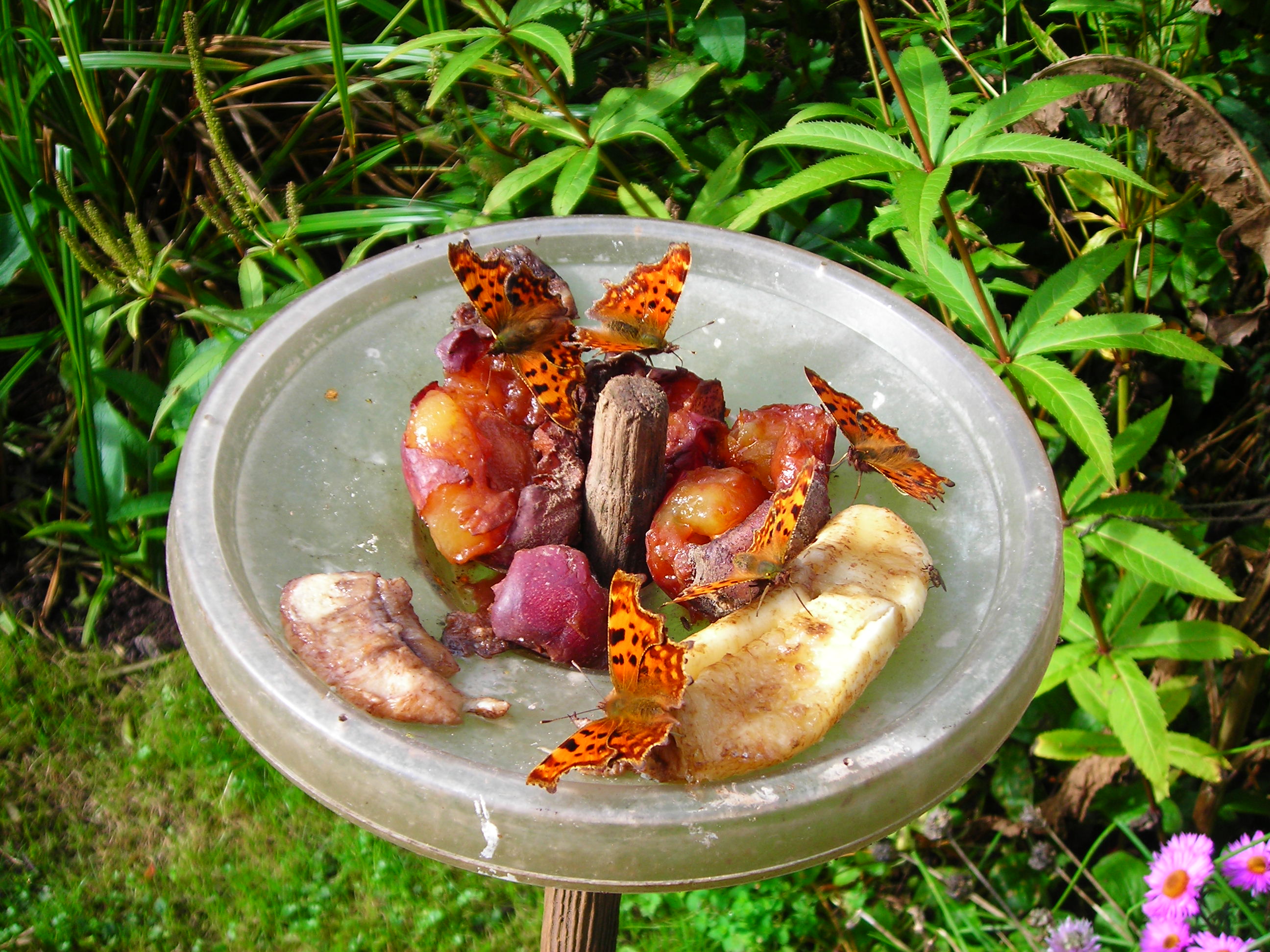
Numbers of Red Admirals are certainly increasing with late flowering buddleias, fallen fruit and flowering ivy plants being their main source of sustenance with the highest counts coming from Barrow Hill (32 – Paul Townsend), Allestree (26 – Sally Galloway),Bradwell (21 – Sally Pereira), Findern (20 – Brian & Jean Hallam) and on Grin Low, Buxton ( 20 – Janine Morris). Similarly Commas are showing well in the County with the highest count of 12 coming from Spring Wood, Unstone (Peter Walker), Creswell Crags (Brendon Betts) and at Williamthorpe (Willy Lane). However Peacocks are keeping a low profile with only ones and twos being seen on occasions and the recent highest count of 6 came from the Bradwell garden of Sally Pereira. The other species to hibernate, the Brimstone, is again mainly in hiding now as it is usually the first to disappear until the early sunny days in March next year. However an individual seen by Nick Brown and Kath Patrick feeding on sedum in their Langley Common garden was an unusual sighting – if you want to try and attract more butterflies into your garden this autumn then why not create a bowl of ripe fruit or even try the banana trick that was perfected by Dan Martin in recent years (see the attached photos for ideas!)
Moving on to the ‘blue’ family of butterflies, the expected increase in numbers of Small Coppers has failed to materialise with only one count into double figures at Lathkill Dale on the 18th of September 2019 (15 – Chris Ragg) and then 6 at Lightwood in Buxton (Shirley Johnson). Both the Common Blue and Brown Argus are just hanging on although poor weather forecast for most of this week could ensure the end of their flight period for this year. An interesting observation was made by Liz Wheeldon in Lathkill Dale on the 17th of September 2019 when a Common Blue was seen in cop with a Brown Argus (see attached photo) – unfortunately all the energy expended will be a waste of time and effort as there will be no resulting offspring.
Last sightings for very worn examples of the Brown Argus are as follows :-
18th of September 2019 – Migrating version noted at Seymour site, Markham Pit (Sid Morris)
20th September 2019 – Peak District version noted in Tansley Dale (Gordon Rooke)
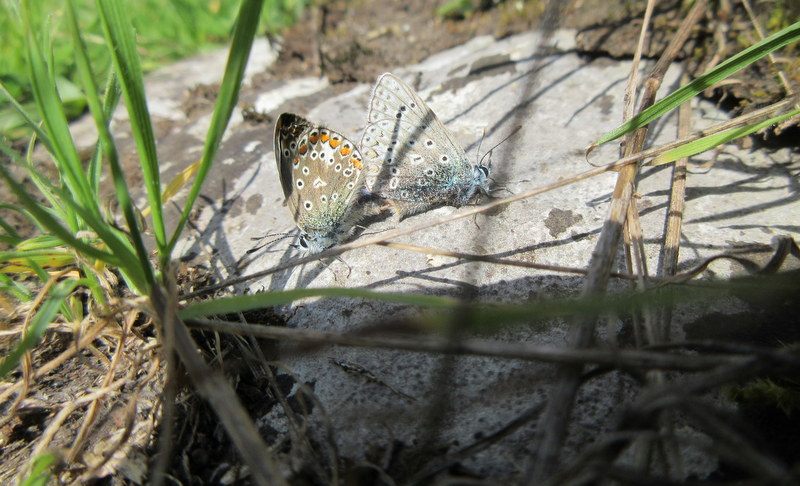
Fortunately there have been a dozen recent sightings of the Holly Blue across the County which suggests that a third brood is now in full swing – areas include Whaley Bridge (Angie & Alan Seymour), Buxton (Ian & Joy White), Over Haddon (Janet Wheeldon), Stoney Wood, Wirksworth (Ellie Rickman), Creswell Crags (Peter Ham), Pleasley Pit (David Elliott), Williamthorpe (Willy Lane), Broomfield College (Paul Foskett) and Little Eaton Canal (Celia Reid).
As usually occurs in the Autumn, the multi brooded Speckled Wood is now showing well across the County with the highest counts coming from Williamthorpe (47 – Willy Lane), Pleasley Pit (32 – Ian Hurst), Chee Dale (27 – Helen Waterman),Bunsall Cob, Goyt Valley (25 – Tony Pioli) and in Lathkill Dale (21 – Liz Wheeldon).
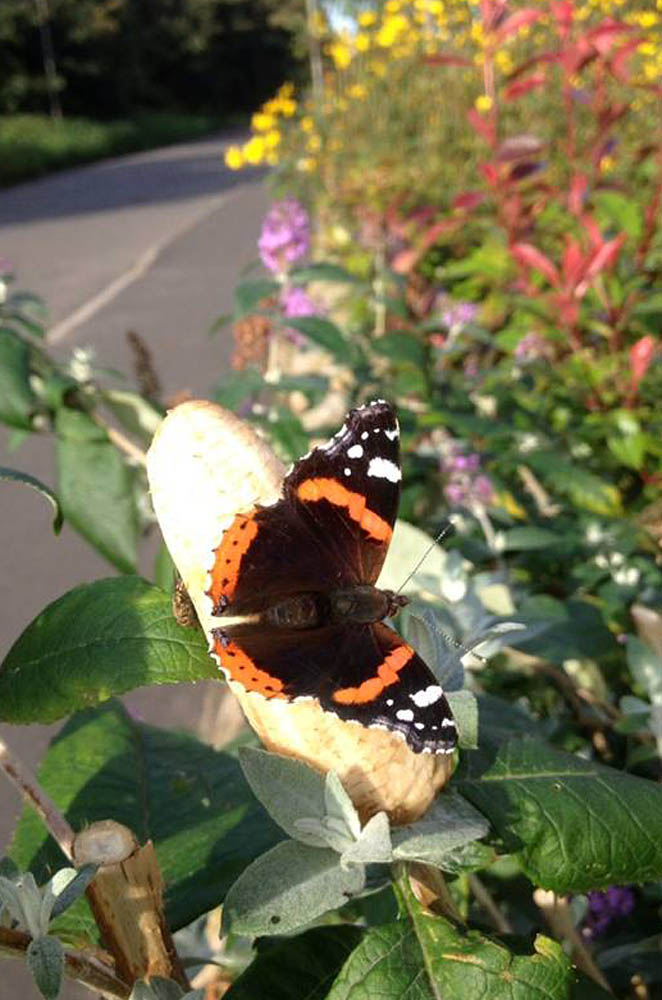
Pleasingly the Wall Brown has had a good year here in Derbyshire and during the last couple of weeks sightings have been made of 40 individuals, mainly ones or twos, at 25 sites in the Peak/Peak Fringe areas as its flight period nears its end. On a visit to one of its strongholds at Hoe Grange Quarry on the 19th of September a number of visitors were pleased to see both male and female singletons on site with the latter being seen carefully studying ledges and small depressions on the cliff faces which is where they lay their eggs on grasses these days. Whether or not the species produces a third ‘suicidal’ brood remains to be seen but any fresh males noted at its main strongholds such as Longstone Edge, Millers Dale, Lathkill Dale, Chee Dale, Cressbrookdale or obviously Hoe Grange Quarry will be greatly appreciated – a no show is equally important to note if you do decide to visit any of these sites in the near future!
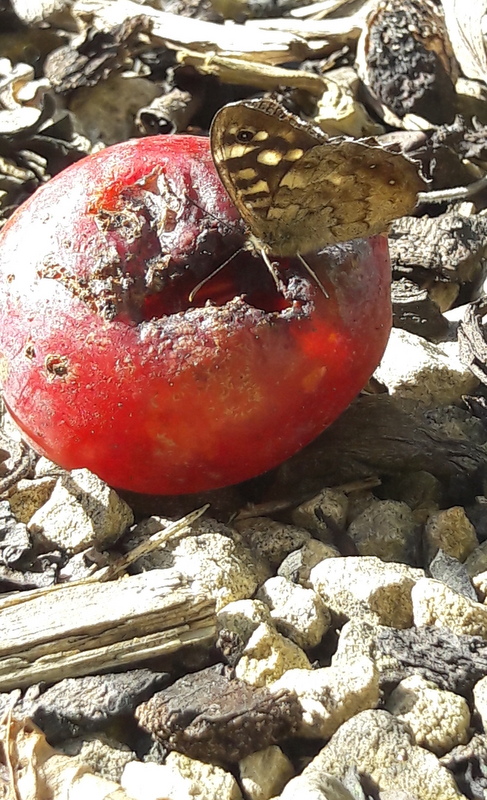
Update No 37
7th September 2019
Ken Orpe
News from Previous Years
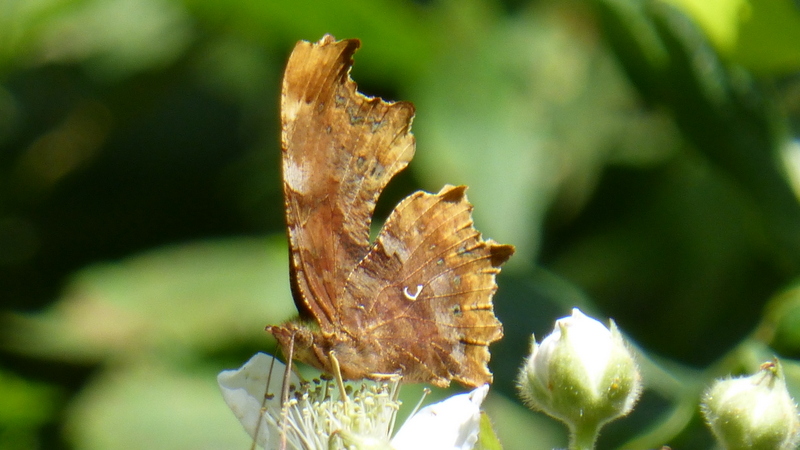
As often happens, a change of month means a change of weather and the last week has certainly got a feel of autumn about it! With a cool north west wind predominating it was feared that the Painted Lady butterflies would take advantage of ideal conditions for them to attempt to get back to North Africa – but no, many have decided to stay put for the time being which has resulted in over 350 butterflies noted in the County so far during this month at 90 sites across Derbyshire with the highest counts coming from Hoe Grange Quarry (22 – Alan Walker), Markham Pit Seymour
(16 – Sid Morris) and in Deep Dale, Sheldon (15 – Steve Orridge). A welcome return to good numbers of Red Admirals being seen recently with 17 individuals seen at both Brook Park, Shirebrook (David Shaw) and at Forbes Hole, Long Eaton 9Marion Bryce & Derek Brumbill) and the highest count of 47 seen on the 2nd of September 2019 taking nectar from devils bit scabious which is still in flower at Grin Low (Bob Billing). With ripe fruit being on their menu (especially plums) it bodes well for the Red Admiral to have a successful autumn and hopefully will allow many of them to over winter in our County as well.
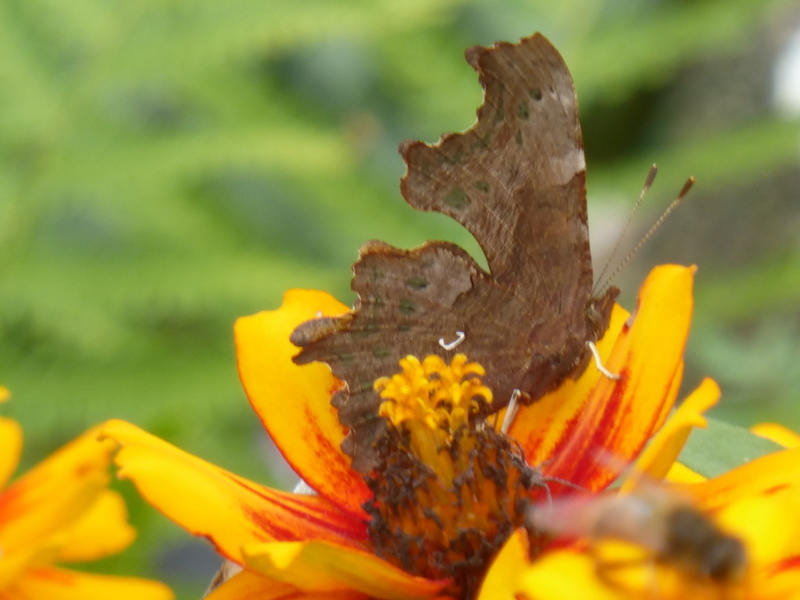
A couple of migrant Humming Bird Hawk moths were noted on buddleias on the 30th of August 2019 with an individual noted at Middleton by Wirksworth (Dave & Sue Evans) and another seen in the Allestree garden of Bill Grange where Steve Plant got a great photo of it (see attached)
Also a couple more Clouded Yellow butterflies were noted recently with one seen by Dan Bound on the transect at Denby Pottery on the 26th of August 2019 another noted on the transect at Broomfield College on the 4th of September 2019 (Mike & Julie Ireland).
Pleasingly the Small Tortoiseshell has been seen in good numbers this last week with many noted hanging on to buddleia fronds during the strong winds that prevailed – highest counts coming from South Derbyshire with 20 seen at both Thurvaston (John Abrehart)and Repton (Ken & Pat Orpe) with the highest count of 26 noted on the buddleias in the garden of Kedleston Hall on the 3rd of September 2019 (Ken & Pat Orpe). The new brood of the Comma butterfly has also been showing with 5 seen in Allestree Park (Steve Plant) and 6 noted in Clover Close, Elvaston Park (Mike & Julie Ireland). What is interesting about this new brood of the Comma is that the underside is very dark so that it will have good camouflage during its winter hibernation, whereas in some of the midsummer brood the underside is quite golden and attractive (hutchinsoni - see attached photos for the difference)
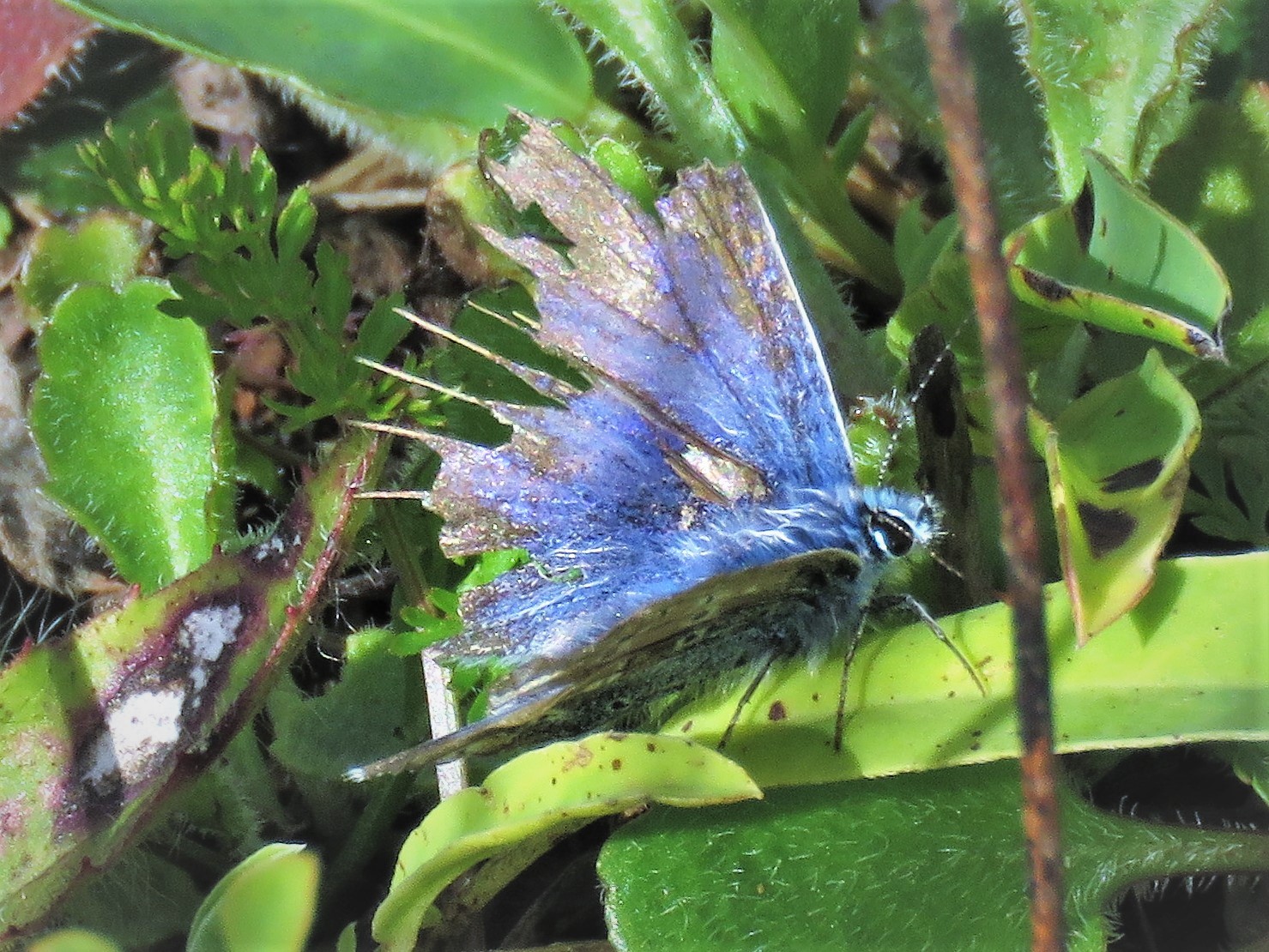
So what species have not been seen in the County so far this month? Well, no sightings of the 2 fritillaries have been received (Silver Washed and Dark Green), no sightings of the Skippers, Hairstreaks or Ringlets – with both the Gatekeeper and Meadow Brown just hanging on in there. Also numbers of the Peacock have declined dramatically, especially in Lowland Derbyshire, so we can only hope that they are now tucked up in hibernation out of harm’s way (spiders and birds being their main threats).
Other recent records of interest include;-
Small White :- The Rowthorne Trail still has a good number present with 88 seen on the 2nd of September 2019 (David Elliott).
Small Copper :- Still not common with the highest count of only 5 coming from Hoe Grange Quarry on the 2nd of September 2019 (Max & Christine Maughan)
Holly Blue :- Just odd ones seen so far in September 2019 with the highest recent count coming on the 30th of August 2019 at Creswell Crags (Dianne Hibbert).
Common Blue :- Some good recent counts coming from the Markham Pit area of North East Derbyshire with 73 seen at Markham Pit South (Mark Radford) and 89 noted at nearby Markham Pit Seymour (Sid Morris). (see attached a remarkable worn specimen photographed by Ian Hurst)
Brown Argus – Migrating and Peak Race – Both species have managed to make it to September 2019 so any additional sightings would be appreciated
Speckled Wood :-Beginning to get its act together now with the highest counts coming from North East Derbyshire including 26 at both Staveley/Inkersall (Sid Morris) and also at Pleasley Pit (John Kirby), together with 27 at Carr Vale NR (Anita Moore) and 28 at Williamthorpe (Willy Lane)
Small Heath ;- A massive count of 88 individuals were noted at Arkwright Tip on the 1st of September 2019 (Mark Radford) which just illustrates how important these ‘brownfield’ sites are for our local Lepidoptera.
Finally an Update from Derbyshire wouldn’t be complete without a note on the current status of the Wall Brown in the County. Whilst the cold north west wind is not ideal for this lover of warm, rocky outcrops on the 1,000 foot contour, a great site in a quarry which offers protection from the worst of the weather more than makes up for the species – hence Hoe Grange Quarry came up trumps yet again with 12 noted on the transect there on the 2nd of September 2019 (Max & Christine Maughan). In addition the species was noted at another 16 sites across the Peak/Peak Fringe areas with a total of 46 additional butterflies seen including 5 noted in the sheltered old railway cutting on the Tissington Trail near Parsley Hay (Derek & Iris Martin)
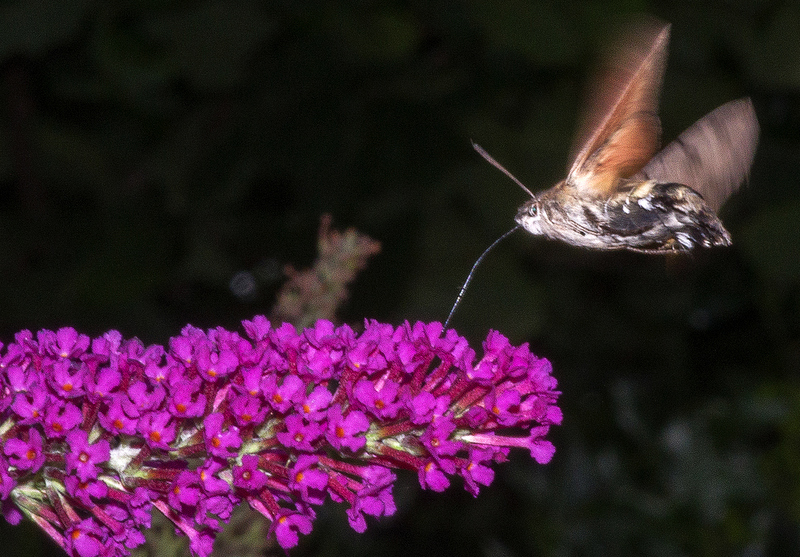
Dragonflies
I mentioned in Update no 31 that Chris Bradbury of Mansfield has taken over the role as Dragonfly Recorder for both Notts and Derbyshire so I asked Chris to do a quick resume of his details so that you can send your sightings to him direct. He has responded as below:-
I am now the County Dragonfly Recorder for Notts and Derbyshire,and would like to build a stronger recording team, for both regular and casual observers.
The British Dragonfly Society uses iRecord to collect and review records.
It is simple to use and allows recorders/me to quickly assess and accept or reject the sighting.
Photos are preferred for any unusual species away from normal range, to ease the process.
Some may not be accepted without photographic evidence.
Please log in to allow the system to recognise you and build a profile of your skills, based on previous successful submissions. Records are currently reviewed within the same week.
If you're not sure of identification, please send photos to my email address.
I will be sending occasional newsletters and creating a Facebook page soon, to share information faster.
I am approachable and friendly if you should need any help or advice.
Chris Bradbury
BDS@chrisbradbury.com
07544 141 317
01623 391 297
Good luck Chris – be good to have some Newsletters on Dragonflies for the Region.

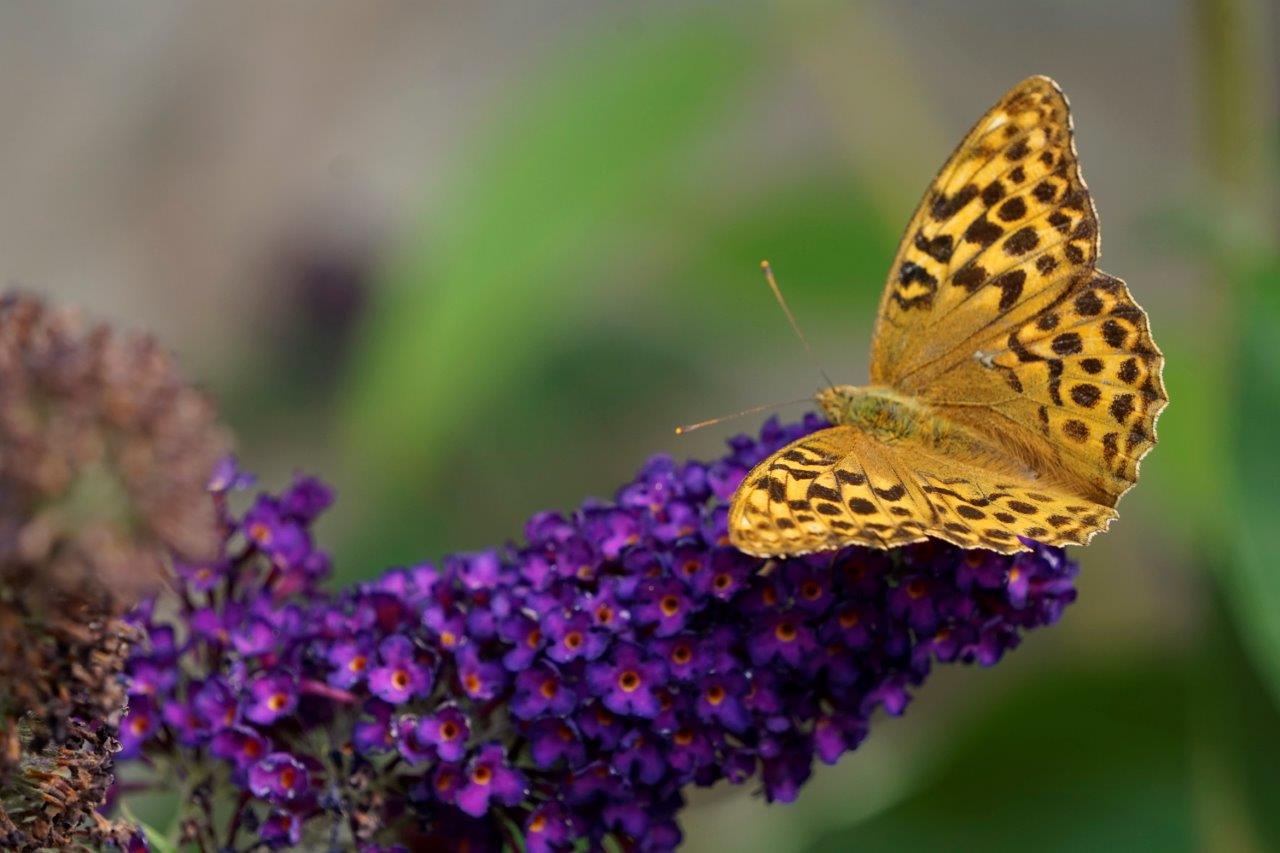
Update No 36
30th August 2019
Ken Orpe
News from Previous Years
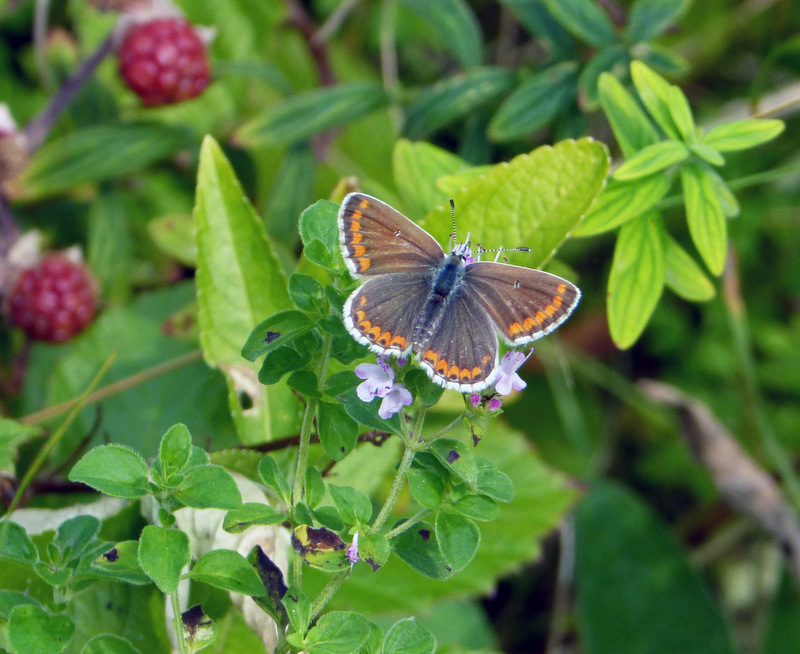
After an unprecedented period of hot and sunny weather over the Bank Holiday weekend, it was great to be able to get out and enjoy the conditions whilst carrying out the butterfly transects and without worrying about the weather constantly changing! So it comes as no surprise that a couple of Clouded Yellow butterflies have been seen recently – one by Sid Morris on the 29th of August 2019 at the Markham Pit site which is situated alongside the M1 motorway (this route was certainly used by the Clouded Yellows in the year 1983 which was the last ‘proper’ Clouded Yellow year in the county), together with another on a fast mission moving through the grounds of Broomfield College in Morley on the 30th of August 2019 (Paul Foskett). Also recent sightings of the migrant Humming Bird Hawk moth have been noted at Grassmoor (Brian Cuttell), at Bradwell (Sally Pereira).and around Dene Quarry on Cromford Hill (Kevin & Hilary McKay)
The hot weather has also ensured that new broods of both the Common Blue and Brown Argus have appeared in the Peak District – however even more of a surprise was the appearance of a second brood Dingy Skipper on the 23rd of August 2019 in the Northwood, Darley Dale garden of Chris & Sheila Ragg – who managed to photograph it (see the attached) as it was in such very poor condition which suggests that it probably emerged during the last hot spell towards the end of July 2019 but it got caught out in the wet weather during the middle of August 2019 – hence its current condition.

The possibility of the meet up of the 2 species of Brown Argus in the County on the Cromford Hill area was also confirmed when Alan Walker photographed a mint specimen with a full set of orange lunules on the 27th of August 2019 at the National Stone Centre during his transect there (see the attached photo).
Other recent records of interest include :-
Brimstone :- Becoming slightly more common with the maximum counts coming from the dales – 14 in Tansley Dale on the 22nd of August 2019 (Gordon & Alison Rooke) and 11 in Lathkill Dale on the 24th of August 2019 (Chris & Sheila Ragg)
The Whites :- A massive count of 238 individuals seen by David Elliott on the 26th of August 2019 on the Rowthorne Trail consisting of 36 Large Whites, 178 Small Whites; and 24 Green Veined Whites;
Purple Hairstreak :- A late individual seen at the Avenue Washlands NR, Wingerworth on the 23rd August 2019 (Phil Gilbert).
White Letter Hairstreak :- Just a couple of late sightings from the Peak District – in the Buxton garden of Ian & Joy White on the 24th of August 2019 followed by another (fresh) specimen in Coombs Dale on the 26th of August 2019 (Tony Pioli) – see the attached photo..
Small Copper :- Becoming more widespread across the County with the highest counts coming from the Peak District – 11 on the 27th of August 2019 at Lightwood, Buxton (Steve Orridge), 12 around the Dene Quarry complex on Cromford Hill on the 26th of August 2019 (Martin Cobham) and 13 seen in Lathkill Dale on the 24th of August 2019 (Chris & Sheila Ragg).
Brown Argus Migrating :- Highest count in Lowland Derbyshire came from Drakelow NR on the 23rd of August 2019 where 12 individuals were noted by Andy Large.
Common Blue :- Numbers are increasing at especially brownfield sites across Lowland Derbyshire with the maximum count of 56 coming from Markham Pit Seymour site on the 23rd of August 2019 (Dave Wood) followed by 41 noted at the Forge site in Ironville on the 24th of August 2019 (Sally Fisher et al)
Holly Blue :- The maximum count of 5 has come from both Creswell Crags (Peter Ham) and the Elvaston garden of Mike Tong on the 24th of August 2019.
Red Admiral :- Although increasing in numbers at the moment, maximum counts haven’t reached the massive numbers of 2017 yet but with a count of 26 on the Rowthorne Trail (David Elliott) and 38 noted at Grin Low (Shirley Johnson) the future looks to be encouraging for this species which now over-winters here in Derbyshire.
Small Tortoiseshell :-New brood numbers are certainly increasing in Lowland Derbyshire with the recent maximum counts being 21 noted at Draycott (Roger Martin) and 25 seen at Willington Gravel Pits (Chris Perry) – all of which were seen on buddleia bushes.
Peacock :- The same buddleia bushes in Lowland Derbyshire are now mainly devoid of Peacocks who appear to have entered hibernation in the area ( must be nice to avoid most of the weather conditions that mother nature sends us from now till March!) – but numbers remain high in parts of the Peak District with the highest recent counts coming from Coombs Dale (50 – Rob Foster), 52 at Grin Low, Buxton (Steve Orridge), 62 in the Bradwell garden of Sally Pereira) and 71 in Lathkill Dale NNR (Chris & Sheila Ragg)
Comma :- Not so common at the moment although a new brood can be expected to emerge very shortly with ripe fruit and flowering ivy being plants that they are particularly partial to in the autumn ( which starts this Sunday according to the Met Office).- the highest recent count of 8 came from Grin Low, Buxton on the 27th of August 2019 (Shirley Johnson).
Dark Green Fritillary :- More or less at the end of its flight period in the Peak district but a count of 7 on the 26th of August 2019 by Gordon & Alison Rooke in Tansley Dale was a pleasant surprise.
Speckled Wood :- Still yet to achieve large numbers but on the increase in Lowland Derbyshire with recent counts of 20 along the Chesterfield Canal at Hollingwood/Brimington (Sid Morris), 22 along the Clowne Linear Park (Dave Fenton) and 23 at the Manor Farm LNR, Long Eaton (Marion Bryce).
Both Meadow Browns and Gatekeepers are managing to hang on at the moment but it looks like the flight period of the Ringlet is now over in the County, but the Small Heath is still around in low numbers at some of the brownfield sites in Lowland Derbyshire but it is still doing okay in the Peak District with a recent count of 58 on the 27th of August 2019 along the old rail track in the Goyt Valley in the far North West of the County (Tony Pioli).
Also the summer skippers are nearing the end of their flight period for this year with late sightings on the 26th of August 2019 of the Large Skipper in Chee Dale (Cate Beck et al) and on the 27th of August 2019 the Small Skipper was noted at Lightwood, Buxton (Steve Orridge) and in Lathkill Dale NNR (Peter Faulkner)
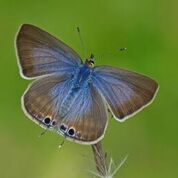
There are currently 3 butterfly species in the County that are showing no signs of the letting up as we approach autumn – these being the Wall Brown, Painted Lady and the Silver Washed Fritillary although some examples of the latter species are certainly showing some wear! In fact individuals of the Silver Washed Fritillary have been seen up to and including the 27th of August 2019 at both Lathkill Dale NNR (Peter Faulkner and Chris & Sheila Ragg) and along the old rail track in the Goyt Valley (Tony Pioli). A further 12 specimens have been noted recently in ones and twos at Botany Bay near Linton (Malcolm Giles), in a garden in Hilton (Pat Orpe), at Kilburn (Stuart Slack), in Belper (per Doug Aston), in a garden at Wakebridge (Fred & Gill Dyson), in Tansley Dale (Gordon & Alison Rooke) together with sightings in the North East of the County at Scarcliffe village and near Langwith Wood (both Jim Russell) and today (30th of August 2019) in Whitwell Wood where Andy Taylor of the Forestry Commission saw both a normal form together with a Valezina form at the same location - although these latter sightings could be as a result of earlier releases but the species is probably breeding at that site. Further afield another individual was seen recently in Romiley, Cheshire (Peter Hardy per Roger Dennis)

Most observers in the County who have buddleia bushes in their garden have probably seen the Painted Lady on them this year and during the last 7 days a further 620 individuals have been noted across the County from 115 sites with the highest counts coming from the buddleia bushes on waste ground around Willington Gravel Pits where Chris Perry counted 40 on the 27th of August 2019 whilst in the Peak District Dave Mallon counted 60 individuals over the Bank Holiday weekend including 21 at Hindlow, and Rod Dunn noted 12 individuals at Blackden Brook on top of Kinder Scout on the 24th of August 2019.
Pleasingly the Wall Brown has been showing itself mainly at rocky outcrops in the Peak District where over the Bank Holiday Weekend Dave Mallon saw 73 individuals at 13 sites including 22 at Hindlow! Overall the total number seen in the County during the last 7 days comes to 160 individuals from 30 sites including the Peak Fringe areas of Thorpe (Barbara Wager), Crich Stand Quarry (Keith Hall), Lea Gardens (Keith Hall) and Northwood, Darley Dale (Chris & Sheila Ragg). Surprisingly another Wall Brown was seen along the Chesterfield Canal in the Hollingwood/Brimington area (Sid Morris) so it is certainly trying to regain some of its former territory in Lowland Derbyshire.
With 20 butterfly species noted in both Lathkill Dale NNR (24th of August 2019 – Chris & Sheila Ragg) and in Tansley Dale
26th of August 2019 – Gordon & Alison Rooke) and with 312 butterflies seen on the transect at the Rowthorne Trail (26th of August 2019 – David Elliott) have we now seen the peak of the butterflies in the County – as usual, only your sightings and transects will confirm this situation.
Finally, Chris Butler has sent me a link to an interesting article on the mass arrival of the Long Tailed Blue into the southern part of the UK.
Climate change causes invasion of Mediterranean butterfly in the UK BBC Wildlife Magazine
Record-breaking numbers of long-tailed blue butterflies have been seen in the last few weeks. Read the full story
Whilst the species is not expected to reach us here in Derbyshire, it did appear in August 2013 when Alan Kitchen in his garden in Matlock saw and photographed a Long Tailed Blue. The butterfly was a female and was seen by Alan ovipositing on the flower buds of perennial sweet pea – an amazing sight in a garden in Central Derbyshire. It could of course been imported in foodstuffs from the Continent, lentils and peas being the most common. Nevertheless it was another ‘once in a lifetime’ experience for a butterfly recorder here in Derbyshire (photos attached of the species). So you never know what to expect!
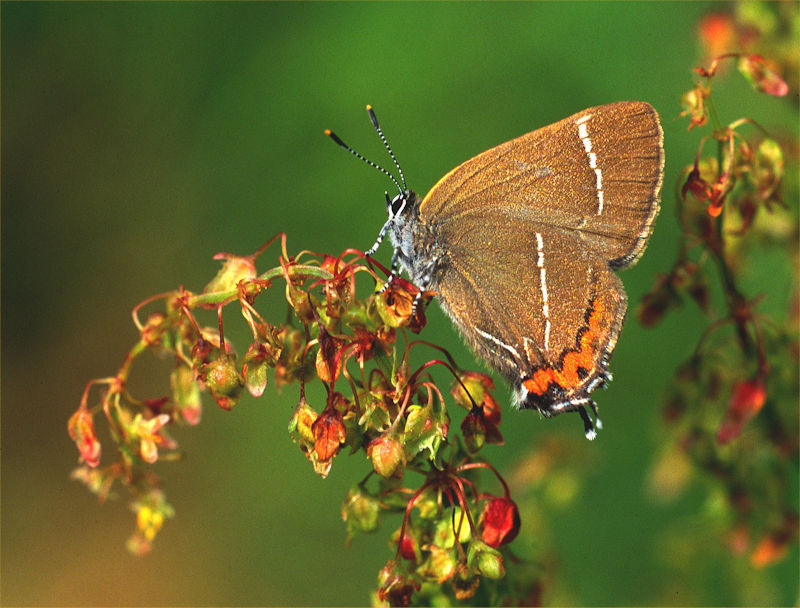
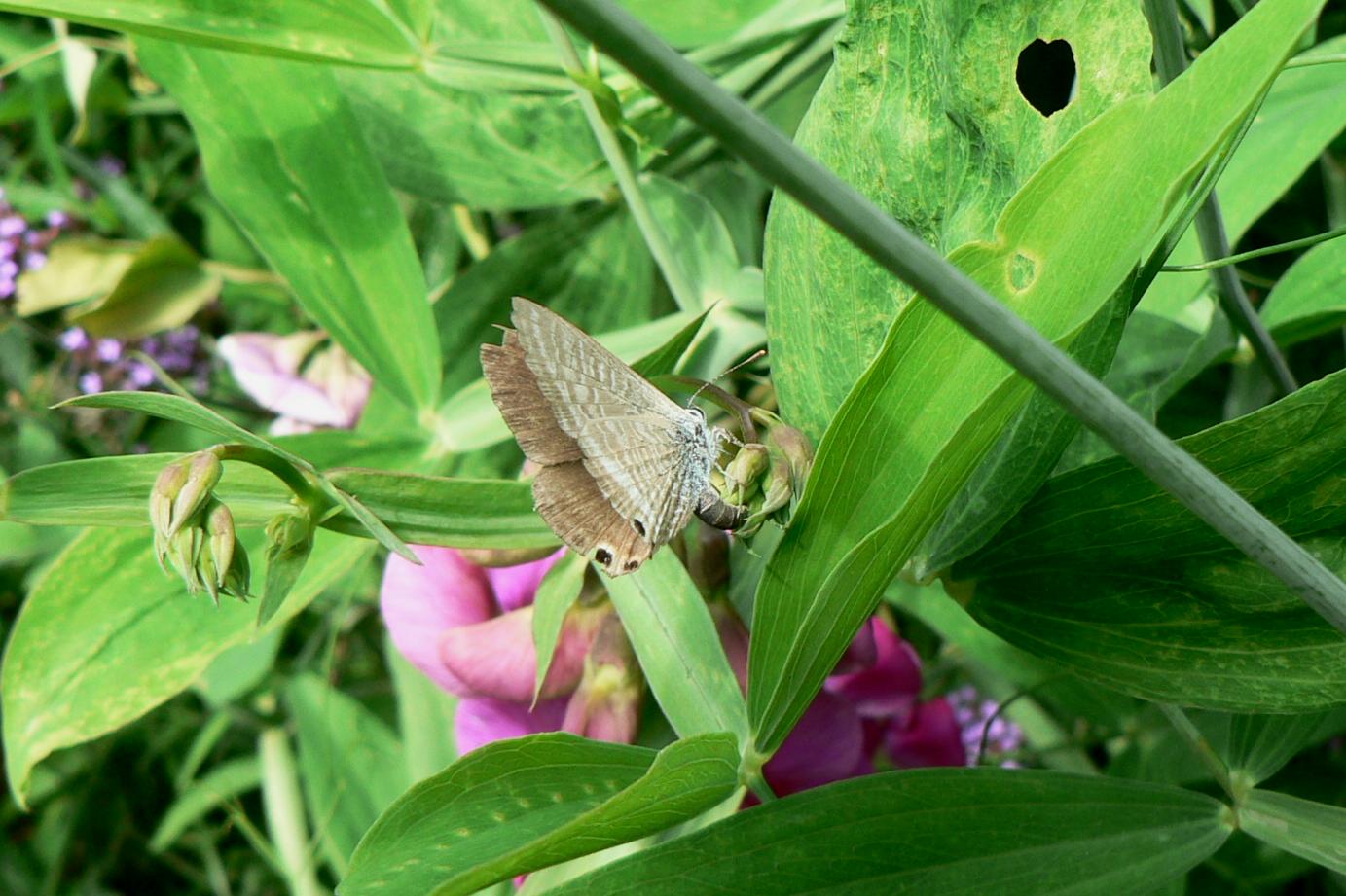
Update No 35
23rd August 2019
Ken Orpe
News from Previous Years

After another week of challenging weather conditions it looks like a rare phenomenon will occur now – a warm and sunny bank holiday weekend which will allow for the remainder of Week 21 and the start of week 22 of the transect season to be carried out in ideal conditions!
With many of the grassland species declining in numbers, it is still pleasing to note that over 400 Painted Lady butterflies have been noted from about 100 sites across Derbyshire during the last 10 days, some of which are looking very worn due to their long stay in our area (see attached photo of one).
They do appear to be very capable of taking evasive action in the event of a sudden heavy shower though – see the attached photo taken by Tony & Hilary Broadbent of a Painted Lady seen sheltering underneath a rocky out crop! Highest recent counts have come from North East Derbyshire with 14 seen at Pleasley Pit on the 18th of August 2019 (David Elliott) and 17 noted at Markham Pit North on the 13th of August 2019 (Mark Radford). Interestingly John Turner saw 10 individuals resting on Ollersett Moor on the 17th of August 2019 – these could have been ‘hill topping’ on their migration north.
Pleasingly Red Admiral numbers are on the increase locally with 10 seen on buddleias in Aston on the 18th of August 2019 (Pat & Ken Orpe) – will this species reach epidemic proportions in the late summer / autumn as happened a couple of years ago? Only your sightings will confirm this! InlLowland Derbyshire buddleias are fast losing their appeal to Peacocks as many have decided to enter hibernation despite the decent forecast for this weekend! Not so further north in the county where 32 were seen in the Hope garden of Helen Perkins on the 18th of August 2019 and a massive 90 individuals were seen in Coombs Dale on the 17th of August 2019 (Joanna Mackey), where also 31 Dark-green Fritillaries were noted there on the same day.
The progression of the Silver-washed Fritillary through our county goes on unabated with another 8 individuals seen in Derbyshire recently with sightings at Hilton GP (Alex Rapkin), Rose End Meadows (Chris & Angela Bent), Grangemill garden (John Scholey), Monsal Dale (Matthew Ross), Curbar Edge (Dianne Hibbert) and just over the county border in Notts, at Sookholme (Jaimie Bingham). Looking at the Yorkshire Butterfly Report for 2018 it looks like this species has now reached Beverley in East Yorkshire.
Recent sightings of interest include:-
White-letter Hairstreak ;- Seen at 2 sites in the Peak District – Cressbrookdale on the 15th of August 2019 and in Coombs Dale on the 17th of August 2019 (both Joanna Mackey).
Purple Hairstreak :- Seen at 2 sites in North East Derbyshire – Williamthorpe NR on the 17th of August 2019 (Willy Lane) and at Pleasley Pit NR on the 20th of August 2019 (John Scholey et al).
Holly Blue :- Still being noted in Lowland Derbyshire with the highest count of 3 coming from the Rowthorne Trail on the 19th of August 2019 (David Elliott).
Common Blue :- The second brood in lowland Derbyshire has not yet really got going but on the 13th of August 2019 a count of 16 occurred at Carr Vale (Anita Moore) and on the same day 28 were seen at Markham Pit North (Mark Radford). Numbers in the Peak District are declining fast but will there be a partial second brood there following on from the promised ‘heat wave’ this week end?
Brown Argus :- Interestingly additional mint specimens of this species have been seen in the Gang Mine/Steeple Grange/ Dene Quarry area of Cromford Hill during the last week (Keith Hall & Gary Atkins) – these butterflies were showing a full set of orange lunules on their wings which suggest that are of the migrating Brown Argus version as it is slightly too early for the second brood Peak District version to show itself. Naturally any further sightings of the Brown Argus in the area would be appreciated with a note as to their condition and number of lunules seen (ideally with a photo).
Small Copper :- At last this species is beginning to show itself in greater numbers than previously seen with 11 noted in Clover Close, Elvaston C P on the 15th of August 2019 (Marion & Sally Bryce) and 18 noted on the 20th of August 2019 in the Dene Quarry/Steeple Grange area (Keith Hall).
Speckled Wood :- At last numbers are increasing in this multi brooded butterfly with the recent maximum count of 16 coming on the 17th of August 2019 at Ambaston (Roger Martin).

The Derbyshire speciality butterfly of the present time for me is the Wall Brown – how its numbers and distribution have changed over the last 20 years is quite astounding and currently a number of recorders have seen this scarce butterfly on their own patch away from its normal range within the Peak District. During the last 10 days there have been sightings of 64 individual butterflies from 29 sites in Derbyshire, 7 sites of which are outside the Peak/Peak Fringe areas including the Chesterfield Canal, Brimington (Jenny Hudson), near Dethick (Keith Hall), Ridgeway above Ambergate (Matt Oakley), Crich Chase Meadows (Alex Knight), Cocking Tor, Ashover (Sandra & John Kidd) and on Firestone Hill above Belper (Steve Plant). Perhaps the most surprising sighting was today (23rd of August 2019) when Nick Brown saw an individual on a buddleia bush in his Langley Common Garden – so keep an eye out on those buddleias as you might have a pleasant surprise! Other areas where the Wall Brown has been seen include Big Moor (Al & John Roberts), Curbar Edge on the Eastern Moors (Tony & Hilary Broadbent) and on Totley Moor just over the County boundary with South Yorkshire (Chris Measures) so you never know when you might come across this wonderful butterfly! Highest recent counts have come from the Tissington Trail just below Parsley Hay (13 seen on the 21st of August 2019 – Derek & Iris Martin) and in Hoe Grange Quarry (6 seen on the 18th of August 2019 – Ray Badger Walker). Thanks to the recorders who have sent me their photos of the Wall Brown – a selection is attached for your interest and admiration!
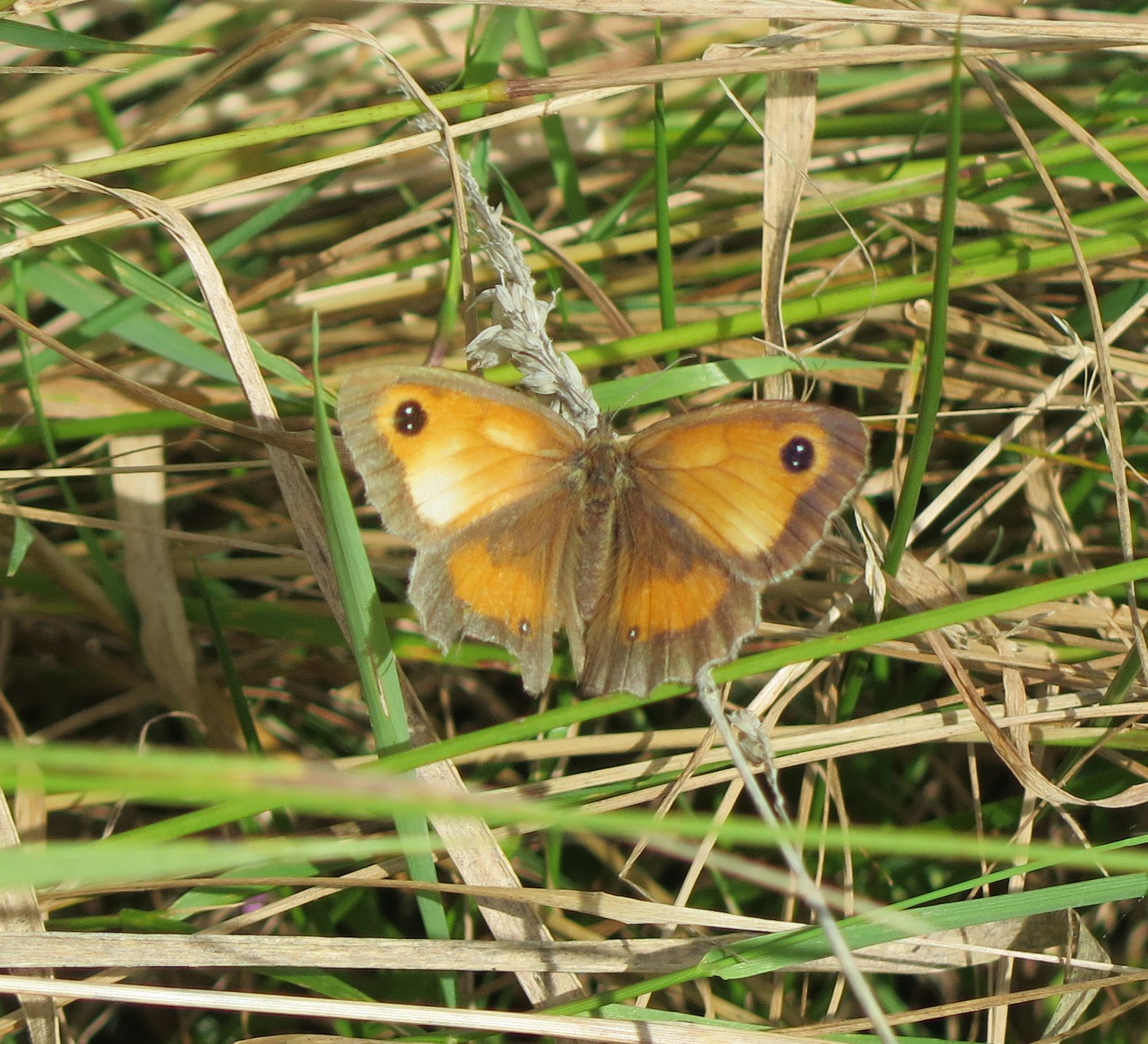
Finally it is probably not too late to see an aberration of some of our local butterflies – attached are a photo of both a Gatekeeper and Meadow Brown which show differences to the ‘normal’ colouration. The next plume of hot air might be responsible for not only migrant butterflies, such as the Clouded Yellow, Painted Lady or even Camberwell Beauties but also some late aberrations might be possible as well – keep those cameras poised!

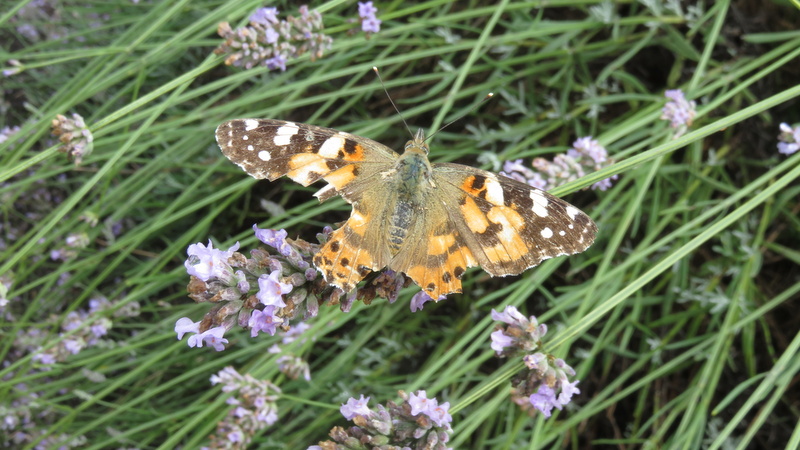
Update No 34
14th August 2019
Ken Orpe
News from Previous Years

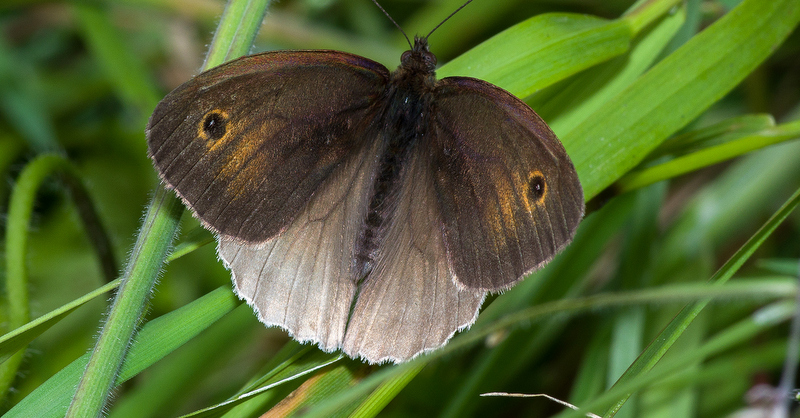
Following on from the wet and windy conditions of last weekend, here in the south of the county the Peacocks have decided that enough is enough and many have decided to go into hibernation. Further north in Derbyshire they are still showing well on buddleias as they did not appear until a little later than their southern counterparts - nevertheless recent counts in excess of 100 individuals came from Markham Pit North (Dave Wood) and Hartington Meadows NR (Caroline Wheeler) where 140 butterflies were seen. However the recent influx of the Painted Lady butterfly has still resulted in 525 individuals being seen during the last 10 days at 105 sites across the county with the highest counts coming from the Peak District – 23 at Dene Quarry, Cromford (Jonathan Page); 28 in Chee Dale (Cate Beck et al); 38 in Hartington Meadows NR (Caroline Wheeler).

It is pleasing to see a new butterfly species on a transect and after 40 years surveying at West Hallam Ash Tip, Pat and I were delighted to see a Silver-washed Fritillary flying along the recently created woodland ride whilst stopping to take nectar from the masses of knapweed that is still in flower there. How times have changed – we used to travel to Hampshire and Wiltshire to see the largest UK fritillary but the species has now come to us here in Derbyshire! Other recent sightings of the species have come from Kedleston Park (David Gibbons), Hopton Quarry (Derek Brownlee; Dave Gilbert) Williamthorpe (Willy Lane) and in the Sheffield garden of Jim Dignan. Other sightings in NE Derbyshire are probably as a result of previous years releases in the area with recent sightings coming from Pleasley Vale (Paul Townsend & Norman Jones) and Whitwell Wood (Jess Bailey; Dot Alderton)
Despite the recent weather the summer hairstreaks are still being seen in the county up to and including the 11th of August 2019 with the White-letter Hairstreak being noted at Creswell Crags (Jim Anderson), Pleasley Vale (Paul Townsend & Norman Jones), Northwood, Darley Dale (Christine Gregory), Lathkill Dale (Dave Fenton), and at Millers Dale Station site and in their Buxton garden (both Ian & Joy White). The Purple Hairstreak is still being seen on oaks including sightings from Shipley Country Park (Jim Steele), Elvaston Country Park (Marion Bryce & Derek Brumbill), Williamthorpe (Willy Lane), Pleasley Vale (Paul Townsend & Norman Jones) and at Markham Pit South (Mark Radford).
Other recent sightings of interest include:-
Small Copper :- At last numbers have reached double figures at a couple of sites in the county with 12 noted at Clover Close, Elvaston Country Park on the 3rd of August 2019 (Marion Bryce & Derek Brumbill) and 10 seen at Dene Quarry, Cromford on the 1st of August 2019 (Malcolm Scothon)
Holly Blue :- Reasonably widespread in the county now with a maximum of 8 noted on the 13th of August 2019 at Creswell Crags (Peter Ham)
Common Blue :- Numbers of second brood individuals are slowly building up in the lowland parts of Derbyshire with sightings of 20 seen on the 12th of August 2019 at Chellaston Brickworks LNR (Mark Sherwood) and 26 on the Green Grids around the Toyota UK factory at Burnaston (Trevor Taylor).
Brown Argus :- Keith Hall saw a fresh Brown Argus on the 13th of August 2019 in Rose End Meadows, Cromford – the relevance of this sighting is that it could have been an early second brood Peak District version or possibly a second brood migrating version. Last year a migrating version was seen on a transect along the nearby Cromford Canal (Patricia Sharp) so it is entirely possible that the 2 sub-species have joined up again at Rose End Meadows – any further sightings of fresh specimens would be appreciated (together with a photo if possible) – the number of orange lunules would also be interesting to know let alone a white spot on the upper wings!
Speckled Wood :- The recent maximum count has come from Broomfield College Estate where on the 8th of August 2019 Mike & Julie Ireland noted 30 individuals – let’s hope that the species has an upturn in numbers throughout the county very soon.
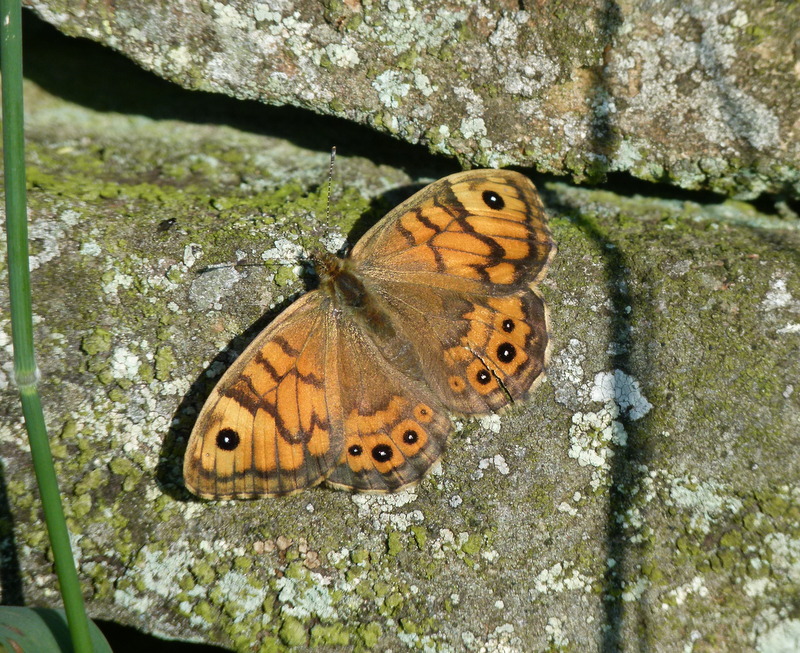
After a quiet start, the second brood Wall Brown is now increasing mainly across the Peak District with sightings of 60 individuals from 15 sites including surprisingly an individual seen at Linacre Woods near Chesterfield on the 6th of August 2019 (Peter Stoppard) – a first for him at the site there. Highest counts have come from Hoe Grange Quarry (5 – 8th August 2019 – Ray Walker & Ken Orpe et al), Coombs Dale (6 – 8th August 2019 – James Bradbury – amongst 20 species seen on the day there!), Cressbrookdale (6 – 8th August 2019 – Gordon & Alison Rooke), Calver (6 – 13th August 2019 – Chris Measures) with the maximum count of 13 coming from farm tracks at Middleton by Wirksworth on the 13th of August 2019 (Jonathan Page). (Please see attached some brilliant photos of the Wall Brown taken recently by recorders in our great county!)
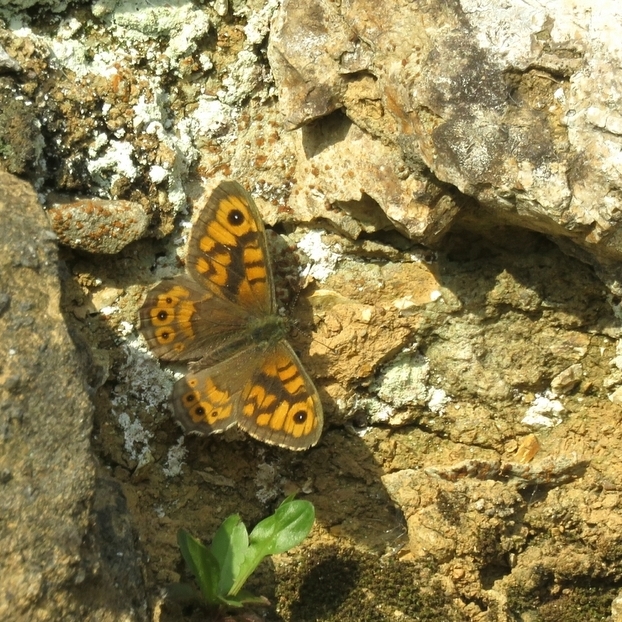
Finally the effects of the extreme heat towards the end of July (it seems like a distant memory to me today!) resulted in some more aberrations of butterflies in the county. Attached are some great photos of both the Ringlet and Meadow Brown together with a recent photo taken by Steve Plant of a mating pair of fresh Meadow Browns – it should be noted that there are no small black dots to their undersides. - Sightings of fresh Meadow Browns are as a result of a complicated lifestyle whereby dark spots on the underside of the wings are present because of certain genes – early emergences in June show up to 5 small black dots whereas late emergences in August through September have no dots at all on the underside of the wings.(as per the photo) These genes apparently affect the date of the butterflies' emergence so that it is possible to see Meadow Browns well into October in some years (latest county record for the species is the 10th of October (2017)) – it is a useful adaptation akin to not having all of your eggs in one basket, a way to ensure that if one emergence fails, the species isn’t lost in its entirety, nature continues to amaze!

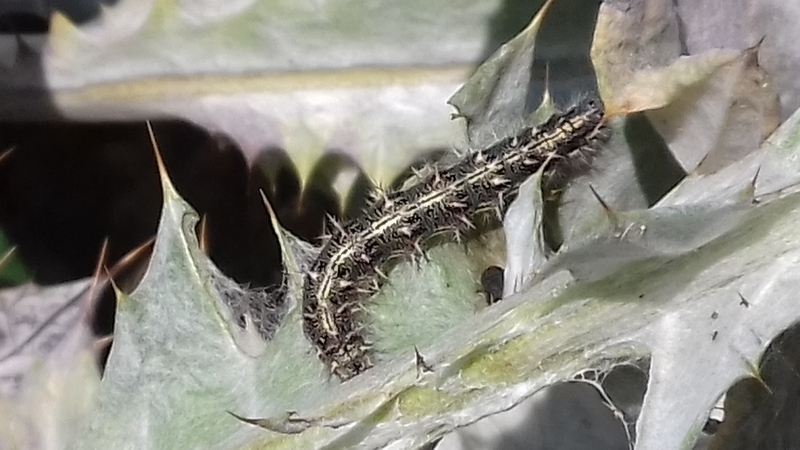
Despite the changeable weather conditions of the last week there were favourable opportunities to get out and about in the county and also to study the buddleias in gardens which suddenly became a magnet for butterflies with large numbers of Peacocks seen enjoying the nectar. In addition the Painted Lady has been quite prevalent both in gardens and the general countryside and now caterpillars of the species are being reported from mainly thistles both on waste ground and gardens.(see photo attached). Gatherings of Painted Ladies have come from 140 sites across the county with over 1,000 individuals noted with the highest counts coming from Avenue Washlands, Wingerworth (57 no – Helen Naylor) and on the buddleias within the Staveley Works site (128 on the 1st of August 2019 – Sid Morris). Whilst a few of the recent Painted Lady sightings could have been ‘home grown’ the majority appear to have come from the near continent such as the Netherlands and Belgium as they were seen in vast numbers on the east coast at the beginning of this month. Peacock gatherings of around 100 individuals have come from Ironville (Pete Clark), West Hallam Ash Tip (Ken & Pat Orpe) and on the buddleias around Willington Power Station site (Roger Martin) where a minimum of 131 individuals were seen through the site fencing! However the Red Admiral has not been seen in anything like the Painted Lady numbers with the recent highest counts coming from Ironville (5 no – Pete Clark), Ashbourne (6 no – Andrew Brown-Jackson) and Bamford (8 no– Helen Perkins).
This month has seen further sightings of the summer hairstreaks but mainly from the northern half of the county. The White-letter Hairstreak has been noted at Fenny Bentley (Derek Brownlee), Buxton (Ian White), Hope (Helen Perkins), Bradford Dale (Dave Mallon), Intake Quarry, Mercaston (Kevin Morris), Wakebridge (Fred & Gill Dyson), Northwood, Darley Dale (Christine Gregory), Longshaw Estate (Chris Kelly per Mark Bull) and in North East Derbyshire at Markham Pit North (Colin Morris) and at Arkwright (Norman Jones). Fewer sightings of the Purple Hairstreak have been received with individuals noted at Doe Lea and Williamthorpe (both Willy Lane), Hardwick Park (Ian Hunt), Markham Pit South (Sid Morris), and in the Peak District at Allsop Moor (Dave Mallon) and in Bamford (Angela Brooks).
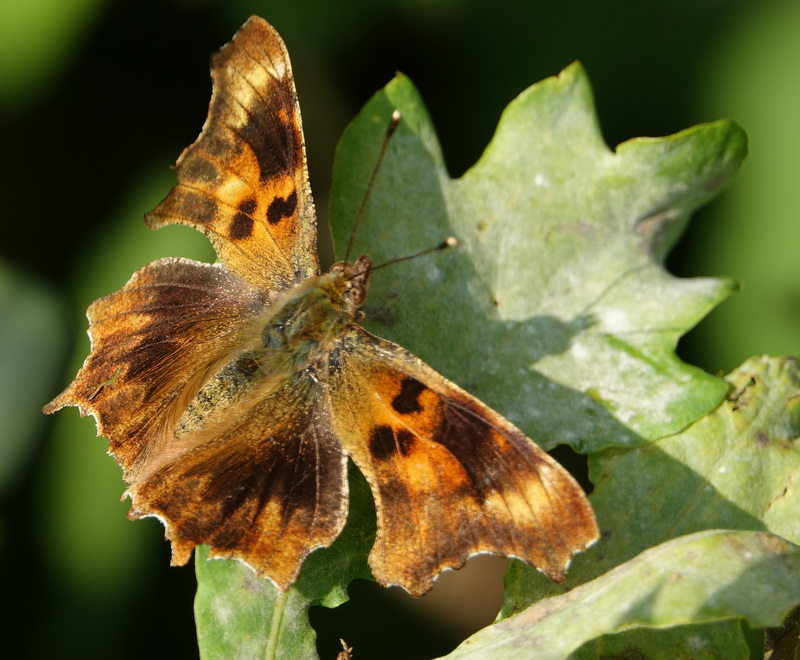
It is disappointing that the Common Blue hasn’t really produced any significant totals in the second brood in lowland Derbyshire so far this month and in the Peak District it is a late start for the second brood Wall Brown with only four sightings ecently – 2 in the Two Dales garden of Peter Faulkner , 1 in the Stanton in the Peak garden of Steve Tompkins and a singleton noted at Longstone Edge on the 3rd of August 2019 (Paul Townsend). As often happens after a recent hot spell (in late July), a number of aberrations appear and a couple have been seen this last week – a Comma ab. Testudo was seen in Cotgrave Wood, Notts (Jim Playle per Bill Bacon) and a Painted Lady with white markings on the wings in Belper (Suzy Ellis) – see the attached photos.

Another surprise specimen was photographed by Alison Rooke in Cressbrookdale recently when a Brown Argus in the Peak was seen with full white disc markings on its wings similar to the Scotch Brown Argus (see attached photo). Dave Mallon informs me that he took a photo of a BA (PDR) with clear white spots in Cunningdale in the 1990s. His rough take is that the 2 taxa (north and south) are probably very close in evolutionary terms, and the white spots show up every now and again as kind of evolutionary relic (i.e the gene responsible is still present at very low frequencies in the Peak District).
Meanwhile, the species moving north through the county are still being reported with the Silver-washed Fritillary being noted at another 5 sites recently with sightings at Kedleston Park (John & Jessica Barker), Jim Mart NR, Press (Mike & Jane Steel), Lathkill Dale (Peter Faulkner), Grindleford
(Jane Bailey) and in the far north-west of Derbyshire in the Goyt Valley (Tony Pioli) which is not far from Macclesfield Forest in Cheshire where a small colony looks to have been established (Peter Hardy). Whilst the Marbled White is known to exist at Pleasley Pit, David Elliott saw a late couple of them there on the 3rd of August 2019 and surprisingly Ray Walker saw an individual in a field at Biggin by Hulland on the same day – will this species spread into the nearby NR at Hoe Grange Quarry very soon? Although the Essex Skipper has not yet reached the Buxton area, recent sightings from the Peak District and Peak fringe areas have been received from Longstone Edge (John & Al Roberts), Lathkill Dale (Chris & Sheila Ragg), Stoney Wood, Wirksworth (Ellie Rickman), Carsington Water (Penny Northall) and on the transect in Ashbourne (Gary Atkins).
As a number of you are no doubt keen on bird-watching, I've been asked to draw your attention to Hen Harrier Day at Carsington Water on Sunday 11th August from noon to 5pm. With room for 300 pairs of Hen Harriers on English moorland there are only a handful - and just one pair in the Peak District which has room for 14 or more. Satellite tagging has shown that illegal persecution on grouse moors is the cause.
HHD is organised by Wild Justice with support from DWT and DOS and it should be both an enjoyable and social get-together as well as having a very serious purpose. Speakers include Chris Packham, Iolo Williams, Mark Avery and many others. The event is family oriented and there will be activities for all the family. Full details are at:
https://www.chrispackham.co.uk/news/hen-harrier-day-2019 with a detailed timetable to be added shortly.

Update No 32
29th July 2019
Ken Orpe
News from Previous Years
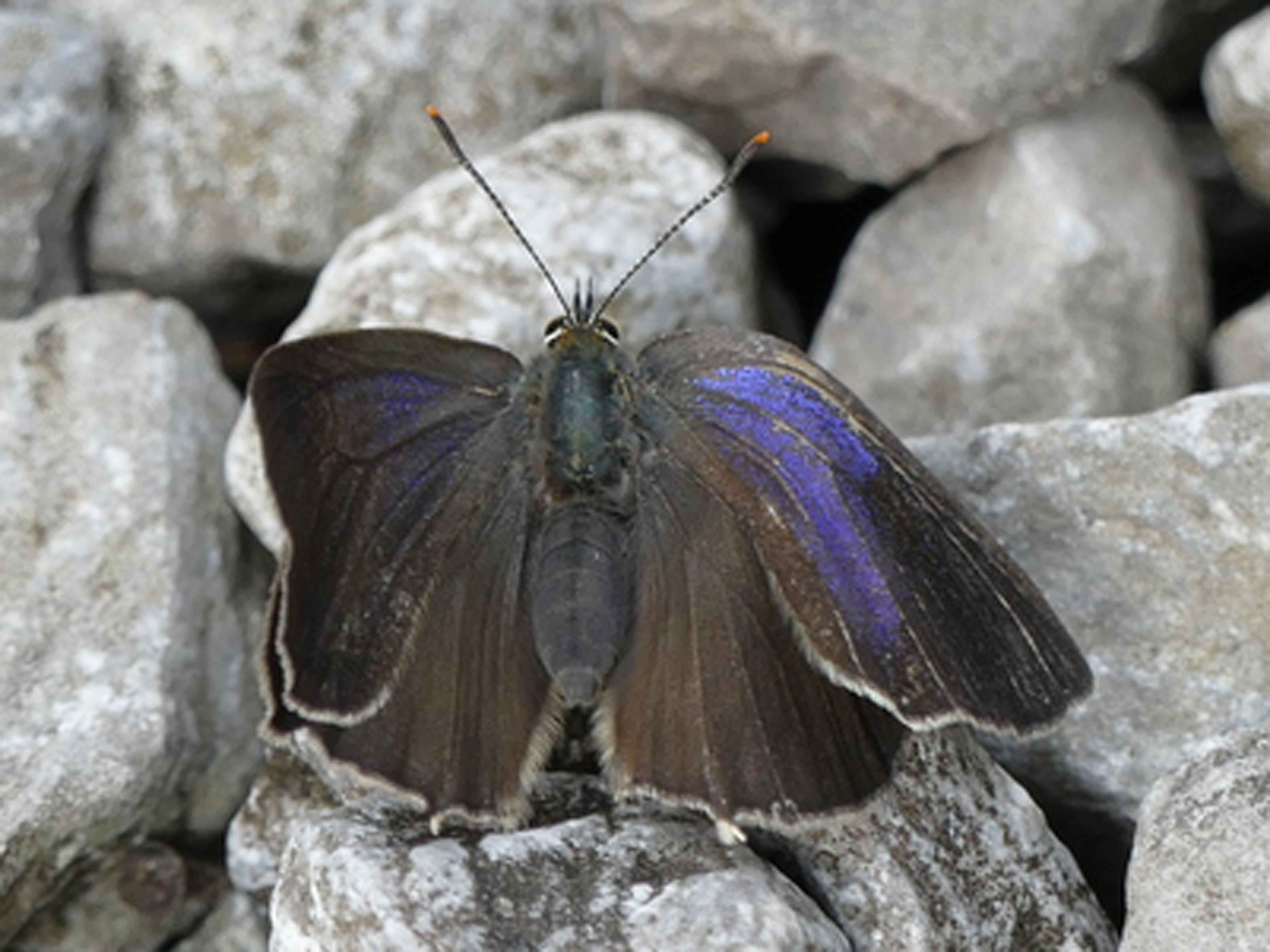

After the wet weekend that we all suffered, today brought a fine and sunny day to most of the region and amazingly a great number of Painted Lady butterflies to our countryside and gardens, where at last the buddleias were all proving their worth. It looks like the south-east wind that brought the rain also encouraged the Painted Lady to migrate from the near continent as most of the butterflies are in mint condition which suggests that they had only a short flight from their place of origin. (see photo of one of them). So far I have received sightings of at least 220 individuals from 28 locations with the maximum counts to date coming from the Rowthorne Trail – (19 – David Elliott), Bamford (20 – Helen Perkins), Dene Quarry Cromford (24 – Martin Cobham) and at the Forge Site, Ironville (36 - Sally Fisher). Please keep the sightings of this migrant butterfly coming in as it is interesting to know how mega the current situation develops here in our fantastic, but land locked county!
The movement north of the Silver-washed Fritillary carries on unabated with recent sightings of the UK’s largest fritillary coming from the riverside path at Alvaston, Derby (per Jenny Emerson), Aston Brickyards (Ken & Pat Orpe), Little Eaton Canal (Mick Fitchew) and in Hardwick Park (Ian Hunt).

At last the numbers of the new brood Peacock butterfly are increasing with competition on buddleia bushes for space on fronds with the Painted Lady being the current talking point amongst observers although Red Admirals, Commas and Small Tortoiseshells are also being reported in some parts of the county.
The great news is that the second brood Wall Brown appeared today with 3 individuals seen at Dene Quarry, Cromford (Martin Cobham) and very surprisingly an individual noted for the first time, and photographed, in Wyver Lane, Belper (Alan Walker)
Not many people can claim to have both of the summer hairstreaks present on their property in the county but I know that Eric Easom of South Wingfield has both oak and elm on his land and hence has recorded both Purple Hairstreak and White-letter Hairstreak accordingly. Well last week Jane Bailey recorded both these species on her property in Grindleford which is great as the site is so far north in Derbyshire with little oak present locally.(see attached photos of the 2 species, with the Purple Hairstreak looking like it has just emerged).
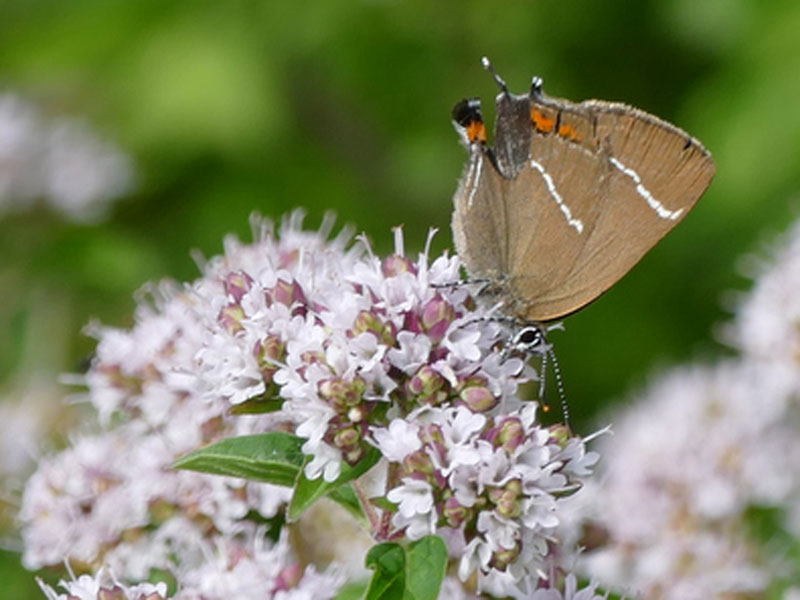
Update No 21
31st May 2019
Ken Orpe

The third week of May 2019 provided us all with some decent warm and sunny weather conditions and consequently week 8 of the transect season proved to be good for some, especially in the Peak District, but poor elsewhere as the ‘June gap’ kicked in early which resulted in some poor returns especially in the south of the county. For instance the highest count of 160 butterflies came from Lathkill Dale NNR (Al & John Roberts) whilst Jeanne Clark failed to see any butterflies on the transects around Hardwick Park.
Nevertheless 4 additional butterfly species emerged in Derbyshire with the overall number of species seen in the county during May 2019 amounting to 24 species. In date order, the new species recorded were :-
20th May 2019 – Meadow Brown seen at Shirebrook Colliery site (Roy Frost)
21st May 2019 – first Brown Argus (Peak District Race) seen in Lathkill Dale (Al & John Roberts) and on the 22nd May 2019 at Longstone Edge (Al & John Roberts) followed by others at the National Stone Centre Wirksworth on the 23rd May 2019 (Martin Cobham), Coombs Dale on the 24th May 2019 (James Bradbury) and on the 25th May 2019 in Cressbrookdale (Joanna Mackey).
23rd May 2019 – first confirmed sighting of a Dark Green Fritillary at Stanton in the Peak (Steve Tompkins) followed by a possible additional individual at Mapleton on the same day (Sally Harrison et al)
26th May 2019 – A group of 10 fresh Ringlets were seen in a meadow at Hilton GP NR by Helen Bauer.
After a lull of over a week additional sightings of the Large Skipper occurred recently with sightings in the Matlock garden of Alan Kitchen on the 23rd of May 2019 followed by additional sightings at Chee Dale on the 24th of May 2019 (Robert & Margaret Davies) and at Ironville (Pete Clark) on the 25th of May 2019.
Meanwhile the Dingy Skipper has been recorded from some new sites in Derbyshire recently including Foremarke Reservoir (Oli Foulds), Watergate Farm near Whatstandwell (Jonathan Page), New Workings, Long Eaton Gravel Pits and at Long Eaton Railway Sidings (both Roger Martin) and at Bradley Old Park (Gary Atkins). The highest recent count came from Lathkill Dale NNR on the 25th of May when Chris & Sheila Ragg counted 34 individuals in the dale there.
Some other interesting recent records/observations have come in as follows:-
Brimstone :- Counts in double figures of around 10 have come from Lathkill Dale NNR (Dave Mallon), Shirebrook Colliery (Roy Frost) and at Creswell Crags (Jim Anderson). A number of recorders have noticed that the Brimstone is laying multiple eggs on buckthorn instead of just an individual egg.

I asked Dr Roger Dennis for his opinion and he says that it looks as if the Brimstone has been subject to resource depletion, simply from appearing from hibernation before its host plant is in a suitable condition – have a look at the attached photo from Mark Radford of a buckthorn whip leaf taken yesterday at Markham Pit near Chesterfield. Similarly Pat and I have seen the same at Aston Brickyards where the Brimstone has taken a liking for the weakest shrub that we planted there and has also laid some eggs on the upperside of a Buckthorn leaf! The text books need re-writing!
Green-veined White :- As usual Lathkill Dale NNR proved to have the largest count with 47 seen on the 21st of May 2019 (Al & John Roberts)
Orange-tip :- Following on at Lathkill Dale NNR, the overall total of 317 for this species on transects in 2019 has now beaten the previous total of 275 individuals in 1985 and the butterfly is still on the wing there! Mind you the highest recent total of 51 came from the Rowthorne Trail on the 21st of May 2019 (David Elliott) which just beats the 42 seen in Lathkill Dale NNR on the same day (Al & John Roberts).
Green Hairstreak :- Yet more evidence of this small well camouflaged green butterfly expanding its range in the Erewash Valley occurred on the 21st of May 2019 when Jim Steele saw 2 individuals at Shipley View Lagoons near Ilkeston. Meanwhile on the Bilberry on the moors, counts of around 40 came from both Rushup Edge (Robert & Margaret Davies) and Old House Farm, Upper Derwent Valley (Roz Lees), whilst Simon Roddis noted 25 individuals on the Plantlife NR in Deep Dale near Sheldon.
Small Copper :- Still not showing particularly well with just the odd ones and twos about in the county and the highest count of 9 came on the 21st of May 2019 in Hay Dale (Roy Frost)
Brown Argus Migrating :- This sub-species is doing well at some sites in lowland Derbyshire especially where Doves-foot Cranesbill is prevalent such as at Drakelow NR where Tom Cockburn recorded up to 65 individuals on the 23rd of May 2019. Other records have come from Overseal (Maxine Ellis), Toyota UK at Burnaston (Trevor Taylor & Kelvin Lawrence), Chellaston Brickworks LNR (Mark Sherwood), Woodside NR, Shipley (Jim Steele), Long Eaton Gravel Pits (Roger Martin), Pleasley Pit NR (David Elliott) and at Markham Pit North (Sid Morris).
Common Blue :- This species has not yet reached its potential although it is now on the wing in both the Peak District and Lowland Derbyshire with the highest count of 26 coming from Drakelow NR on the 23rd of May 2019 (Tom Cockburn), 26 at Pleasley Pit NR on the 31st of May 2019 (David Elliott) and 25 seen at West Hallam Ash Tip on the 30th of May 2019 (Pat & Ken Orpe).
Holly Blue :- This small busy blue butterfly is still enjoying the spring weather and indeed has been seen in many gardens in the county, including 3 in the Darley Dale garden of Rod Dunn on the 23rd of May 2019, and, just like the text books, has been noted using different plants on to which it lays its eggs eg. cotoneaster, dogwood and pyracantha – see the attached photo taken by Jim Steele.
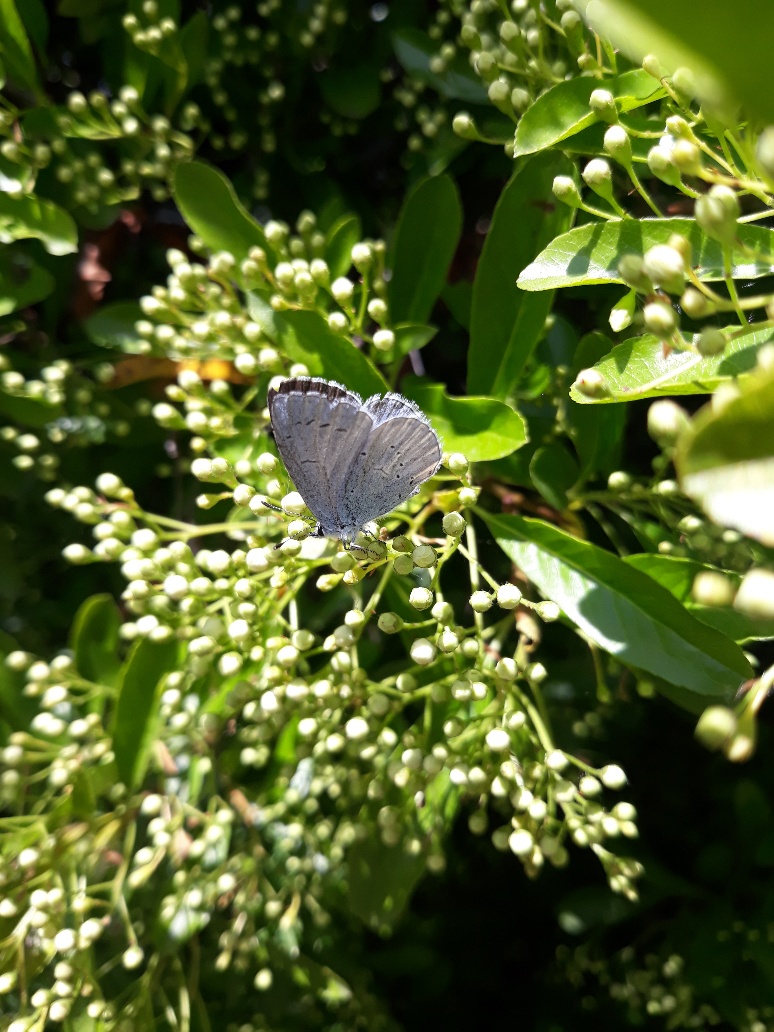
Red Admiral :- This unmistakable large butterfly has been a big disappointment so far this year with yet just 11 recent sightings of individuals in the county including Broomfield Hall (Abby Bruce), Hartshorne Wood (David & Heather Bird), Toton Washlands (Joan Breakwell & Stephanie White), Ticknall Limeyards (Ken Orpe). Clough Wood and Brassington (both Rod Dunn), Middleton by Wirksworth (Jonathan Page), Coombs Dale (James Bradbury), Lathkill Dale NNR (Chris & Sheila Ragg), Old Tupton (John & Sandra Kidd) and in Renishaw Park (Roy Frost & Christine Parsons).
Small Tortoiseshell :- Hopefully the winter hibernators will have mated and by now there should be nests of caterpillars on stinging nettles (memo to Local Authorities – don’t spray nettles and/or cut them down now). However the odd individual is still on the wing and despite losing most of its wings the one that Abby Bruce photographed at Broomfield Hall recently seemed determined to carry on and lead life to the full – see the attached photo.
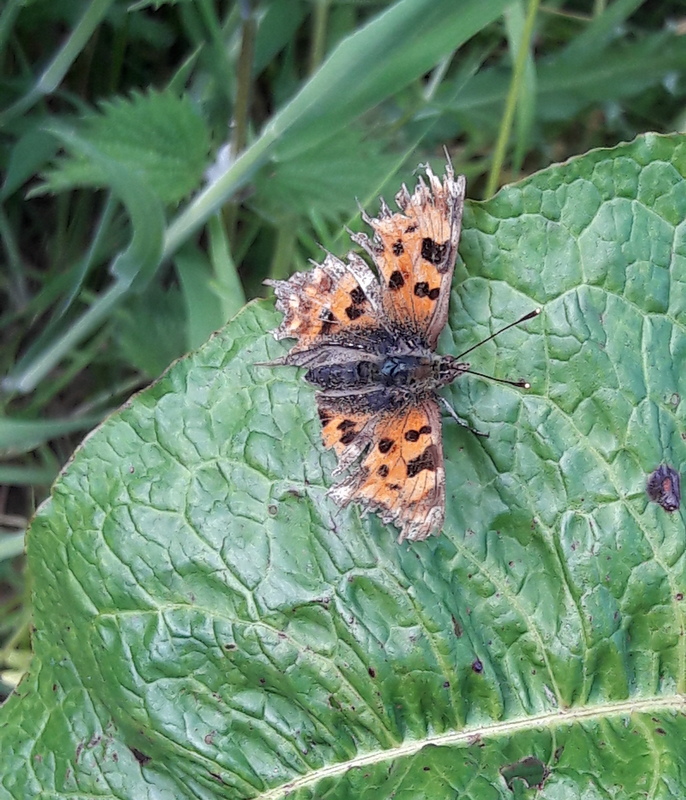
Peacock :- Again nests of caterpillars have been noted on stinging nettles ( similar message to Local Authorities) although counts of up to 17 adults have been seen recently at both Markham Pit North (Mark Radford) and in Lathkill Dale NNR (Al & John Roberts).
Comma : - It is not until early July that fresh Commas are usually seen in the county but intriguingly a number of observers have seen fresh individuals very recently so it begs the question – what is going on with this species? Any thoughts of yours would be appreciated and also please let me know if you are seeing Commas in mint condition – it could be due to climate change of course?
Speckled Wood :- Not particularly well represented at the moment although Paul Townsend noted 15 individuals in Whitwell Wood on the 24th of May 2019 – a real stronghold site for the species in the county.
Small Heath :- At last some decent counts coming in at the moment with brownfield sites showing 38 at Markham Pit North on the 30th of May 2019 (Sid Morris), and 18 at both the Forge site, Ironville (Sally Fisher & Deb Bliss) and at Drakelow NR (Tom Cockburn) whilst in the Peak District counts of 19 were made at Peter's Stone (Paul Townsend) and 17 in Hay Dale (Roy Frost).
One of the main delights of spring 2019 has been the continued expansion of the Wall Brown butterfly in the county bearing in mind that it is usually the second brood that does better than the first brood. Since the last update I have received records of at least 250 individuals from over 75 sites including proof that the species is in the process of recovering its status in lowland Derbyshire. Interesting sightings have come from Ironville village (Pete Clark) and at Bennerley on the Notts side of the border (Marion Bryce) – both sites in the Erewash Valley. Further north an individual was noted and photographed at the Avenue Washlands NR Wingerworth (Derrick Hawkins per Phil Gilbert), whist on the moors sightings have come from Big Moor, Barbrook ( Tom Aspinall) and Hathersage Moor (Dave Fenton) and Curbar (John Mead). Garden sightings have come from Northwood, Darley Dale (Chris & Sheila Ragg), Buxton (Steve Orridge), Hope (Helen Perkins), Bradwell (Sally Pereira) and in the Kinder Garden, Hayfield of Brian Gee and surprisingly a Wall Brown was seen for 4 days in the Bakewell builders yard of Malcolm Sellors. In the Peak fringe areas sightings have come from Crich Chase Meadows (Nigel Davidson), Intake Quarry, Mugginton (Ray ‘Badger’ Walker & Ken Orpe), Mapleton (Sally Harrison) and outside the wildlife centre at Carsington Water (John & Jessica Barker) where unusually an individual had 2 pupils on each eye at the top of its wings. Highest recent counts have come from Hoe Grange Quarry (15 on the 27th of May 2019 – Max & Christine Maughan) and at Wardlow Hay (13 on the 27th of May 2019 - Joanna Mackey). For those of you who do not usually see the Wall Brown, I have attached a great photo by Derek Brownlee which shows both the male and female getting ready to mate and ensure that we have a second brood in the county later in the summer – the smaller male is below the larger female – notice the wide, dark, sex brand line on the upper wings of the male).
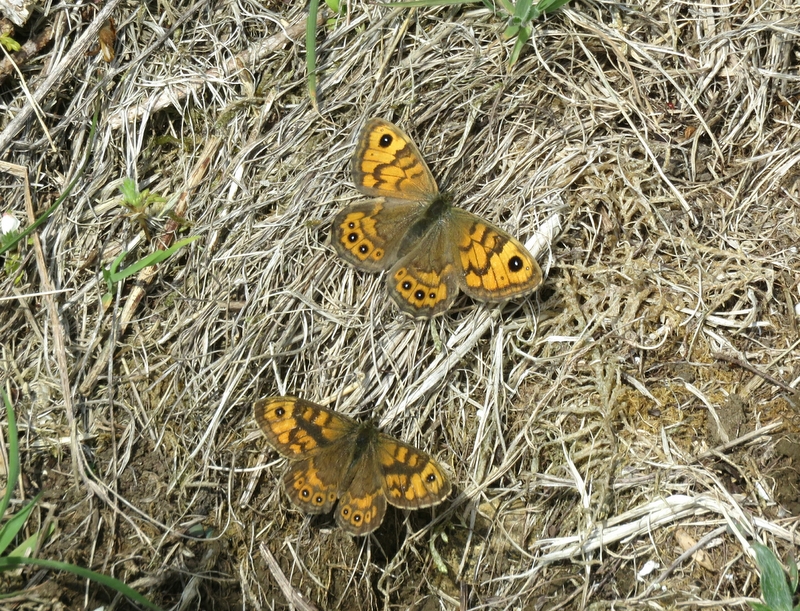
Finally if you are thinking of putting the mower back in the garden shed and letting your lawn ‘go wild’ then you could be in for a pleasant surprise – witness what happened to the Starkholmes mini meadow that Matt Buckler created recently - he had 3 Dingy Skippers present this week on the Birds-foot Trefoil that was planted in the meadow. Fantastic to be able to attract a BAP species to a small plot – he just needs to get the Wall Brown to breed on the grass in the joints on the stone walls there now!
Update No 20
20th May 2019
Ken Orpe
News from Previous Years

What a great week of sunny and warm weather that we have just experienced – week 7 proved to be lucky for most of the transect recorders with some excellent results across the county – what a relief after the poor weather during week 6 of the transect season!
A couple of new species were seen this last week in Derbyshire – the Large Skipper appearing at Pleasley Pit LNR on the 15th of May 2019 (Mick Gamble per David Elliott)which was 4 days later than the first seen in 2018. This summer-flying skipper has a chequered pattern to its wings and the antennae are hooked at the end.

The other species to appear was the Grizzled Skipper which was seen on a transect for the very first time here in Derbyshire when Rob Waldron and Marilyn Horner saw an individual at Ticknall Limeyards on the 14th of May 2019. I was lucky to be in the area at the same time and I managed to get a photo:
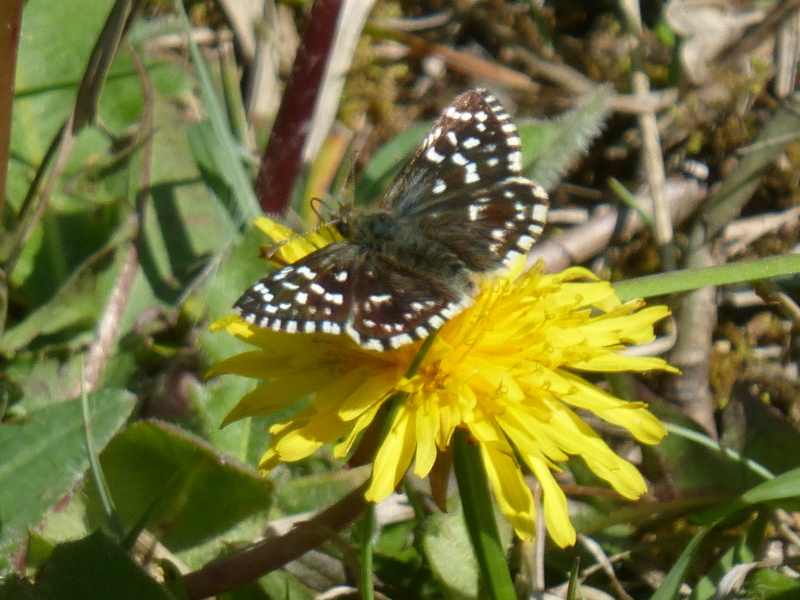
It is some 50 years since the Grizzled Skipper has bred and been seen there and it is part of an official re-introduction programme agreed between Natural England, The National Trust, Butterfly Conservation and other conservation bodies. I sometimes receive potential sightings of this butterfly but it can be confused with some day flying moths such as the Latticed Heath and there have been sightings of the Grizzled Skipper over the years in north-east Derbyshire due to unauthorised releases by the ‘breed it and release it’ brigade.
Not to be outdone, the Dingy Skipper is having a good spring with sightings from over 60 locations in the county including a new site at the New Workings in Long Eaton Gravel Pits (Roger Martin) where 3 individuals were seen on the 15th of May 2019. Highest counts are coming from the ‘brownfield’ sites in north-east Derbyshire with in excess of 40 individuals coming from Whitwell Tip (Paul Townsend), Oxcroft Tip (Jim Steele) and Arkwright Tip (Mark Radford). Great news is that this BAP species has now established itself around the factory premises of BASF in Alfreton where 5 individuals were seen on the transect there on the 15th of May 2019 (Diane Rodger & Jason Richardson)
Other very interesting sightings recently include a new butterfly species at Hoe Grange Quarry (no 27) when a Green Hairstreak was seen on the 15th of May 2019 by Paul Robinson and Ray Walker. I managed to get a photo of the butterfly the next day, so all references to the first butterfly NR in the county should read 27 species now! Interestingly the Green Hairstreak was again noted on the Derbyshire side of Toton Sidings by Roger Martin who saw 3 individuals on the 14th of May 2019.

Great news is that our Derbyshire ‘speciality’ the Wall Brown butterfly has again stepped up to the mark for the start of another fine performance with records of 90 individuals already received from 30 sites including 12 seen at Hoe Grange Quarry on the 19th of May 2019 (Ray ‘Badger’ Walker).
Interestingly this BAP species is starting to occur in gardens in the county with sightings in Belper (Dan Martin), Two Dales (Peter Faulkner), Buxworth, (Vicki Leng), Hathersage (Robert & Margaret Davies), Steeple Grange, Wirksworth (Nigel Pratley) and Millington Green (Penny Northall). When you consider that probably half the UK population lives in central southern England and since the start of the new millennium probably not one of them has seen the once common Wall Brown butterfly, it is a great privilege to have it doing so well here in Derbyshire and it is even trying to extend its range within the county as witnessed by Roger Breen (per Pete Clark) who saw and photographed an individual at Erewash Meadows in Ironville on the 12th of May 2019 – naturally all sightings of this special butterfly will be gratefully received!
Other species of interest noted recently include:-
Brimstone:- Appears still to be widespread in the county with several observers noting eggs laid on the underside of buckthorn (purging or alder) and the highest count of 23 coming from Chee Dale on the 12th of May 2019 (Cate Beck et al)
Orange-tip :- A good spring for this species with recent counts in excess of 40 coming from Erewash Meadows, Ironville (Pete Clark), the Rowthorne Trail (David Elliott), Chee Dale (Helen Waterman, Cate Beck et al) and Lathkill Dale (Chris & Sheila Ragg) where the all time total record of 275 set up in 1985 is likely to be beaten on the transects there this year!
Small Copper ;- Not really doing particularly well although 6 were noted at Dene Quarry on the 14th of May 2019 (Jonathan Page) and 7 on a walk along Derwent Edge on the same day (Chris Perry)
Brown Argus migrating :- Sightings from just 12 sites in lowland Derbyshire with the highest count of 19 coming from Drakelow NR on the 16th of May 2019 (Andy Large & Nigel Cowl)
Brown Argus Peak District Race :- Still no sightings for this sub species although it is expected to be seen in the Peak District before the end of May?
Common Blue :- A slow start to the flight period of this butterfly with to date a maximum of 7 seen at Whitwell Tip on the 12th of May 2019 (Paul Townsend). Only just starting to appear in the Peak/Peak Fringe areas of the county with records from Hartington NR (Ruth Greaves), Redhill Quarry, Middleton Top (Steve Plant & Rod Smith) and on Crich Chase Meadows (Tim Brooks)
Holly Blue :- Still having a good spring with recent maximum sightings of 7 coming from New Sawley and Draycott (both Roger Martin)
Red Admiral :- A very poor start to the year for this species and no real improvement to date with only 7 recent sightings from Aston on Trent (Roger Martin), Drakelow NR (Andy Large & Nigel Cowl), Hazlewood (Chris Perry), the Rowthorne Trail (David Elliott), West Hallam Ash Tip (Pat & Ken Orpe), Hoe Grange Quarry (Ray ‘Badger’ Walker & Ken Orpe) and in Coombs Dale (Paul Townsend).
Small Tortoiseshell :- Slowly coming to the end of its current flight period although 12 were seen on the Rowthorne Trail by David Elliott on the 14th of May 2019.
Peacock :- Doing well in places with recent sightings of 11 from Mapleton (Sally Harrison et al), 12 from Erewash Meadows (Pete Clark) and 18 noted on the transect in Lathkill Dale on the 12th of May 2019 (Chris & Sheila Ragg)
Comma :- Not so evident in the county just now with a maximum of 4 seen on the 13th of May 2019 (Peter Brewster)
Speckled Wood :- It is difficult to establish the start and finish of this multi-brooded species but at the moment it looks as though a new brood has just emerged with the highest count of 10 coming from Drakelow NR on the 16th of May 2019 (Andy Large & Nigel Cowl)
Small Heath :- Again another species that has yet to get moving with the maximum count of 15 in the Peak District coming from Long Dale (Max & Christine Maughan) and counts in double figures coming from some of the ‘brownfield’ sites in North East Derbyshire with records of 10 from both the Blackwell Trail (Willy Lane) and Markham Vale North ( Sid Morris), and a maximum of 30 coming from Arkwright Tip (Mark Radford).
Finally most men, like me. do not like the idea of supermarket shopping but it looks like Morrisons of Belper are providing additional help for its customers as Maggie Campbell found out recently when a Small Copper was seen on the handrail of a shopping trolley there. Now that would present a different proposition for me to be involved with this weekly chore!

Update No 19
11th May 2019
Ken Orpe
News from Previous Years

Despite an awful week of poor weather in Week 6 of the transect season, a brief opportunity of fine weather occurred on 7th of May 2019 which enabled Rose Williams (per Tom Cockburn) to check out the southern part of Drakelow NR and her results were pretty amazing with sightings of the Dingy Skipper and Small Heath (both BAP species) together with 3 species of the ‘Blue’ family, namely the Small Copper and first sightings in the county this year of both the Common Blue and the migrating Brown Argus. What is particularly pleasing is that the site had been fenced off earlier this year but following requests from a number of concerned lepidopterists, including Tom Cockburn and Jim Steele, the owners relented and allowed the transect to continue. So many thanks to all concerned including the owners of the site – E.ON, who recognised the importance of the area and agreed that the ‘show must go on’ – a great example of industry working with environmentalists.
Not to be outdone with events at Drakelow NR, another project to survey industrial sites for the rare Dingy Skipper came up trumps (sorry Mr President) when staff at BASF saw and photographed a Dingy Skipper at their Alfreton site – thanks to Diane Rodger and Jason Richardson for their ability to spot a rare insect on their property. Not sure which one of them got the bottle of bubbly from their M D though!
Naturally butterfly sightings this week have been rather thin on the ground but below are some of the more interesting records:-
Dingy Skipper :- Additional sightings this last week have come from Pleasley Pit LNR (David Elliott), West Hallam Ash Tip (Ken & Pat Orpe ),Cressbrook Dale (Lucie Sweet & Joanna Mackey) and on the 10th of May 2019 in Hoe Grange Quarry (Derek Brownlee) – this being 1 week earlier than the first sighting there in 2018.
Brimstone :- Maximum count of 5 came from Findern Footpaths on the 10th of May 2019 (Joan Tidy et al)
Orange-tip :- Still fairly widespread despite the poor weather of this week with the highest count of 13 coming from Poolsbrook Country Park on the 4th of May 2019 (Abby Bruce)
Green Hairstreak :- This small green undersided butterfly is still being seen in both the dales and on the moors with recent records from Cressbrook Dale (Liz Wheeldon), Deep Dale, Sheldon (Steve Orridge) and on the old rail track in the Goyt Valley (Tony Pioli)
Small Copper :- Just two additional sightings to the Drakelow NR record above which were from Deep Dale, Sheldon on the 10th of May 2019 (Steve Orridge) and at Aston Brickyards on the 11th of May 2019 (Ken Orpe & Will Rose)
Holly Blue :- Records have been received from 10 sites this last week with the highest count of 3 coming from the Belper garden of Nigel Davidson.
Now that we have both blue butterflies on the wing it is worth pointing out that the Holly Blue is quite a pale blue butterfly with a busy flight and is mainly seen around hedgerows in parks and gardens, whereas the Common Blue is mainly seen close to the ground where its larval foodplant, birds foot trefoil, grows – however the giveaway is the underside of the butterflies which are completely different – please see the attached photos!


Peacock :- Still fairly widespread in the county with the highest count of 8 coming from Holmebrook Country Park (Dave Wood & Jenny Hudson) and 7 noted in Belper Parks on the 7th of May 2019 (Adrian & Rebecca Rochford).
Speckled Wood :- Numbers not yet increasing but fairly widespread in the county with the recent highest count of 6 coming from Belper Parks (Adrian & Rebecca Rochford)
Finally on a personal note I am very pleased to inform you all that the distribution list of these updates continues to grow and I have just reached the 1,000 mark for email addresses which receive my bulletins and which represents at least 1030 interested people from all walks of life but with a common interest in butterflies, moths and the other pollinators which are so important to the life of everyone. So from small beginnings about 20 years ago when half a dozen friends decided to exchange butterfly records, the interest in the subject has risen dramatically together with the number of butterfly transects (in excess of 100) that are now carried out here in Derbyshire by at least 300 volunteers in all sorts of weather that the county can throw at them – a fantastic group of people.. It is not just wildlife organisations that take an interest these days but increasingly large companies such as the massive car factory of Toyota at Burnaston, Nestles Coffee at Hatton, Lubrizol Additive Complex at Hazlewood, BASF Chemicals at Alfreton and the Weleda flower rich fields at Shipley near Ilkeston who are all involving their staff as well as Butterfly Conservation volunteers to monitor what is happening in these current changing times of the local environment. In addition we have now got our first butterfly nature reserve at Hoe Grange Quarry thanks to the generosity of Longcliffe Quarries who also help with the creation of butterfly banks around the county – all this is well beyond my wildest dreams and thankfully I get massive support from my wife Pat who lovingly sends me emails to let me know that my dinner is waiting for me on the dining room table – and that is so very true!
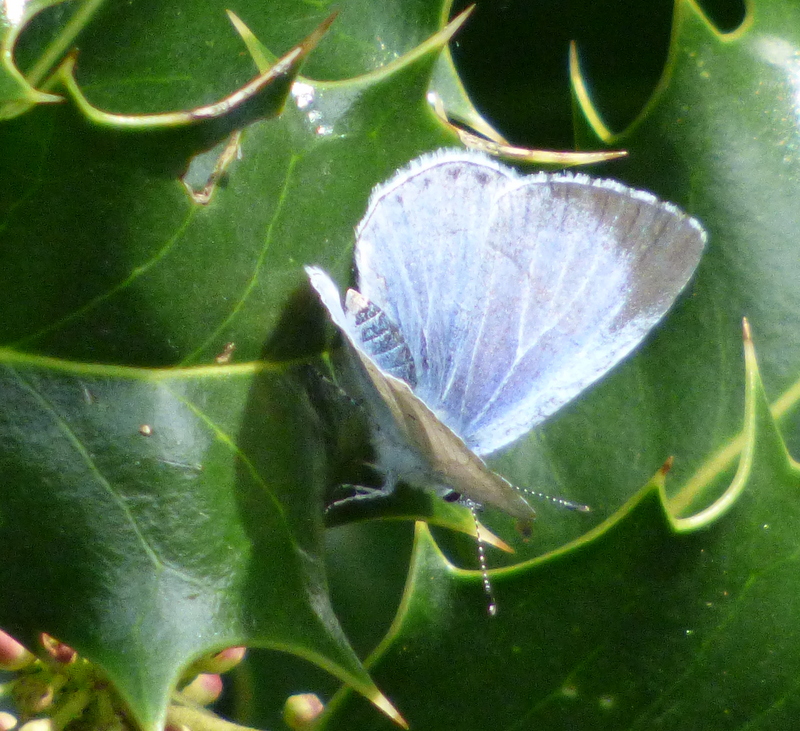
Well what a change for the May Day Bank Holiday period compared to the Easter period – the cold northerly wind ensured that butterflies were keeping low and also the fact that we had an early frost in Derby on the 5th of May 2019 (that makes a total of 67 frosts since the beginning of autumn 2018 compared to 61 during the similar period during 2017/2018 – ie a 10% increase) No wonder many sites are still lacking wild flowers although the dandelion has shown itself in decent numbers where the grasslands were last cut in autumn.
What does this mean for our butterflies – well up to the 30th of April 2019 the sightings both on transects and casual were doing okay but again a change of month has brought about a change of weather pattern and it looks like week 6 of the transect season will again prove to be quite a challenge. Thanks to all the recorders who ventured out in Week 5 – the highest count of a massive 196 came from Lathkill Dale NNR on the 30th of April 2019 where Al & John Roberts noted a huge count of 95 Orange-tips on their survey!
Fortunately we have had a new species emerge this week in the county when Andy Large saw a single Small Heath butterfly on the transect at Drakelow NR on the 5th of May 2019 – this small orange BAP species always settles with its wings folded together and is mainly a butterfly of the short sward grassland of the dales in the Peak District but small discreet colonies exist in southern Derbyshire together with larger colonies on brownfield sites in north-east Derbyshire usually at sites where the another BAP species, the Dingy Skipper, occurs. (download provisional map for 2018)
Other recent interesting/ high counts are as follows:-
Dingy Skipper: Not surprising that given the current weather there have been very few additional sightings of this BAP species – recent records have come from Hay Dale (Jim Alder), Hartington Meadows NR (Derek Brownlee) and Longstone Edge (Phil Gilbert) in the Peak District, Pleasley Pit (David Elliott) and Poolsbrook Country Park (Sid & Colin Morris)in north-east Derbyshire and along the Erewash Valley at Ironville (Pete Clark) and Shipley View Lagoon (Jim Steele).
Brimstone: Maximum count of 8 at both Chee Dale (Lee & Helen Waterman) and Tansley/Cressbrook Dale (Gordon & Alison Rooke)
Green-veined White: A high count of 42 in Lathkill Dale NNR on the 30th of April 2019 (Al & John Roberts)
Orange–tip: In addition to the Lathkill Dale total mentioned above, other recent high counts include 45 in Chee Dale (Lee & Helen Waterman) and 30 in both Ironville (Pete Clark) and alongside the River Dove at Mapleton on the 30th of April 2019 (Michael Baines)
Green Hairstreak: Still doing well across the Peak District with sightings from 15 locations with at least 30 noted on the 30th of April 2019 at Lawrence Field/Padley Gorge (Jeanne Clark). Interestingly Jim Steele saw an individual on the 30th of April 2019 within the Stanton complex near Ilkeston and on the same day Alan Kitchen saw 2 individuals at Clough Wood in Darley Dale.
Small Copper: Just three sightings in the county recently with individuals noted at Stanton Ironworks (Jim Steele), in Denby Village (Stephen Bullock per Jane Rogers) and on the 6th of May 2019 in Lathkill Dale NNR (Martin Smith)
Holly Blue: This busy, small, pale-blue butterfly is still being noted across the county with 40 individuals seen recently from 22 sites including gardens in Matlock (Alan Kitchen) and Over Haddon (Janet Wheeldon) in the Peak District, with the highest count of 4 coming from Ashbourne Churchyard on the 30th of April 2019 (Sally Oates). It is not very often that I get a photo of a freshly emerged female Holly Blue but Frances Casey took a great photo of one in North London recently...

... which indicates the extended period for the species to emerge in a good year as the first one seen in Derbyshire this year was back on the 25th of March 2019 in Long Eaton.
Red Admiral: Still poorly represented this year with only a further 4 sightings including Trent Meadows, Long Eaton (Roger Martin), Clover Close, Elvaston (Mike & Julie Ireland), Williamthorpe LNR (Willy Lane) and in Lathkill Dale NNR (Al & John Roberts)
Small Tortoiseshell: Numbers diminishing now with the highest count of 4 coming on the 30th of April 2019 at both Markham Pit North (Sid & Colin Morris) and at Broomfield College (Abby Bruce)
Peacock: Still being seen in good numbers when the sun finally appears with 26 seen in Lathkill Dale NNR (Al & John Roberts) and 21 in Poolsbrook Country Park (Sid & Colin Morris) both on the 30th of April 2019.
Comma: Again numbers diminishing with the highest count of 4 coming on the 30th of April 2019 from both Williamthorpe LNR (Willy Lane) and at Swadlincote Woodlands (Peter Brewster)
Speckled Wood: Becoming slightly more widespread in the county with the maximum count of 20 coming from Belper Parks (Adrian & Rebecca Rochford) and also 10 on the 30th of April 2019 in Whitwell Wood (Dot Alderton).
Wall Brown: Just one sighting this week of an individual noted in Lathkill Dale NNR on the 6th of May 2019 (Martin Smith).
May is usually one of the main months for the appearance of day-flying moths in the county. Already the Cinnabar moth has been noted in South Normanton (Veronica Kavaliunas) and Pat and I saw our first Mother Shipton moth at Aston Brickyards on the 30th of April 2019 - this moth can be confused in the field with the Dingy Skipper butterfly.– (see the attached photos for comparison) Probably the most spectacular day-flying moth which is on the wing in the county at the moment is the Emperor moth which can be seen flying across many of the moors in Derbyshire including Beeley Moor. Meanwhile Stephen Warman decided to visit the moors on Cannock Chase in Staffordshire recently and having bought a pheromone lure, he opened the packet and after 10 minutes 2 male Emperor moths appeared.
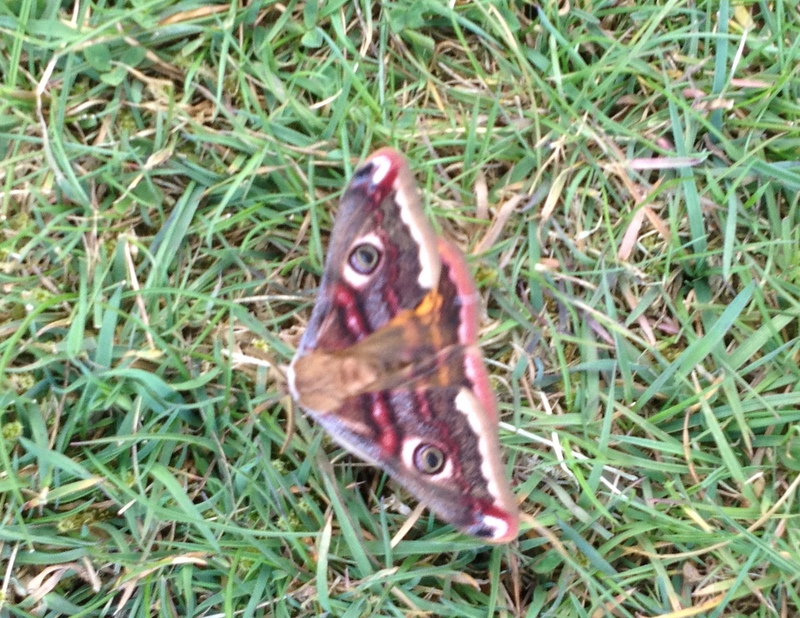
Finally thanks to Chris Butler for sending me the link below – there is at last some good news coming out of London – Brent Council has decided to create a seven-mile 'bee corridor' to boost declining populations of pollinators - Read the full story
Wouldn’t it be brilliant for other local authorities throughout the UK to adopt a similar scheme to help our insects? Here in Derbyshire we already have lots of wildlife corridors in the form of trails so if local authorities cut back on the regular and unnecessary continual mowing of grasslands and verges and invested the money that they could thereby save by creating wildflower areas it could well be a win - win situation. Well done Brent! Fortunately for us here in Derbyshire, the National Trust (NT) at Kedleston Park is in the process of removing an area of general grassland and creating wildflower areas instead for pollinators (see the photo taken in March 2019) – so well done the NT.


Well what a month April 2019 turned out to be – cold and frosty till the middle of the month here in Derby then an exceptionally warm and sunny spell over the Easter bank holiday period and finishing off with storm ‘Hannah’ which at least helped to top up the reservoir levels before the weather reverts back to changeable with night frosts forecast for early May – ‘ne’er cast a clout till May is out’ is an old saying going back to just before my time in 1732! It could just be true in 2019 with the first 2 weeks in May looking distinctly cool on the medium range forecast.
All this weather has had a dramatic effect on most butterfly species in the county with both the Orange-tip and the Green Hairstreak emerging in good numbers together with the Holly Blue and Speckled Wood not far behind. The only new species to appear since the last update was the Wall Brown which was first noted on the 22nd of April 2019 at Totley Moor on the border with South Yorkshire (Clive Hallam) and also in cuttings along the Tissington Trail at Alsop Moor on the same day (Viv Evans) – not the earliest sightings ever as the County record is the 14th of April (2007). With the late changeable weather in April 2019 it has put a stop to further sightings of the Small Copper other than an individual seen on the 23rd of the month at Belper Lane Ends by Frank Hudson. Similarly the Dingy Skipper has only been noted at the following sites recently in ones and twos at Longstone Edge (Dave Mallon, Mark Radford and Mark Searle), Hartington Meadows NR (Derek Brownlee), Arkwright Pit (Mark Radford), Pleasley Pit (David Elliott) and along the Blackwell Trail (Nikki Mahadevan). As previously noted the 3 ‘white’ species are still well below their usual numbers with the possibility of them being attacked by the hymenopterous endoparisitic ichneumon fly which is responsible for heavy losses of Pieris Brassicae larvae. thought to overwinter as pupae outside the host corpse. As Pieris brassicae infestations build up so does the population of the ichneumon fly(thanks to Stephen Warman for this information).
Some of the recent highest counts of other species in the county are as follows:-
Brimstone - 18 seen at Hollinhill on the 20th of April 2018 (Dave Fenton); 16 in Lathkill Dale NNR on the 17th of April 2019 (Chris & Sheila Ragg); 15 in Chee Dale on the 21st of April 2019 (Robert & Margaret Davies).
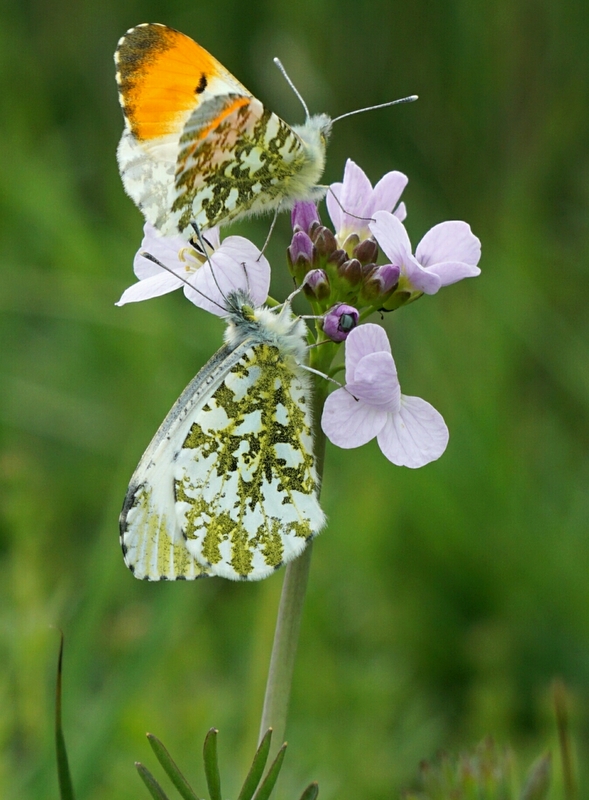
Orange-tip - Many observers are recording at least 30 of this species along their transects but the highest counts have come from Seymour Pit, Markham Vale (65 seen on the 22nd of April – Mark Radford & Sid Morris) and along Lathkill Dale NNR (66 seen on the 21st of April 2019 – Richard & Jackie Box). Will the maximum yearly total of 275 Orange-tips set in 1985 be beaten on the transects in Lathkill Dale NNR this year?

Green Hairstreak – A great start to the flight period of this essentially Peak District butterfly with sightings from 24 locations across the moors and at 16 locations in the dales with the highest counts coming from the moors with bilberry present including 84 seen at Lightwood above Buxton (Steve Orridge & Shirley Johnson) and 40 noted at Toads Mouth, above Padley Gorge (Sid & Ellen Morris). In the dales 60 were noted at Hall Dale/Dovedale just below Milldale on the 22nd of April 2019 (Ian & Joy White). Pleasingly Roger Martin noted 2 individuals on the Derbyshire side of the boundary at Toton Sidings on the 22nd of April 2019. Even more surprising was an individual noted on the transect at Gnat Hole Farm, Glossop for the first time on the 22nd of April 2019 (Marc Whitlock) and also another noted on borage and heather in the Kinder, Hayfield garden of Brian Gee on the 19th and 20th of April 2019 – I wonder how many observers in the UK have Green Hairstreak on their garden list of butterflies?
Holly Blue - This busy small butterfly has been noted recently at 120 sites throughout the county with sightings mainly in gardens including those in the far north west of Derbyshire including Bamford (Joanna Mackey), Whaley Bridge (Angie & Alan Seymour), Taxal (Sheila Stubbs) and for the first time in 25 years in Dave Mallon’s garden in Glossop. The highest count has come from Swarkestone where Roger Martin saw 7 individuals on the 20th of April 2019.
Small Tortoiseshell - Still scarce in some parts of the county but the recent maximum counts of 16 individuals have come from Denby Village (Sarah Tucker) on the 19th of April 2019 and along an old ditch with a good covering of stinging nettles in South Wood, Calke Estate (Roger Martin) on the 18th of April 2019.
Peacock - Another success story of the spring of 2019 with several sites having counts of up to 2 dozen individuals seen regularly and with the highest counts of around 30 coming from Alderwasley (30 on the 21st of April 2019 – Dan Martin) and 31 at Markham Vale Pit (Sid Morris on the 18th of April 2019).
Comma – Numbers decreasing now with the recent highest count of 6 individuals coming from Bottom Moor Wood, Matlock on the 21st of April 2019 (Chris & Angela Bent)

Speckled Wood - This species is increasing in numbers across lowland Derbyshire with the highest recent counts coming from the Long Eaton area including 30 at Long Eaton Gravel Pits (Roger Martin), 30 at Forbes Hole NR ( Marion Bryce) and a massive 60 seen on the transect at Manor Farm LNR in Long Eaton (again Marion Bryce).
Moving on to migrant butterflies and moths, the Red Admiral remains very scarce with just 5 recent sightings from Swadlincote (Ron Lane), Coton Park LNR (Peter Brewster), Sinfin Moor Wetlands (Martin Roome per Colin Bowler), Allestree Park (Bill Grange) and at Brook Park in Shirebrook (Tom Adams).
With millions of Painted Lady butterflies heading through eastern Europe (see Update no 12), which John Kirby confirms whilst staying in Marmaris in Turkey in mid April, it was hoped that many would eventually reach our shores but here in the East Midlands there have been very few sightings. In Derbyshire there were just 3 sightings at Stanton Ironworks (Bill Grange & Steve Plant), Far Laund in Belper (Nigel Davidson) and at Mapleton (Sally & Daniel Harrison). Meanwhile John Haddon saw another on the 22nd of April 2019 at the highest point in Leicestershire (Bardon Hill) where the individual must have been ‘hill topping’ on its migration north towards us here in Derbyshire! Add to that with just one sighting of the rare migrant Humming Bird Hawk moth on the 26th of April 2019 at Northwood, Darley Dale where an individual was seen taking nectar from primroses in the garden of Christine Gregory, it has been quite a disappointing period for migrant butterflies and moths but let’s face it, we are still in April (just).
It has been pleasing to see the transect numbers gradually build up from a total of 26 on week 2 (Seale Brook Wood – 11th of April 2019 – Maxine Ellis), 92 on week 3 (Waingroves Wood – 19th of April 2019 – Shaun Walters) to 109 on week 4 (Seymour site Markham Pit – 22nd April 2019 – Sid Morris & Mark Radford). Also Roger Martin recorded 101 butterflies whilst doing a casual survey around Long Eaton Gravel Pits on the 19th of April 2019 – an excellent result for a pleasant stroll through the Derbyshire countryside during April.
Thanks to all the recorders who have sent me their butterfly photos whilst on their travels – I have attached copies of a few of the spring butterflies that have been seen recently for you all to enjoy.
So which butterfly species are we likely to see appear here in Derbyshire during early May this year given a decent spell of weather? – well Pat and I saw our first flower of Bird's-foot Trefoil yesterday at West Hallam Ash Tip and this is usually a sign that the Common Blue will soon appear and possibly followed by the migrating Brown Argus in lowland Derbyshire whilst up in the Peak District the Small Heath is likely to be on the wing very soon.
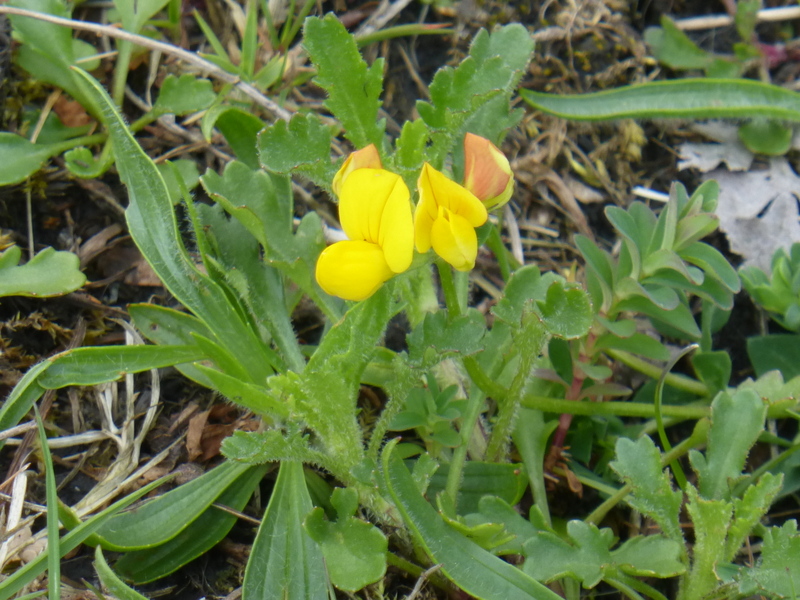
Only your continued efforts will again prove which new butterfly species have actually appeared in our fantastic County.
Update No 16
22nd April 2019
Ken Orpe

What a great bank holiday weekend of weather we have just experienced and all credit to the many recorders who managed to get out and about in our fantastic Derbyshire countryside and who consequently enjoyed seeing the local butterflies that made themselves conspicuous – responding to your emails and transect results will take me some time!
But a special mention must be made to those who reported the first Small Coppers of the year in the county with Sunday the 21st of April 2019 being the first date for their appearance this year with sightings from Rose End Meadows, Cromford (Martin Cobham), Lightwood above Buxton (John Bradburn per Steve Orridge), Longstone Edge (Mark Radford), Lathkill Dale (Richard & Jackie Box) and Eyes Meadow, Duffield (Mick Ball). Then on Monday the 22nd of April 2019 a further 2 were seen on Beeley Moor (Rod Dunn).
Undoubtedly the main item of interest currently is the fantastic numbers of Orange-tip butterflies on the wing with the other ‘whites’ being far outnumbered in possibly the ratio of at least 20 to 1 – amazing considering the huge number of ‘whites’ that were seen last summer but which have yet to produce a significant number of butterflies this spring.
With just one more day of the current warm and sunny spell left to enjoy, it would be good if the first Wall Brown was seen in the county as the current earliest date for this Derbyshire speciality is the 14th of April (2007) – good luck if you are able to get out and about tomorrow!
Update No 13
12th April 2019
Ken Orpe
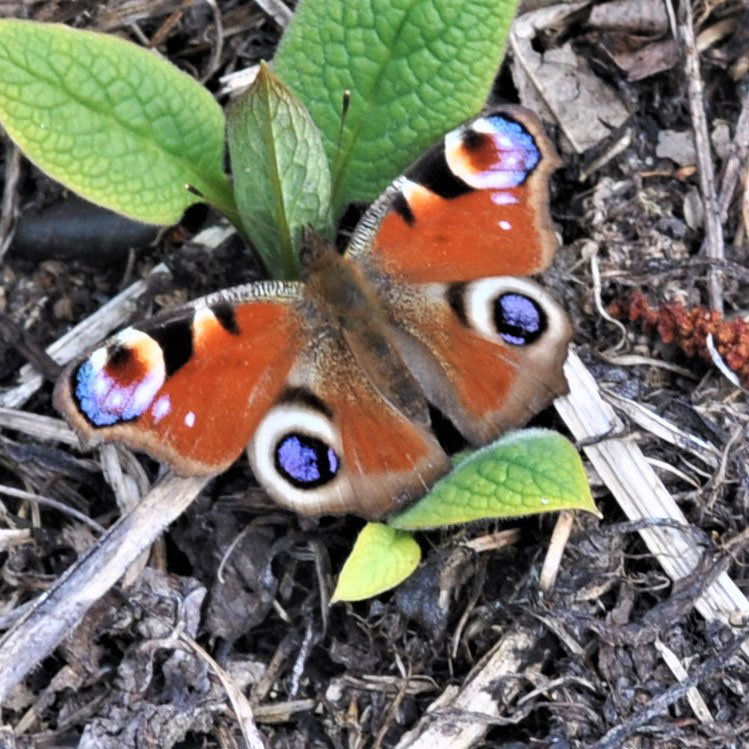
During the last week the weather has seen a constant nagging easterly wind, despite some strong sunshine throughout the county. This obviously had an effect on butterfly numbers and indeed week 2 of the transect season resulted in about 15% of the transects still resulting with a nil count but at least the maximum counts on transects has risen to a maximum of 38 individual butterflies which were seen at Drakelow NR North on the 11th of April 2019 (Andy Large). Nevertheless a couple of species have done well in the last week – namely the Orange-tip and the Peacock with many of the latter species being seen in mint condition due to their early disappearance into hibernation in late July/early August of last year. This was because in lowland Derbyshire this species couldn’t stand the constant hot weather which can also be a major factor in the appearance of aberrations. Then on the 8th of April 2019, Pete Clark saw an unusual Peacock basking on his lawn in Ironville – a quick rush to his car to get his camera resulted in an excellent photo of a remarkable aberration which I believe is Exoculata – Weymer (see the attached photo and a ‘normal’ Peacock for comparison).
A quick summary of the species seen in the county during the last week includes :-
Brimstone :- 69 individuals seen at 29 sites across the county is quite a reduction compared to recent weeks with the highest count of 10 coming on the 8th of April in Cunningdale (Rachel & Dave Purchase)
Large White :- Still very scarce with only 4 individuals seen at 4 sites due, probably, to the current night frosts that are still occurring here in Derbyshire.
Small White :- Slightly more common with 44 individuals noted from 24 sites across the county.
Green-veined White – Still scarce with just 13 individuals seen at 6 sites recently.
Orange–tip :- Over 250 individuals seen at 80 sites including some attempts at mass copulation (see below), with the highest count of 24 coming on the 9th of April 2019 at Markham Pit (south) (Mark Radford & Sid Morris)

Holly Blue :- Just 2 recent sightings both on the 11th of April 2019 with one in a garden at Buxworth (Vicki Leng) together with a couple flying around the holly bushes in Darley Park (Pat & Ken Orpe)
Red Admiral :- Following on from its disastrous year in 2018 (a 90% reduction in numbers on transects compared to 2017), this species still remains scarce with the only sighting that I have received recently coming from Swadlincote on the 29th of March 2019 (Ron Lane)
Small Tortoiseshell :- A total of 126 individuals have been noted recently from 60 sites across the County with the highest count of 11 coming on the 8th of April 2019 at Eyes Meadow, Duffield (Mick Ball)
Peacock :- The success story continues with 312 butterflies seen recently from 95 sites with the highest count of 18 coming from Hartshorne Wood on the 8th of April 2019) (David & Heather Bird)
Comma :- Still making a decent showing with 79 individuals seen at 44 sites across Derbyshire with the highest count of 5 coming on the 8th of April 2019 at Hartshorne Wood (David & Heather Bird)
Speckled Wood :- This species has now appeared at over 40 sites across Derbyshire including Whaley Bridge (Angie & Alan Seymour) and Gnat Hole Farm near Glossop (Marc Whitlock), both in the far north-west of the county, with the highest counts of 7 coming from the Trans Pennine Trail near Staveley on the 12th of April 2019 (Mark Radford) together with 8 individuals on the 11th of April 2019 at Drakelow NR North (Andy Large).
At this time of the year recorders can be confused into thinking that they have seen an early Small Copper butterfly as there is a day flying moth called the Orange Underwing which is about the same size as a Small Copper with orange showing when it settles on the ground. The caterpillar of this moth feeds on birch so if you are in a woodland ride which has birch trees nearby you could well see this moth during April.


As often happens, a change of month means a change in the weather patterns and this is certainly true of the first week of April 2019. This obviously coincided with week 1 of the butterfly transect season but volunteers still ventured out and to date over 30 sites were walked in the county during the last week which was a great achievement with the highest counts coming from Pleasley Pit (18 butterflies – Ian Hurst et al) and Manor Field LNR Long Eaton (17 butterflies – Marion Bryce) although 11 sites produced a nil count due to the poor weather.

The surprise was that on the last days of March and the first day of April the Green Hairstreak appeared in both Derbyshire and on Cannock Chase in Staffordshire (Derek Brownlee and Brian & Jean Hallam). The first sighting in Derbyshire was on the 29th of March 2019 on bilberry at Chunal followed by another sighting on the 1st of April 2019 at Lantern Pike on the moors above Glossop (both records by Jane Hewitt).
Meanwhile in lowland Derbyshire the Holly Blue was seen recently, busily flying along hedgerows at Foxstone Dam (Mark Radford), Langley Common (Nick Brown & Kath Patrick), the Strutt Centre in Belper (Dave Evans) and at the Tara Centre in Etwall (Pete Clark). The Speckled Wood has managed to make an appearance at just 8 sites in the county recently including Wyver Lane, Belper (Dave Newcombe), South Wingfield (Eric Easom), Norbriggs Flash (Paul Townsend), Hilton (Pat & Ken Orpe), Denby Footpaths (Jane Rogers & Sarah Tucker), Lubrizol, Hazlewood (Megan Williams et al), Manor Farm, Long Eaton (Marion Bryce) and at the New Workings at Long Eaton Gravel Pits (Roger Martin).
Interestingly the low temperatures at night have probably prevented many of the ‘whites’ from appearing in the county recently – indeed frosts here in Derby this last winter have amounted to 61 mornings which was exactly the same number as the winter of 2017/2018.
The total sites where whites have been noted this last week are as follows:-
Large White – just 3 individuals seen at Sawley (Brian & Jennifer Sewell), Thurvaston (John & Wendy Abrehart) and at Over Haddon (Janet Wheeldon)
Small White – only noted at 12 sites throughout the county
Green-veined White – only seen at just 6 sites in Derbyshire recently in just ones and twos.
Orange-tip – has been slightly more widespread than the other ‘whites’ with sightings from 22 sites in the county with the highest count of a mere 5 coming from the New Workings at Long Eaton Gravel Pits on the 1st of April 2019 (Roger Martin).
As previously recorded, the 4 hibernating butterflies have done the best during the first 3 months of the year – indeed the total number of 1686 individuals seen is second only to the first 3 months of 2014 when 2068 butterflies were seen (see the attached excel chart). The only blemish is that the Red Admiral has performed poorly with only 16 individuals noted although this is on a par with the 17 seen in the first 3 months of 2014.
For the record, yet again the Peacock has been the most common butterfly seen recently in the county with 211 butterflies noted at 53 sites including a maximum count of 20 at Williamthorpe on the 29th of March 2019 (Bill Grange & Steve Plant). Then followed the Brimstone with 123 butterflies seen at 52 sites including a maximum of 31 individuals noted at Scarcliffe Park on the 29th of March 2019 (Roy Frost & Christine Parsons). Not far behind was the Small Tortoiseshell with 122 butterflies noted at 47 sites with a maximum count of 18 at Norbriggs Flash on the 29th of March 2019 (Mark Radford).
The Comma was noted at 30 sites in the county and consisted of 63 individuals of which 17 were seen at Scarcliffe Park on the 29th of March 2019 by Roy Frost and Christine Parsons. The over-wintering Red Admiral was again conspicuous by its absence with sightings from just 4 sites including Ticknall Limeyards (Mathew Harpin), Allestree garden (Dave Roberts), the Weleda site in Shipley ( Lindsay Billsborrow) with the highest count of just 3 coming from Eyes Meadow, Duffield on the 29th of March 2019 (Mick Ball).
Following on from my note in the last update, Brian Hallam has sent me an article which has appeared in Cyprus regarding the mass migration noted there recently of the Painted Lady butterfly. (Page deleted at source)
Whilst on the subject of migration, Keith Hall was pleasantly surprised when he saw a Humming-bird Hawk-moth taking nectar from a patch of Aubrietia in King Street, Duffield on the 31st of March 2019 – no doubt it arrived here in the UK during the warm spell of weather that we experienced at that time.
Less welcome to these shores is the Harlequin Ladybird which has invaded Britain from the near Continent, where they were introduced from temperate eastern Asia as an aphid controller on farmland. Also, as well as feeding on native ladybirds, they are suspected of predating butterfly larvae - so they are not good news but it is impossible to do anything about them now though. To give you some idea of the over-wintering numbers locally, Matthew Birkin saw lots in Ilkeston Cemetery recently (see the attached photo) where they were seen soon starting mating so as to increase their numbers even further.

Butterfly Conservation East Midlands have recently produced a list of their Field Trips for 2019, 5 of which will take place here in Derbyshire including the 3rd Open Day at Hoe Grange Quarry, Longcliffe on the 21st of July 2019.

Despite some cold nights with slight frosts, the mainly sunny weather of the last week has encouraged 2 new butterfly species to emerge in the county – the first sighting of the harbinger of spring (aka the Orange-tip) was noted on the 23rd of March 2019 at Causeway Lane in Matlock (Gareth Hirons) followed by others on the next day (24th of March 2019) in Long Walk Wood at Aston on Trent by Roger Martin and also at Slaley in the Peak District (Paul Goodwin). On the following day (the 25th of March 2019) a couple more sightings of this unmistakable male butterfly were seen on Stones Island at Carsington Water by Brian Hobby and also in the Duffield garden of Keith Hall (see the attached photo of a male Orange-tip taken last year by David Hatfield). Further sightings this week have come from West Hallam Ash Tip (Ken & Pat Orpe), on the Blackwell Trail at Hilcote (Ian Wilson) in the Wakebridge garden of Fred & Gill Dyson, at Creswell Crags (Jim Anderson), in the Denby garden of Jane Rogers, and also in the Whaley Bridge garden of Angie & Alan Seymour. Interestingly 2 Orange-tips were seen and photographed in cop at Broomfield College (Ben Thomas per Paul Foskett) on the 28th of March 2019 so they obviously take advantage of the weather at every opportunity to ensure future generations are produced! (see attached photo). Then on the 25th of March 2019 a couple of Holly Blues were seen in the Long Eaton area by Marion Bryce – one in her garden and the other at Forbes Hole LNR.

Strangely there have been very few further sighting this month of ‘whites’ following on from when Pete Clark saw a Small White at Codnor Park on the 20th of March 2019. The next sightings of this species came on the 28th of March 2019 at Carr Vale NR (Mark Beevers) and at Breadsall Cutting on the same day (Ken & Pat Orpe) together with singletons at Mickleover Meadows (Colin Bowler), Codnor Park (Pete Clark) and in Long Eaton (Marion Bryce). Just 1 further sighting of a Large White recently with an individual seen on the 28th of March 2019 at West Hallam Ash Tip (Ken & Pat Orpe) and just 3 sightings of the Green-veined White on the same day at Whaley Bridge (Angie & Alan Seymour), at West Hallam Ash Tip (Ken & Pat Orpe) and at Mickleover Meadows (Colin Bowler).

Also the Speckled Wood is still infrequent in the county with the only recent sightings coming from Miller's Dale on the 23rd of March 2019 (Rod Dunn), at Brierley Wood near Sheepbridge on the 24th of March 2019 (Paul Townsend) and in the Whaley Bridge garden of Angie & Alan Seymour on the 25th of March 2019.
Pleasingly the 4 hibernating butterfly species have maintained their presence in the county recently with the Peacock proving to be the most common with sightings of 147 individuals from 48 sites including 12 at Codnor Park (Pete Clark), 11 in Coombes Dale (John & Al Roberts) and 10 at Denby Pottery(Jane Rogers) – the majority of this species are in mint condition having gone into hibernation early at the end of July 2018 / beginning of August 2018. (see the attached photo taken by Eric Easom of an individual seen at South Wingfield earlier this week). The Comma has also been seen at 31 sites and consisting of 112 individuals, the majority of which (50) were seen by Ian Wilson along the Blackwell Trail at Hilcote on the 20th of March 2019. The brightly coloured Brimstone is unmistakable and was seen recently at 31 sites and consisted of 88 individuals of which 12 were seen at Markham South Pit (Sid Morris) and 11 at both Clough Wood (Bill Grange & Steve Plant) and along the Blackwell Trail at Hilcote (Ian Wilson). However the Small Tortoiseshell has been less common with only 62 individuals seen at 33 sites across the county with the maximum count of 6 coming from Poolsbrook Country Park on the 25th of March 2019 (Mark Radford).
However, sightings of the Red Admiral seemed to have dried up so Pat and I were pleasantly surprised to see an individual taking nectar from the many flowers within the garden centre at Chatsworth on the 25th of March 2019.Interestingly Colin Bowler has sent me a link to an article on the recent migration of billions of Painted Lady butterflies through Israel whilst on their way to Europe. It could be said that the numbers were of biblical proportions!
John & Al Roberts have confirmed to me that one of their friends saw 72,000 Painted Lady butterflies on migration during a single day whilst on holiday in Cyprus last week!
On a less positive note, Nick Brown has sent me a link to an article on the reduced number of butterfly species seen in agricultural areas. Meadows adjacent to high-intensity agricultural areas are home to less than half the number of butterfly species than areas in nature reserves. The number of individuals is even down to one-third of that number.
If you would like to participate within a team to carry out a butterfly transect this year, there is still time to volunteer for the rota at a few transects in the county, especially in south Derbyshire – let me know if you can help at Mickleover Meadows and/or Allestree Park in Derby and also Coton Park LNR near Linton where both the Dingy Skipper and the Small Heath have been recorded. The existing volunteers will be able to show you the route of the transect together with the procedure for carrying them out.
Finally Mick Ball has amended the id of one of the butterflies of Peru that were stated in the last update :-
No 3 – Should be the Boeotia Sister - Adelpha boeotia. As for the swallowtail, it is one of the subspecies, the King Swallowtail - Papilio thoas cinyras.

Staying on the theme of the butterflies of South America, David Oulsnam has kindly sent me some photos of butterflies that he took in the Amazonian area of both Peru and Brazil – enjoy!
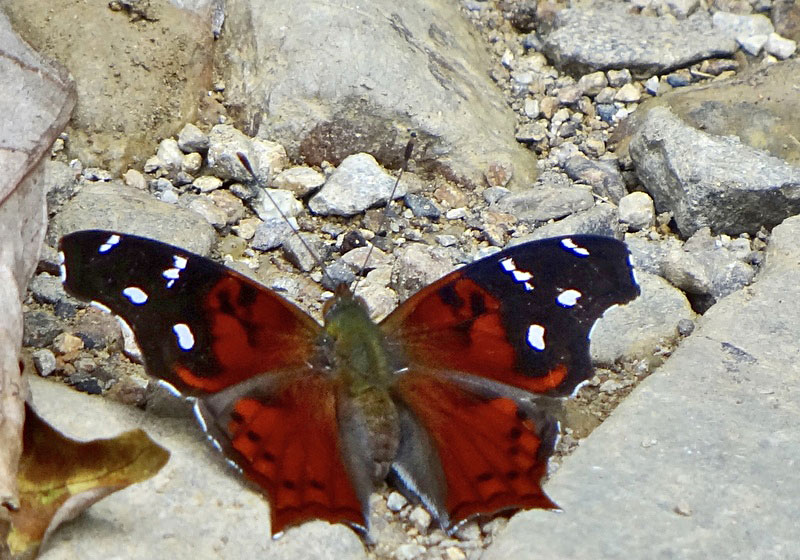

Update No 10
22nd March 2019
Ken Orpe
News from Previous Years

One swallow doesn’t make a summer is a familiar phrase and hopefully Wednesday the 20th of March 2019 will not be all the fine weather that we get in the county this Spring but with a temperature of up to 18°C here in Derby on that day, the butterflies duly obliged and appeared, in reasonable numbers, despite the heavy rain of the first 2 weeks in March 2019, and thus gave many recorders a fillip, just as the sun crossed the equator for 6 months here in the northern hemisphere.
A total of about 250 butterflies were seen across the county on the 20th of March 2019 with about 100 being Brimstones which were seen at 36 locations including 10 at Creswell Crags (Jim Anderson) and 12 in Cunningdale (Steve Orridge et al). The next species with the highest number seen was the Peacock of which about 70 were noted from 28 sites including 9 seen at the National Stone Centre, Wirksworth (Jan Hall & Martin Cobham). Then followed the Small Tortoiseshell with about 50 noted at 27 sites across Derbyshire with the highest count being 6 which were seen nectaring on Coltsfoot in a field in the Cromford area.(Jenny Emerson). The other hibernating butterfly, the Comma, was only seen at 12 sites within the county which consisted of about 26 individuals with the highest count of 4 together coming from Creswell Crags (Jim Anderson).
There have been no further sightings of the Speckled Wood recently after an individual was seen on the 4th of March 2019 at Forbes Hole LNR in Long Eaton (Marion Bryce) and just a couple of ‘whites’ were seen on the 20th of March 2019 including the first Small White of the year in the Thurvaston garden of John & Wendy Abrehart whilst a Large White was seen flying along Acorn Way in Chaddesden by Ken & Pat Orpe.
So before the month of March 2019 finishes, which species could make an appearance in the county given a fair wind and some decent sunny spells? The first sighting of a male Orange-tip is always special as it is the lepidoptera event heralding the arrival of Spring, whilst on the moors of the Peak District amazingly the Green Hairstreak can appear on bilberry, and in urban gardens the Holly Blue can be seen busily moving through shrubs especially where there is plenty of holly around – only your sightings will confirm these possibilities.
However if you are tempted to visit one of the main dales in the Peak District very soon, be warned that the River Lathkill is in full spate at the moment with a torrent of water emerging from the cave near the top of the dale as Chris & Sheila Ragg found out on the 17th of March 2019. (see the attached photo).
Thanks very much to the members of this egroup who came up with answers to the ID of the butterflies that were shown on the last update – the consensus is that the names are as follows and amazingly photo 4 was of a day-flying moth that resembles a Swallowtail butterfly!
- Oedipus Owl Butterfly - Caligo oedipus
- Glittering Sapphire Butterfly (male) - Lasaia agesilas
- Linda's Emperor - Doxocopa linda linda
- Green-banded Urania - Urania leilus. This is a day flying moth, not a butterfly although it resembles a Swallowtail.
- King Swallowtail - Papilio thoas
Attached this time are a couple of photos that were taken locally – one of a pair of Small Tortoiseshells that were deciding to be more than friendly with each other (taken by Guy Badham) and a photo of a Herald moth taken by Sue Davey which she found recently hibernating in her shed.


Always great to end up with some good news – Derbyshire County Council has declared that Aston Brickyards will become a Local Nature Reserve. This is as a result of some amazing work that has been carried out at the site over the last 7 years by members of FAB (Friends of Aston Brickyards), of which Pat and I are pleased to be part, having done a butterfly transect there since the new millennium and where we have recorded 24 species including the rare White-letter Hairstreak which is present on the site.(see the attached photos of before and after in relation to the grassland)

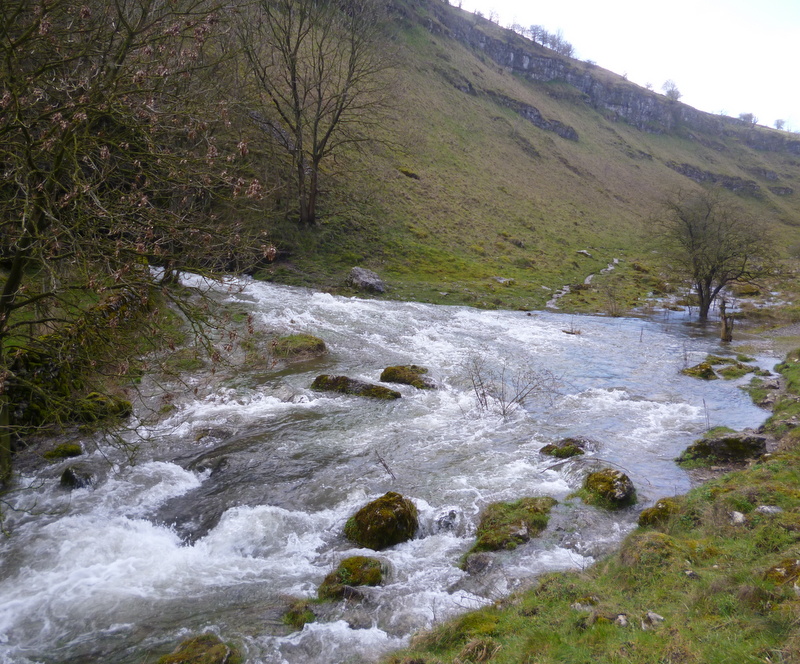
Update No 9
15th March 2019
Ken Orpe
News from Previous Years

With the jet stream in full blast carrying storms across the Atlantic towards the UK since the start of the month it looks like we are getting winter weather now instead of what should be spring weather, despite the fact that the vernal equinox is only a few days away on the 21st of March 2019. One good effect of all the recent rain is that our reservoirs are filling up nicely with Carsington Water at 90% capacity, Derwent at 99.9% full and Howden at 91% capacity. Even the huge Ladybower Reservoir is now 80% full so the drought of the summer of 2018 seems a long way off now!
What has happened to all the 400 or so butterflies that emerged in February 2019? The hibernators have probably looked for a crevice to hunker down and sit out the poor conditions. So it is unlikely that they have gone back into full hibernation - more likely that they have gone into over-wintering mode like the Red Admiral has done over recent winters. However the other species that emerged in February 2019 would have probably perished as there is a limit to the time that you can sit underneath a leaf in a force 8 gale with teeming rain!

However it was quite a surprise that a Painted Lady was seen taking nectar from a flowering heather on a patio in the Darley Abbey garden of Keith Dodd on the 1th of March 2019 (per Alan Jones). As was proven recently this migrant butterfly returns to North Africa in the autumn as they cannot survive our winters so this individual must have come into the UK during the warm weather of late February when at least a couple of dozen individuals were seen in England as far north as Lancashire and Barnard Castle in County Durham (per Mark Searle).

Not to be outdone, a local Peacock was seen on the same day in the Kinder, Hayfield garden (in the High Peak) of Brian Gee, this after the day began with a temperature of 3°C complete with snow and hail – so they are made of sterner stuff than what we think!
Pleasingly the anticipation of carrying out a butterfly transect in our fantastic county is still on the minds of many of the 300 volunteers who did just that last year. Indeed, following on from the recent transect training sessions across the county which attracted over 100 volunteers including staff from at least 4 local companies, there are new transects being set up in readiness for the start of the walking season on the 1st of April 2019. So if you are interested in being part of one of the teams that cover at least 100 sites in Derbyshire then please send me an email to confirm your interest. Local co-ordinators are now drawing up the rotas so if you haven’t heard anything yet then please contact your local person or alternatively let me know.
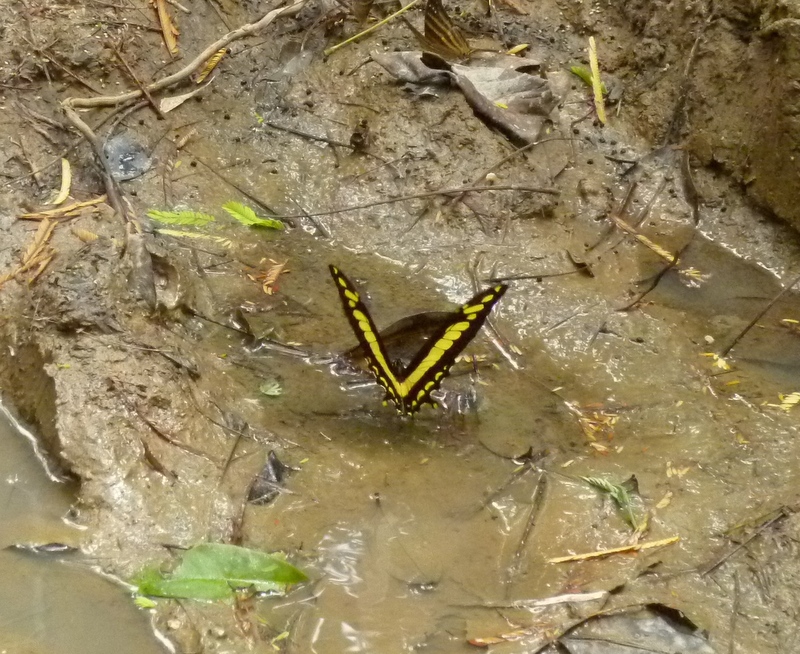
Finally I was very interested to receive some more photographs of butterflies from around the world – Peter and Kath Cartlidge visited the rainforests of Peru late last year. I have attached some of the photos taken but unfortunately neither the guide or anyone else in the party knew what butterfly species they were. So here’s a challenge for you – please let me know the names of the butterflies! Meanwhile, Joan Gibson visited Patagonia in November 2018 where she managed to photograph what she thinks is an Andean Foothills White which was seen taking nectar from a native dandelion plant – unless someone else can provide a different I D?

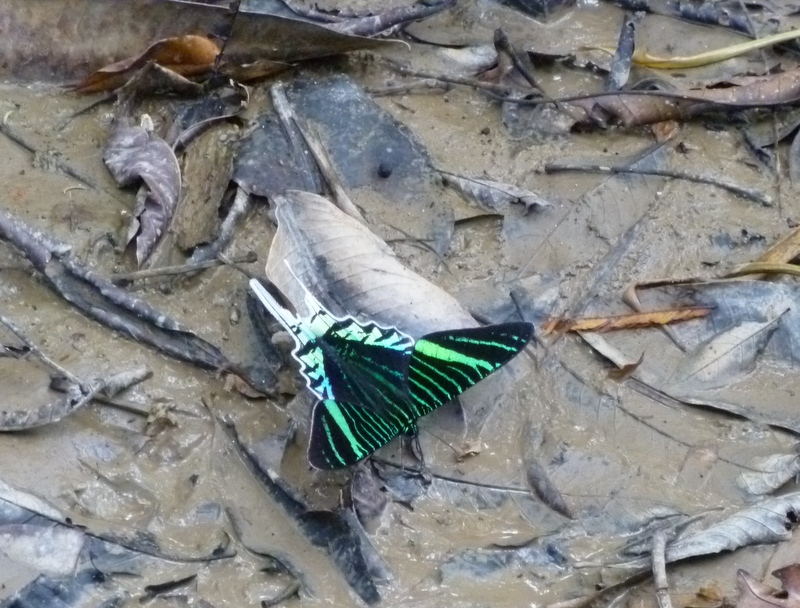
Update No 8
7th March 2019
Ken Orpe
News from Previous Years

Now that Storm Freya has left our shores, it looks like our local lepidoptera have decided to lay low and wait for better conditions to materialise as there have been no butterfly sightings so far this month in the county. I have been informed of a couple more interesting sightings though – another Speckled Wood was seen by Jim Steele on the 26th of February 2019 at Shining Cliff Wood, Ambergate, and just over the county border at Ashby de la Zouch in Leicestershire, Martin Vaughan saw a Humming Bird Hawk moth nectaring on winter honeysuckle in his garden on the 1st of March 2019 – no doubt the species had arrived in southern England during late February 2019 when the temperature was hitting 18°C instead of 8°C as of now and the airflow was from the south and not the north-west as it is at the moment.

This time of the year is really important for our local toads, frogs and newts and Kelvin Lawrence, Toad Crossing Coordinator for Derbyshire Amphibian and Reptile Group, has asked me to put out a request for help over the next few weeks (please see the attached poster). They would like people to give one or two evenings a week over the next few weeks to rescue toads, frogs and newts from road traffic in their local area. They have sites in most areas of Derbyshire and often struggle to cover them all on busy nights. For info please email derbyshirearg.toads@gmail.com
As promised we can look at some more great butterfly photos that have been taken by members of this egroup – this time they have been taken in South Africa by Norman Jones. It would be great to see something like the Yellow Pansy flying in our county!

Finally, a quick check with Butterfly Conservation revealed that here in Derbyshire during 2017 we provided 28,434 butterfly records at the 2km resolution for inclusion in the national database – this puts the county in 9th position out of a total of 55 counties that are contributing to the project in the UK, bearing in mind that Derbyshire is 20th in the table of county populations in England. Another fantastic effort by members of this egroup!
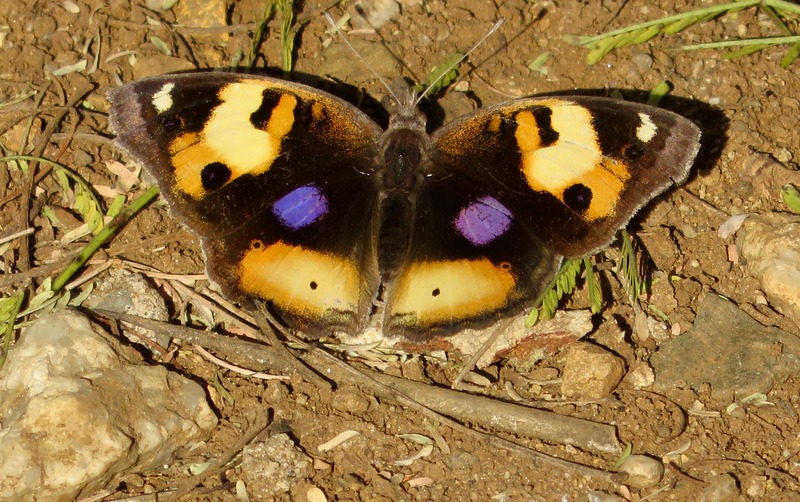

Update No 7
28th February 2019
Ken Orpe

After an amazing spell of Mediterranean style weather recently, with cold nights but very warm and sunny days including a record 18°C here in Derby on the 26th of February 2019, many recorders have emailed me their sightings in the county and a total of 390 butterflies have been seen in February 2019 compared to just 6 in February 2018 when we suffered extreme cold as a result of the ‘Beast from the East’ The overall total for the first 3 months of 2018 was just 184 butterflies seen so we have more than doubled the overall numbers seen during February 2019 alone. As we are about to enter a new month it looks like the Atlantic weather systems will prevail but at least the ‘Pest from the West’ should ensure that we get a few decent sunny days in the near future alternating with wet and windy conditions.
What was really amazing for Pat and me was the fact that we saw all 4 hibernators (Brimstone, Peacock, Small Tortoiseshell, Comma ) together with an overwintering Red Admiral during the month of February 2019 – the first time that this has happened to us in 40 years of recording in Derbyshire!
Whilst the number of flowers for butterflies to take nectar from was somewhat limited, most species managed to take advantage of early flowering blossom on trees, catkins and also early emerging pussy willows (see some of the attached great photos that I have been sent recently).

As well as the species mentioned above there have been a couple of new county records recently with a Green-veined White seen on the 24th of February 2019 in the Buxton garden of Bob Billing, this being nearly 4 weeks earlier than the previous record of the 19th of March (2003). Similarly a Large White was seen on the 26th of February 2019 in the gardens at Hardwick Hall (Ian Hunt) which again is about 4 weeks earlier than the previous record of the 23rd of March (2003). Additional sightings of the Speckled Wood this year have come from only Forbes Hole LNR, Long Eaton where 2 individuals were noted by Marion Bryce on the 25th of February 2019. Again sightings of the Red Admiral have been scarce so far this year, no doubt as a result of the poor year that the species had in 2018 – recent records have come from Forbes Hole LNR Long Eaton (Marion Bryce) and at Ironville (Pete Clark).
The most common butterfly seen in Derbyshire since the last update was the Small Tortoiseshell with 122 individuals seen across the County at 74 sites with the maximum of 7 coming from Salter Wood, Denby on the 26th of February 2019 (Jane Rogers) and also 7 along the Chesterfield Canal at Staveley on the 27th of February 2019 (Sid Morris). Similarly there were 116 Brimstones noted across the county from 72 sites with the maximum count of 8 coming on the 26th of February 2019 at Markham Pit South (Mark Radford & Sid Morris). Not too far behind was the Comma of which 80 individuals were noted across Derbyshire at 41 sites with the highest count of 11 being seen around the village of Ironville on the 27th of February 2019 (Pete Clark). However not so common was the Peacock of which just 34 were seen from only 31 sites and mainly as singletons – are they scarce now as a result of their decision to enter hibernation early last summer due to the extreme heat which meant that they failed to take enough nectar to sustain them over the winter? Or is it a case that they have been predated heavily by birds and spiders this last winter?

The recent plume of warm air from the Azores and Canary Isles allowed some Painted Lady butterflies to spread into the UK during February 2019 as far north as Lancashire but unfortunately none were seen in Derbyshire. However Pete Clark sent me a photograph of one of them which was taking nectar from Coltsfoot which, as many of you will know, is a very early flower here in the UK.
Recently Chris Butler kindly sent me a link to an article on the planting of disease-resistant elms in Hampshire for the rare White-letter Hairstreak.
Please see the link below:-
Conservationists fight to save rare butterfly from regional extinction BBC Wildlife Magazine - Two charities are working together to plant elms for White-letter Hairstreak butterflies in Hampshire. Read the full story.
Whilst it is great news that 50 new elm trees are being planted there, we, here in Derbyshire, have been well ahead of the game as over 400 Disease Resistant Elms have been planted across South Derbyshire during the last 8 years and the great news is that after flowering for the first time last year at a couple of sites in the Derby area, the White Letter Hairstreak was seen to be flying around the new elms ready to use them for their life cycle.
Indeed, to increase awareness of this rare resident butterfly, Ruth Rolls has produced a Press Release for Tree Warden Networks across the Region as per the attached document. Recently Mick Ball sent me a photo of one of our planted D R Elms at Eyes Meadow, Duffield which showed the tree in flower on the 14th of February 2019 well in advance of its usual flowering time of late March – does this mean that it was too early for use by the caterpillar of the White Letter Hairstreak? I must admit that we are all out of sync with the recent warm spell of weather and with the lack of plants last summer due to the drought it will certainly be interesting to see what effect all this fine weather will have on our local butterfly populations this year – yet again your sightings will illustrate what is actually happening in our County.

Important Notice
Due to the continued interest in carrying out butterfly transects in the county and in order to accommodate as many volunteers as possible, it has been decided to change the venue for next week’s training sessions. They will now be held in the Exhibition Hall at the main Cromford Mills complex where there is a large pay and display car park. To remind you, the dates and times are as follows:-
Wednesday the 6th of March 2019 from 1.30 pm to 4.00 pm
Friday the 8th of March 2019 – from 10 am to 12.30 pm
In view of the additional capacity, it is not too late to book these free events - please telephone Elizabeth Woodward on the Reception at the DWT (01773 881188) for details and bookings.
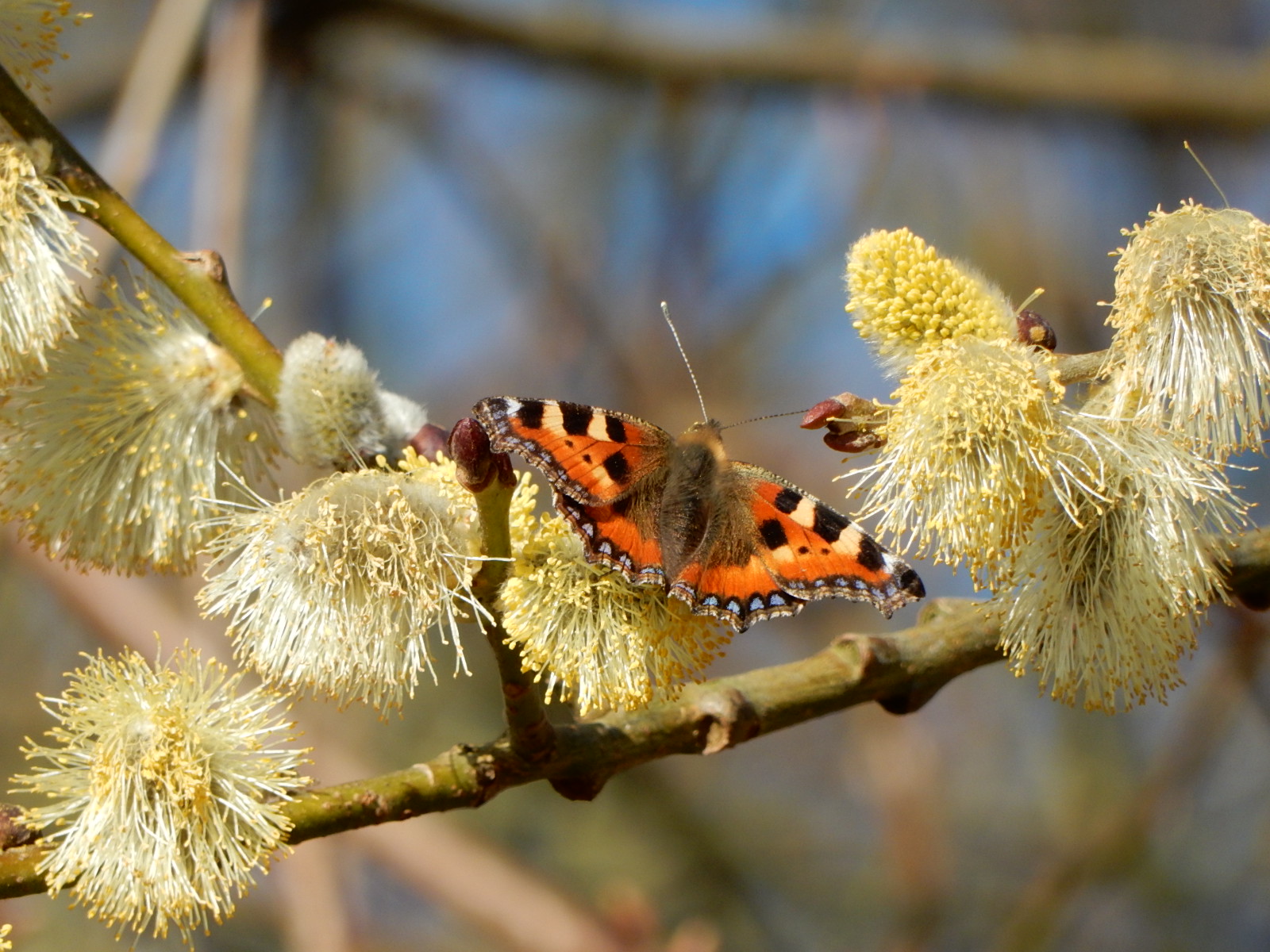
However if you live in the NE of Derbyshire you might be interested in attending a similar event that is being held on the 14th of March 2019 from 12 noon until 4.30 pm at Poolsbrook Country Park – this free event is being organised by the DWT when local enthusiasts Mark Radford and Sid Morris will be doing the training - please see leaflet for details.
Finally, due to the number of excellent photos of UK butterflies that I have received recently, I have postponed the issue of the promised South African butterflies until the next update.
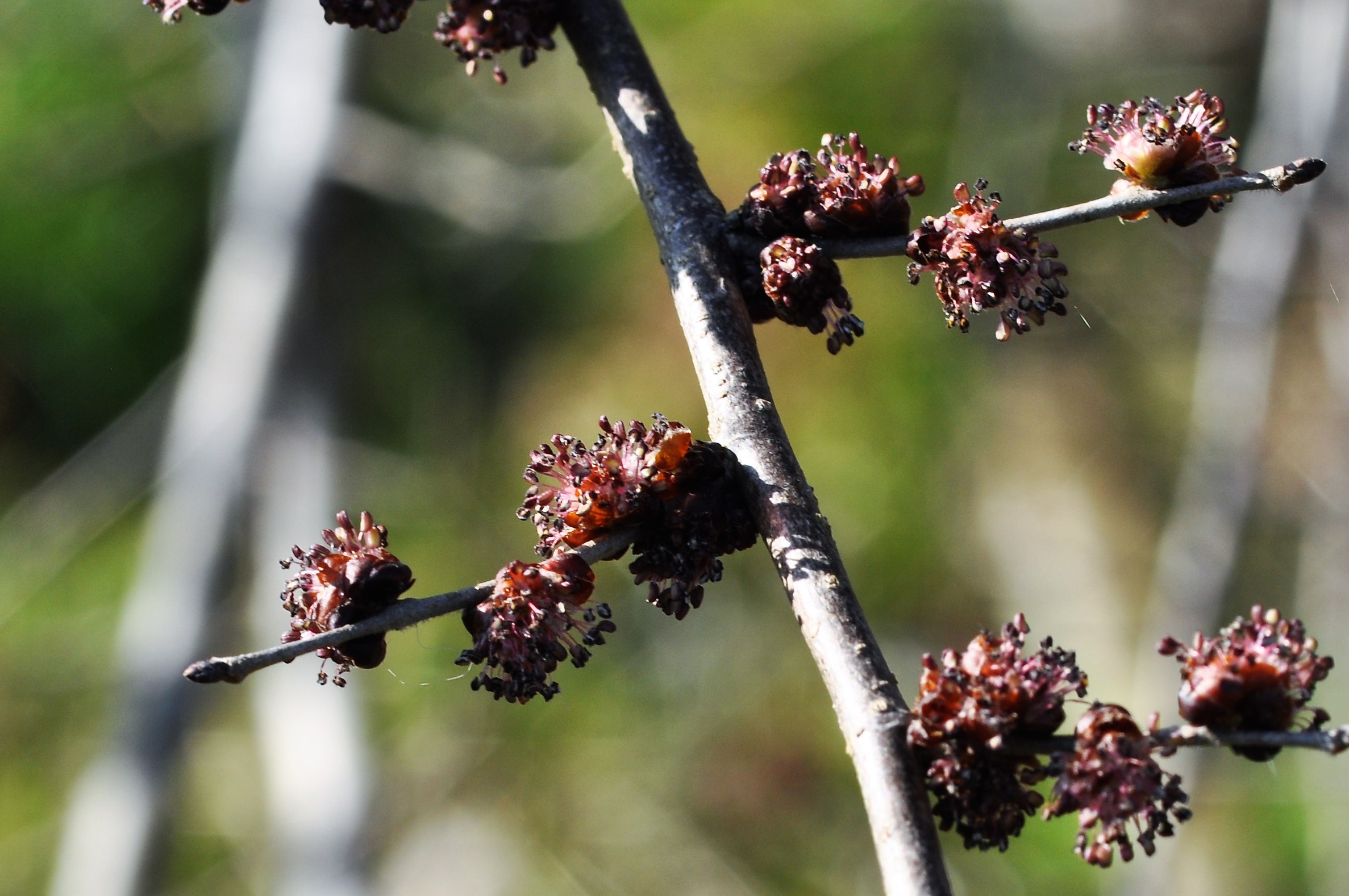
Update No 6
18th February 2019
Ken Orpe

Following on from the recent Atlantic storms, this week has seen a drastic change in the weather with spring like conditions and temperatures up to 14°C here in Derby – ideal weather for butterflies to emerge from their slumber and take to the wing. Pat and I were pleasantly surprised when we saw a Red Admiral taking nectar from snowdrops in Allestree Park on the 11th of February 2019 (see the attached photo). Then followed a week of brilliant sunny and warm days which meant that a number of observers were very pleased to see their first butterflies of the year including another Red Admiral on the 14th of February 2019 in the Little Eaton garden of Brenda Shore.
A total of 9 Small Tortoiseshells have been noted this week, 6 of which were seen in the Peak District at Thorpe (Barbara Wager), Hoe Grange Quarry (Ray Badger Walker), the Main Shopping Street in Buxton (Michael Glendenning), Birchover (Phil Gilbert), Hopton Hall (Anita Aked) and Froggatt (Bryan Barnacle), whilst the others were in the Grassmoor garden of Brian Cuttell, the Belper garden of Dan Martin and at Pleasley Pit NR (Ian Hurst). Similarly a total of 9 Peacocks have been seen recently with all of them noted in the Peak District at Hoe Grange Quarry (Ray Badger Walker), Darley Forest (John & Jessica Barker), the Buxton garden of Shirley Johnson, Biggin Dale (Roger Dennis),the Bakewell garden of Angela Bird, Gang Mine NR (Gary Atkins), Cromford Canal (Angela & Chris Bent) and remarkably at 360 metres above sea level at the top of Kinder Scout where Brian Gee saw 2 individuals enjoying a flypast on the 14th of February 2019!
Just a couple of Commas seen this week on the 14th of February 2019 with an individual noted in the Goyt Valley (David Hatfield) and another at Press Manor on the same day (John & Sandra Kidd). Also 4 Brimstones were noted recently with one seen in a Kirk Hallam garden on the 14th of February 2019 by Alison Devine (per Paul Shaw) and others on the same day in Birchover Way, Allestree (Jenny Emerson) and Ironville (per Pete Clark),which was then followed by a fourth individual in the Overseal garden of Dot & Barry Morson on the 16th of February 2019. This means that 5 butterfly species were noted in the County during the last 7 days which consisted of 26 individuals of which just 10 were noted in lowland Derbyshire compared to 16 in the Peak District and Peak fringe areas– is this the sign of things to come this year as a direct result of the summer of 2018 when the lower temperatures in the higher parts of Derbyshire resulted in more nymphalid butterflies being seen there rather than elsewhere in the county, with the exception of the Brimstone which presumably was able to reflect the heat, similar to the Whites? Only your sightings will indicate what is actually happening here in Derbyshire!
Interestingly the reservoir levels here in Derbyshire are currently about what they ought to be for the time of the year following on from the earlier rainstorms with both the Derwent Valley reservoirs (Derwent; Howden and Ladybower) and Carsington Water running at 84% capacity compared to 74% capacity at the end of 2018, and this despite the driest January for 13 years and the current dry spell of weather.
Butterfly Conservation has advised me that now that all the 2018 transect results are safely gathered in from across the UK, we in the East Midlands have retained our second place behind Hampshire and the Isle of Wight in the overall table of transects completed last year. With Derbyshire on 100 sites, Notts on 28 sites and Leicestershire on 15 sites, the East Midlands total is 143 sites with Hants/I of W on 162 and Surrey in third place on 119 – yet another great result for the 300 or so volunteers who maintain their interest and enjoy the experience of carrying out butterfly transects which helps us all to understand what is happening to our local Lepidoptera in these changing times. Did you know for example that the migrating Brown Argus was seen and photographed by Patricia Sharp on a transect along the Cromford Canal between Ambergate and Whatstandwell in July 2018 – this shows that this species is very close to linking up (again) with the Peak District version of the Brown Argus which was seen on the transect at Rose End Meadows a few kilometres away in Cromford, where the caterpillar uses Rock Rose as its foodplant as opposed to cranesbills for the migrating version.
With the new transect season just 6 weeks away from commencing again, invitations have already been sent out to many volunteers who cover the 100 sites in Derbyshire, and for those of you who organise rotas in the County, other than myself, I have attached a blank rota form together with a blank recording form for use in 2019. Also attached is an example of a casual recording form for use where an observer is making multiple sightings in the County – this can be emailed to me on a regular basis and preferably no longer than once a month so that I am aware as to what is happening in your part of Derbyshire.

Finally, to whet your appetite further, Chris & Clare Cooper of Nottingham kindly sent me some photos of butterflies seen on a recent trip to Tasmania which has only 39 species present but Chris managed to photograph 3 of them (see the attached photos). More excellent photos to come from Norman Jones who visited South Africa last year, on the next update.


Update No 5
4th February 2019
Ken Orpe

Little did the mass ramblers who trespassed on Kinder Scout in 1932 realise the effect that this would have on British Society and 87 years later we can all enjoy the walks and transects on open land both here in Derbyshire and also in most other parts of the in the UK. It was mainly as the result of the combined efforts of both ‘Mancs’ and ‘Tykes’ that 500 ramblers, led by Benny Rothman, turned up on the 24th of April 1932 at Hayfield.

They wanted to highlight the fact that walkers were denied access to areas of open countryside and the result of their actions eventually led to the passage of the National Parks legislation in 1949 and the first National Park (The Peak District) was established in the year 1951.(there are now 13 National Parks in England & Wales)
A few weeks after the ‘mass trespass’ on Kinder Scout another gathering of ramblers met at Winnats Pass near Castleton – this time there were 10,000 of them – the biggest gathering of walkers in history! Each year the Wardens and Rangers of both the National Trust and the Peak District National Park hold a walking event to mark the anniversary of the ‘mass trespass’ and this year it will be held on Saturday the 27th of April 2019 at Winnats Pass from 2 pm till 4 pm – also included are talks and live music – for details go to the National Trust website :- nationaltrust.org.uk
Another butterfly themed talk with take place on Wednesday the 17th of April 2019 when Max & Christine Maughan will give a talk on ‘Gardening for Butterflies’ for the Mid Derbyshire Badger Group at the Strutt Centre in Belper at 7.30 pm (£2 for members and £3 for visitors)
With the cold weather of mid to late January 2019 still prevailing into early February 2019 our local butterflies have not been tempted out of hibernation with no sightings at all in recent days. Indeed with 35 mornings of frost here in Derby since the beginning of October 2018 till the 31st of January 2019 the overall figure is similar to the same period during last winter when there were 36 mornings of frost in Derby. Just 10 miles north of Derby, it is a different story with Dave Evans who lives in the Peak Fringe area of Middleton by Wirksworth, who has recorded 46 mornings with frost from the beginning of October 2018 till the 31st of January 2019.

So as to retain interest in butterflies during this current spell of weather, I have attached some photos taken by Ian Hurst in Lesbos, Greece – future Updates will include photos from South Africa, South America and Tasmania – all of which have been sent to me by members of this egroup!

Finally with February being the shortest month of the year it won’t be long before March arrives and all the transect rotas will then be sorted, ready to start the new walking season on the 1st of April which this year means that every transect week starts on a Monday. If you have not already done so, could you please contact your local co-ordinator to confirm your availability so that the new rotas can be agreed – to this end I will be including a blank Rota Form and a blank Recording Form for 2019 on the next Update.


Update No 4
28th January 2019
Ken Orpe

It is not surprising that there have been no further butterfly sightings in the county during January 2019 given that we have had frosts on 12 mornings so far this month here in Derby (compared to 10 mornings in January 2018), some of them being a hard frost which meant that the maximum daytime temperature didn’t get above 3°C. It was even colder in the Peak District with lying snow adding to the very cold conditions in that part of the county.
However a lack of sightings hasn’t prevented a number of events relating to butterflies being organised for 2019 including the following:-
1. The Annual Transect Training Sessions by Pat & Ken Orpe in the offices of the Derbyshire Wildlife Trust (DWT) at Middleton by Wirksworth will take place on the following dates : – Wednesday the 6th of March 2019 from 1.30 pm to 4.00 pm. To book this free event please telephone Elizabeth Woodward on the Reception at the DWT (01773 881188) – places are limited to 30 volunteers for this event and it will be on a first come first reserved basis. If you cannot make the last date, then another has been arranged at the DWT offices at Middleton by Wirksworth – Friday the 8th of March 2019 – from 10 am to 12.30 pm – details all as the last item.
2. Wednesday the 13th of March 2019 – an illustrated talk on ‘The Butterflies of Derbyshire’ by Pete Clark at Riddings Park Community Centre, West Street, Riddings DE55 4EW commencing at 7.30 pm – entrance fee is £2, students and children free.
3. Friday the 12th of April 2019 – an illustrated talk on ‘Monitoring the Changing Status of Butterflies in Derbyshire’ by Ken Orpe at the Evergreen Club, Cornhill, Allestree, commencing at 7.15 pm for Derby Natural History Society - entrance is free to members and guests are charged at £2.
4. Hoe Grange Quarry Open Day – Sunday the 21st of July 2019 from 11 am to 4pm. Last year this event attracted over 450 butterfly and wildlife enthusiasts and it has become quite a social event with teas and free ice creams available courtesy of Longcliffe Quarries. Steve Orridge and Ray Walker will be carrying out a moth watch during the previous night (Saturday the 20th of July 2019) so we should have some live moths to show visitors on the following day.
I have been carrying out some research on Hoe Grange Quarry this month with the idea of creating an interpretation board on the history of the site and unbelievably back in the year 1902, the site was found to have bones of 27 animal species present including lion, rhino, elephant, grizzly bear, wolf, wild boar and hyena which could have been located in a den within a sinkhole some 1 million years ago – interesting that some animals still exist in the quarry including badger, rabbit, frog, redwing and robin. There is an exhibition currently at Buxton Museum on the ‘Wonders of the Peak District’ and this contains a display of some of the bones that were found in Hoe Grange Quarry all those years ago. Well worth a visit according to Ray ‘Badger’ Walker, the Warden of Hoe Grange Quarry. I have also had some help from David McPhie of the bookshop at Brierlow Bar near Buxton whereby David has confirmed that there was indeed a railway siding into the quarry off the High Peak Railway and there was also a narrow gauge system within the quarry – I understand that the lines were removed in the 1950’s when road transport became easier.
During this winter Mick Ball, Butterfly Conservation Moth Officer for Derbyshire and Notts, has been compiling a detailed summary of the current status of the ‘Moths of Derbyshire’ – if you would like a copy of his Report then please send me an email and I will forward to you a copy of the document which contains details of the status of approx 500 species of macro moths that have been recorded in the county during the last 30 years.

Finally I have attached some more photos of butterflies that members of this egroup have seen in Europe – this time they are of relatives of species that can also be found in other parts of the UK.

Update No 3
22nd January 2019
Ken Orpe


Now that we are in the midst of ‘General Winter’ with snow on many of the hills in the Peak District, I was quite surprised to receive a couple of additional butterfly sightings in the county recently with a Brimstone noted flying at Pleasley Pit NR on the 15th of January 2019 (Loz Brooks) and a Peacock seen at Clowne on the 18th of January 2019 (Marc Pearson).
As I have finished analysing the transect data for 2018, I have attached a (downloadable) excel sheet which shows the comparison for the results between 2017 and 2018 and again the Ringlet remained in poll position as the most species seen on the 100 transects carried out in Derbyshire during 2018 despite much lower numbers seen overall, no doubt due to the drought conditions on the grasslands (15,604 compared to 21,246 in 2017), whilst the Small White rose to second position from sixth in 2017 (14,385 compared to 4,104 in 2017), mainly as a result that it managed to fly during the hot weather.
Unsurprisingly the Red Admiral was the worst performer with a massive 90% decline in numbers compared to 2017 (285 butterflies against 2,808 in 2017) but the second worst performer, the Comma, was somewhat of a surprise (988 compared to 1548 in 2017 – a decline of 36%). Moving on to individual sites, the Rowthorne Trail had the most butterflies where David Elliott counted a massive 4,801 individuals on the transects there with nearby Pleasley Pit NR in second place having a total count of 3,489 butterflies thanks to Mick Gamble and his enthusiastic team of volunteers. The new transects carried out at Markham South Pit organised by Mark Radford and Sid Morris and their team did really well with a total of 4,835 butterflies seen overall at the 2 sites that are being monitored there on behalf of Derbyshire County Council. The site with the most species seen was Lathkill Dale NNR with 28 species recorded in 2018.Finally it was interesting to note that in lowland Derbyshire 33% of transect sites had fewer butterflies in 2018 whereas in the Peak District the decline was at only 16% of the sites – this being no doubt due to the fact that the higher ground of the Peak was some 4 degrees cooler than sites in lowland Derbyshire which meant that the drought in the Peak had a lesser impact on the ability of butterflies to keep flying, take nectar and hopefully find a mate – it will be interesting to see what effect that the summer of 2018 has on numbers throughout the county in 2019 – only your efforts will again produce this data!
For interest I have also attached the (downloadable) transect data for the 100 active sites in the county during the period of 2013 to 2018 inclusive and which shows that over 400,000 butterflies have been counted during this period on over 10,200 walks which averages at 39 butterflies seen on every transect in Derbyshire during the last 6 years – what a fantastic achievement by over 300 volunteers who find the experience truly rewarding and for which Pat and I thank you all so much – it is great to know that we inspire volunteers to get out and about in our great county!
Yet another set of brilliant photos by members of this egroup are attached for your continued interest in the hope that they will prevent you all from suffering the January ‘blues’ – great to see variations to our Wall Brown and the Comma from Europe!


Update No 2
14th January 2019
Ken Orpe


If we wanted further proof that climate change is upon us here in Derbyshire, it was certainly confirmed again on the 8th of January 2019 when amazingly a Speckled Wood was seen nectaring on mahonia in the Smalley garden of Stephen Jackson (per Jim Steele) – this sighting is at least 2 months earlier than the previous record (9th of March (2010)) and was totally unexpected! This could be a spin off from the exceptional summer of 2018 as this species can over winter as either a caterpillar or a pupa, so the New Year message is – expect the unexpected! What makes it all the more interesting is that despite the fact that Derbyshire is the furthest from the coast in any direction (Ordnance Survey), there have been no other sightings yet in the rest of the UK where many counties have a coast line and hence a slightly milder climate than us here in the middle of England.
Other butterfly sightings in the county during the first couple of weeks of this year include an additional Brimstone at Poolsbrook Country Park on the 6th of January 2019 (per Mark Beevers), a Peacock seen flying along the High Peak Trail near the Stone Centre, Wirksworth in poor conditions on the 7th of January 2019 (Nigel Pratley) together with another Peacock seen in the Smalley garden of Stephen Jackson on the 8th of January 2019, and finally a Red Admiral was noted in Shirebrook on the 8th of January 2019 (per Mark Beevers), this taking the species total to 5 already this year!
As we have now passed the half way mark of the close season for transect walking, arrangements have been made for the Annual Transect Training Sessions in the Offices of the Derbyshire Wildlife Trust (DWT) at Middleton by Wirksworth – Wednesday the 6th of March 2019 from 1.30 pm to 4.00 pm. To book this free event please telephone Elizabeth Woodward on the Reception at the DWT (01773 881188) – places are limited to 30 volunteers for this event and it will be on a first come first reserved basis. If you cannot make the last date, then another has been arranged at the DWT Offices at Middleton by Wirksworth – Friday the 8th of March 2019 – from 10 am to 12.30 pm – details all as the last item.
With all the data from 100 active transect sites in Derbyshire already submitted to the National Database at Butterfly Conservation and UKBMS (United Kingdom Butterfly Monitoring Scheme), it now gives me a chance to analyse our Derbyshire data – yes there was a 29% increase in butterfly numbers in 2018 compared to 2017 (104,432 butterflies seen compared to 81,030 in 2017) but if you take out the totals of the 3 ‘white’ species for 2018 (33,837 butterflies seen compared to 12,303 in 2017) then the other 29 species recorded increased by only 1,868 butterflies which is only 3%. So as expected the ‘white’ species managed to withstand the high temperatures whilst the coloured butterflies were less fortunate. Full details of how each species fared will be sent out on the next update. So a huge thank you goes out to the 300 volunteers who carried out all 2,410 transects that were walked in Derbyshire during 2018 – this represents a massive 93% total of the possible transects, against 87% in 2017.

Finally I have attached some more great photos from Dave Goddard of his trip to Bulgaria which hopefully will help you all get over the January ‘blues’.



Update No 1
7th January 2019
Ken Orpe
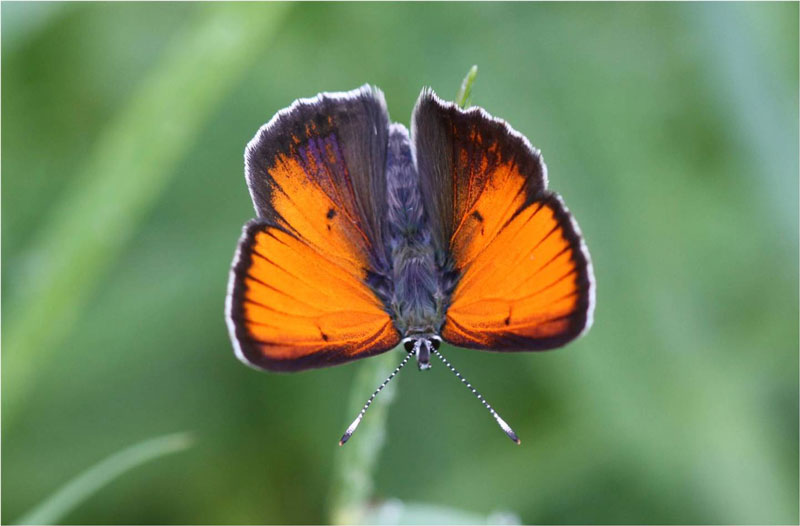

With cool overnight temperatures and mainly cloudy skies during the short hours of daylight of late, there were very few opportunities for volunteers to get out and about looking for butterflies but Mark Radford informs me that Kevin Navin saw a Peacock flying along a road in Staveley on Boxing Day 2018, whilst during a sunny spell on new year’s day 2019, Peter Burton saw a Small Tortoiseshell in full flight across the moors at the top of Heyden Clough on the Derbyshire side of Holme Moss at an elevation of 1600 feet above sea level – so the 2019 season has already started on the 1st of January (the same species was also seen on the first day of the New Millennium in the County).
Meanwhile over in North Notts, on the 1st of January 2019 Phil Lee saw a Peacock on the wing at West Stockwith. The next time that the sun briefly appeared in the area was Sunday the 6th of January 2019 but it was sufficient for another Peacock to appear, this time at Brimington, which was seen by Alan Wood (per Sid Morris) and also surprisingly on the same day a Brimstone was seen flying at Markham North Pit by Mark Radford. With more sun forecast for tomorrow (8th of January) it could be that we get further sightings of additional butterflies in the county.

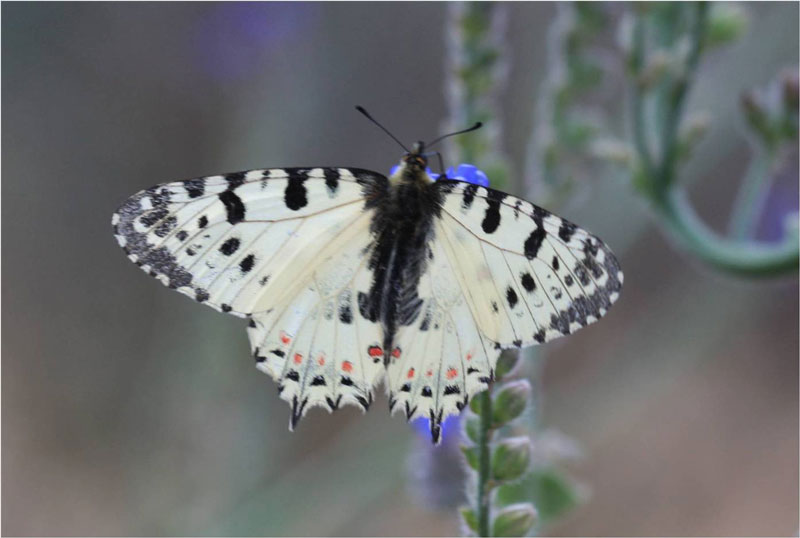
Pleasingly yet more amazing photos of butterflies have been sent to me by members of this egroup – many people are pleased to share butterfly photos of their far away trips which include eastern Europe, South Africa and even Tasmania. So limiting the attachments to 6 photos, here are some great shots from Dave Goddard of his trip to Bulgaria – enjoy on these dismal days of January!



